





5 YEAR LIMITED WARRANTY applies to qualifying purchases of Suzuki outboard motors sold and delivered to the retail purchaser, for pleasure (non-commercial) use only, from April 1, 2021 through March 31, 2022. See Suzuki Limited Warranty for additional details. Suzuki, the “S” logo, and Suzuki model and product names are Suzuki Trademarks or ®. Don’t drink and drive. Always wear a USCG-approved life jacket and read your owner’s manual. © 2021 Suzuki Marine USA, LLC. All rights reserved. A BIGGER COOLER YOU’RE GONNA NEED HOOKED ON™ SUZUKI TECHNOLOGY SZ Q4 CSTL FSHNG W BOX 1 PG 9-13-21.indd 1 9/13/2021 2:46:43 PM 251.968.2628 6940A HIGHWAY 59 | GULF SHORES, AL 36542 HWY 59 @ COASTAL GATEWAY BLVD. 2 March 2023 // GreatDaysOutdoors.com // 877.314.1237


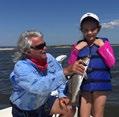
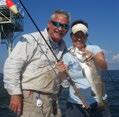









INSHORE GUIDE SERVICE Mobile Bay + Mobile Delta + Dauphin Island 3 TIME ALABAMA INSHORE TRAIL CHAMPION MULTIPLE REDFISH TOUR WINS USCG LICENSED 35 YEARS EXPERIENCE Capt. Bobby Abruscato (251) 661-7696 www.ateamfishing.com A-Team Fishing Adventures 8 LOCATIONS TO SERVE YOU DIXIESUPPLY.COM Eight Mile, AL • Theodore, AL Meridian, MS • Summerdale, AL BAKERMETALWORKS.COM Troy, AL • Baker, FL Fountain, FL • Cantonment, FL METAL ROOFING & SIDING | 20 COLORS | 29 & 26 GAUGE | 5 PROFILES YOUR METAL ROOFING HEADQUARTERS 877.314.1237 // GreatDaysOutdoors.com // March 2023 3





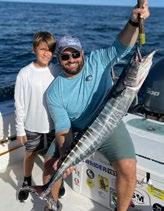
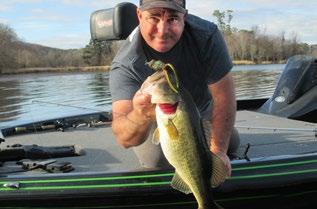
HUNTING & FISHING IN ALABAMA & THE FLORIDA PANHANDLE CONTENTS Best Bets 6 by William Kendy Camphouse Kitchen . . . . . . . . . . . . . . . . . . . 58 by Hank Shaw New & Cool Gear for Outdoorsmen 60 by William Kendy From the Commissioner . . . . . . . . . . . . . . . . 62 by Chris Blakenship From the Director 64 by Charles Sykes Paddle Fishing . . . . . . . . . . . . . . . . . . . . . . 66 by Ed Mashburn Coastal Outlook . . . . . . . . . . . . . . . . . . . . . 68 by Chris Vecsey Pier & Shore 70 by David Thornton Regional Freshwater . . . . . . . . . . . . . . . . . . . 72 by Ed Mashburn Prime Feeding Times, Moon, Sun, and Tide Charts . . . . . . . . . . . . . . . . . . . . . 76 Pensacola Motorsports Trophy Room . . . . . . . 80 Great Days Kids Corner 82 Fishing Tips 85 by William Kendy A Great Day Outdoors . . . . . . . . . . . . . . . . . . 86 by Jim Mize In Every Issue 20 8 How to Fish Topwater Frog Lures for Bass . . . . . . 8 by John E. Phillips Wahoo Fishing Tips and Tricks 12 by Frank Sargeant Choosing the Best Turkey Shotgun 2023 . . . . . . . . 16 by Nick Williams Catching Big Gray Triggerfish 20 by Ed Mashburn What to Look For When Buying a Used Boat . . . . . 24 by David Strickland Wet-Aged vs Dry-Aged Venison 28 by Josh Honeycutt Long-Lining vs Side Pulling vs Spider Rigging for Crappie . . . . . . . . . . . . . . . . . . 32 by Greg McCain Land Loan Interest Rate Update 35 by Great Days Outdoors Staff Choosing the Best Sabiki Rig to Make Bait . . . . . . 36 by David Thornton Picking the Best food Plot for Deer in Spring and Fall 40 by David Strickland How To Improve Wild Turkey Habitat with Trapping 46 by John E. Phillips How to Stock F1 “Tiger Bass” in your Pond . . . . . . 50 by William Kendy Squirrel Hunting with the Experts . . . . . . . . . . . . 54 by John E. Phillips 12 46 28 4 March 2023 // GreatDaysOutdoors.com // 877.314.1237
Soggy Bottom LodgeWorld Class Hunting Fishing & Shooting Resort Marengo County, Alabama, 1,224+/-Acres

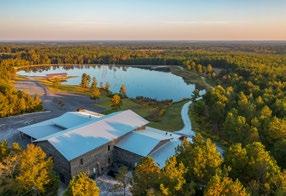
• Perfect for a family retreat and commercial hunting, fishing, and event business
• Hunt monster bucks, elk, fallow deer, ducks, quail, pheasant, turkey, and dove

• Fish multiple large, trophy managed lakes
• Network of large, year-round food plots with shooting houses
• Duck ponds with blinds
• Miles of paved or improved internal roads
• 2 custom lodges

• The Soggy Bottom Lodge sleeps up to 18 with 3 expansive bedroom suites, en suite bathrooms, a commercial kitchen, an open dining room, game room, and den, and just outside is an outdoor kitchen and dining area that can seat up to 40
• Shack 33 features 7 guest bedrooms and 39 beds, a private master suite with spa, commercial kitchen, dining area for 40+, and a game room with bar. The massive porch seats 80+ and has a hibachi grill, flat top, a large built-in grill and fryer, and outdoor fireplaces
• Other amenities include an event pavilion, 8.75+/- miles of game fencing, 20+/- acre breeder pen, equipment barns, feed barn, concert stage, multiple shooting ranges & courses, continental pheasant shoot tower, and diverse, merchantable timber throughout including pine plantations and scenic hardwood, contributing to its significant conservation easement opportunities.
® Alabama Listings Autauga Autauga Autauga Autauga Autauga Baldwin Baldwin Baldwin Baldwin Baldwin Barbour Barbour Barbour Barbour Barbour Bibb Blount Blount Blount Blount Blount Bullock Butler Calhoun Calhoun Calhoun Calhoun Chambers Cherokee Chilton Chilton Chilton Chilton Chilton Choctaw Choctaw Clarke Clarke Clarke Clarke Clarke Clay Cleburne Cleburne Coffee Colbert Colbert Colbert Conecuh Conecuh Conecuh Conecuh Coosa Covington Covington Covington Covington Covington Crenshaw Crenshaw Cullman Cullman Dale Dale Dale Dale Dale Dallas Dallas Dallas Dallas Dallas Elmore Escambia Escambia Escambia Fayette Franklin Franklin Geneva Geneva Geneva Greene Greene Greene Greene Hale Hale Hale Hale Hale Henry Henry Henry Henry Houston Houston Houston Houston Houston Jefferson Jefferson Jefferson Jefferson Jefferson Lamar Lamar Lamar Lamar Lamar Lauderdale Lauderdale Lauderdale Lauderdale Lauderdale Lee Limestone Limestone Lowndes Macon Macon Macon Madison Marengo Marengo Marengo Marengo Marion Marion Marion Mobile Mobile Mobile Mobile Mobile Monroe Monroe Monroe Monroe Monroe Montgomery Montgomery Montgomery Montgomery Morgan Perry Perry Perry Pickens Pickens Pickens Pickens Pickens Pike Pike Pike Pike Randolph Russell Saint Clair Saint Clair Saint Clair Saint Clair Saint Clair Shelby Shelby Shelby Shelby Shelby Sumter Sumter Sumter Sumter Sumter Talladega Talladega Talladega Talladega Tallapoosa Tuscaloosa Tuscaloosa Tuscaloosa Tuscaloosa Tuscaloosa Washington Wilcox Winston COUNTY ACRES COUNTY ACRES COUNTY ACRES COUNTY ACRES FL Panhandle Listings 373 80 75 59 48 530 518 445 315 110 215 160 94 42 3.42 180 608 438 315 225 211 105.5 406 22.5 20.8 18 1.4 12 2 273 256 58.27 4.34 2.88 1077 30 620 100 92 66.42 51 110 149 25 147 72 18 1 355 119 112 40 430 1040 700 276 274 139 276.5 160 117 8 406 227 75 61 35 740 430 160 21 2 297 290 117 4 135 64 25 397 104 80 150 120 40 10 288.5 258 186 140 80 85 80 57 57 312 69 55 38 13 227 202 180 136 86 370 194 165 143 45 25 23.15 6.8 5.06 5.06 132 7.25 6.83 50 800 185 18.5 11 1224 853 548 507 200 104 96 399 340 271.83 260 201 140 94 40 11 1 640 84.4 65.8 3 20 330 70 64 430 217 180 121 110 44 33 15 9.2 178 76 96 83 40 20 13 221 151 133 110 87 412 145 141 130 128 25 13 8.5 1.01 159.04 800 600 303 281 200 564 10 2.3 Santa Rosa Washington Jackson 41.83 160 1
COUNTY
877.314.1237 // GreatDaysOutdoors.com // March 2023 5
Over 700 more tracts across 47 states available...
ACRES
BEST BETS FOR MARCH
These are our top targets for hunters and fishermen this month!
BY WILLIAM KENDY
MARCH IS SPELLED “P-O-M-P-AN-O”
On the Alabama Gulf coast for saltwater anglers, it is all about pompano. Of course, Mother Nature has a little bit to do about it but if she cooperates and the water temperature is right, the tasty pompano will start their migration.
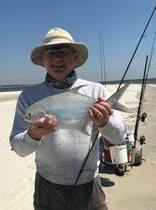
Since pompano are crustacean munchers, sand fleas followed by shrimp top the menu. On the artificial side Fishbites are a top choice. For fishing the surf, a 10–11-foot medium/medium heavy spinning rod with a 5000-class reel spooled with 20-pound line works. You want something capable of handling a three-to-five-ounce sinker and a multi-hook pompano rig.
Pompano can be caught 15-20 yards from the beach and utilizing a 8 ½ - 9 foot medium spinning outfit with a little backbone casting bait, Fishbites or even spoons can be productive.
CRAPPIE SPAWN GETS UNDERWAY IN MARCH
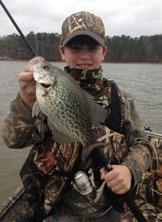
Once the water temperature gets into the mid 60’s to low 70s, crappie will start to move into their spawning mode. For southern Alabama that means mid-March or so. Prior to that they will feed heavily on small minnow and threadfin shad and spawn or no spawn, anglers who fish around weeds and submerged brush and structure with minnows or small jigs with soft plastic tails an inch or two long can fill their coolers.
Most anglers use 8–10-pound test while fishing minnows but lighter gear in the 2–6-pound test area fished slow with light jigs may entice reluctant crappies to take a bite. No matter what your technique, be it “shooting docks” with small jigs or utilizing a jig and cork combination, go fishing.
MARCH KICKS OFF TURKEY SEASON

The opener for the Alabama 2023 turkey season is March 25th and it sure doesn’t hurt to spend some time in the woods to scout and try to pattern the birds. Do some “boots on the ground” roaming on logging roads, two tracks and trails, listen for gobbling and look for turkey droppings. Just like you do for deer season, depending on what your scouting has turned but, set up likely ambush areas. Dust off your turkey calls and, if you use a mouth call, annoy your family and buddies by practicing (guaranteed to get you alone time).
Speaking of patterning, it doesn’t-Edited hurt to take “Old Betsy” out and do some shooting at different distances to see how your shotgun is patterning with different loads and even chokes.
PUBLISHED BY: Great Days Outdoors Media, L.L.C.
PUBLISHER/EDITOR-IN-CHIEF: Joe Baya
EXECUTIVE EDITOR Butch Thierry

MANAGING EDITOR: William Kendy
GENERAL MANAGER: Samatha Hester
CREATIVE DIRECTOR: Wendy Johannesmann
DIRECTOR OF DIGITAL MARKETING Jarod Bosarge
Great Days Outdoors (USPS 17228; ISSN 1556-0147) is published monthly at P.O. Box 1253 Santa Rosa Beach, FL 32459 Subscription rate is $30 for one-year, $54 for two-years, and $72 for three-years. Periodicals Postage Paid at Mobile, Ala. and additional mailing offices.
POSTMASTER: Send address changes to Great Days Outdoors Media, LLC PO Box 460248 Escondido, CA 92046
SUBSCRIBERS: All subscriptions begin the first issue for the month following receipt of payment, if payment is received by the 15th. Great Days Outdoors assumes no responsibility for delivery after magazines are mailed. All delivery complaints should be addressed to your local postmaster.
CONTACT US:
EDITORIAL | JoeBaya@greatdaysoutdoors.com
ADVERTISING | SamHester@greatdaysoutdoors.com
SUBSCRIPTIONS | greatdaysoutdoors@pcspublink.com
Great Days Outdoors Media LLC PO Box 460248 Escondido, CA 92046 877. 314. 1237 info@greatdaysoutdoors.com www.greatdaysoutdoors.com
All rights reserved. Reproduction of contents is strictly prohibited without permission from Great Days Outdoors Media, LLC.
WWW.FACEBOOK.COM/GREATDAYSOUTDOORS
WWW.TWITTER.COM/TEAMGREATDAYS
WWW.INSTAGRAM.COM/GREATDAYSOUTDOORS
VOLUME 27 ISSUE 3 MARCH 2023
BEST BETS 6 March 2023 // GreatDaysOutdoors.com // 877.314.1237
FERTILIZING
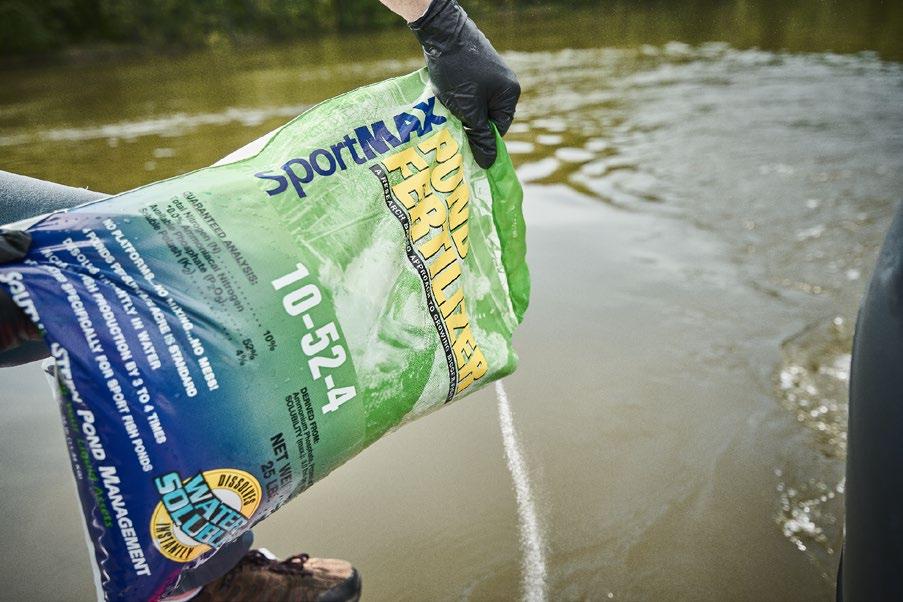
877.314.1237 // GreatDaysOutdoors.com // March 2023 7
Pictured is the new LiveTarget Ultimate Frog from Mustad that should be on the market sometime this spring .

8 March 2023 // GreatDaysOutdoors.com // 877.314.1237
How to Fish Topwater Frog Lures for Bass
BY JOHN E. PHILLIPS
Frog fishing tends to produce the biggest bass during the hot summer months.
Bass anglers everywhere know how successful frog fishing for bass is, primarily from July until mid-November. Mustad has created a new frog lure that promises to be one of the best ever.
MUSTAD’S LIVETARGET ULTIMATE FROG
According to folks who have fished this new lure, the Ultimate Frog, composed of hybrid hard and soft components, is so realistic-looking that a bass almost must bite it.
Great Days Outdoors spoke with Bret Amundson, a digital content creator, photographer, and videographer behind FISH HUNT FOREVER. He hosts the “Prairie Sportsman” TV and radio programs and has fished a prototype of the Ultimate Frog.
“This lure features lifelike colors in a frog’s body size. Designed to fish several ways, you can: fish it underwater; cause the frog’s legs to make long or short strides; do short twitches with it; and/or fish the lure dead-still,” Amundson said.
“The body is made of a hard ABS plastic that allows you to fish this frog with an exposed Mustad super-sharp hook on its top in heavy cover. The unique features include each frog’s leg having a durable and tough drift sock,” he explained. “While retrieving the frog, the drift socks fill-up with water, causing the legs to extend just like a live frog’s legs do when swimming. As you pause the frog, the legs move back to the body of the lure, which is their natural resting position. The legs each have a spring and a hinge that bring the legs forward when the frog stops. The frog sitting still has its eyes and nose above water, and its legs retract back into the body like a live frog’s legs will.”
The LiveTarget Ultimate Frog comes in two models - the Finesse Stealth and a Popper with rattles inside that sound off when the lure’s popped and calls bass to it. Two sizes of the Ultimate Frog available are a 2-inch and a 2-1/2 inch model. Amundson explained that bass fishermen will want to learn to fish this frog, see how it moves and understand why it is the most-lifelike, versatile frog on the market.
BASS GUIDE PHILLIP CRISS
Phillip Criss has been frog fishing on rivers and lakes for 40 years and guides on north Alabama’s Lake Guntersville that’s been ranked by Bassmaster as one of the five best bass lakes in the U.S. Anglers will tell you that Guntersville’s awesome bassing starts with the grass.
“A brand-new frog that’s highly successful in the grass has come to
the marketplace that I can’t wait to try – Mustad’s LiveTarget Ultimate Frog,” Criss reported. “From what I’ve read about its capabilities, I’m anxious to get one and see if it’s as good as everyone says.”
But until that new lure’s available, Criss will use a wide variety of other frogs in grass to catch bass. About 75% of Criss’ bass caught with frogs weigh 2-plus pounds. He’s had a client catch an 11.2-pound bass on a frog, as well as several customers who have caught 9-10 pound bass with frogs.
WHY GRASS PRODUCES BIG BASS
Lake Guntersville homes several species of grass, but eel grass impacts Guntersville bass the most. It comes to the surface in the summertime, blocks the sunlight from reaching the bottom of the lake’s bottom and then begins to die-off, providing plenty of forage for the bluegills and shad, as well as adding oxygen to the lake.
“When Guntersville bass fishing is good, the grass appears to have burnt cheese on its top,” Criss explained. “We shut-off our large engines and listen for smacking and/or popping sounds under the grass produced by the bluegills and shad feeding.”
WHEN FROG FISHING’S BEST IN GRASSY LAKES
“I’ve learned that the most-productive time to fish frogs is Augustwhen the temperatures are 90 – 100+ degrees, the gnats are crawling all over your body - in your ears and up your nose - and you must wear a headnet over your face,” Criss reported. “Frog fishing in August is the most-aggravating time you can bass fish but does pay-off.”
Criss usually starts frog fishing in July, or whenever the grass mats begin to die-off. This pattern will last through October and sometimes until mid-November. Once you no longer can see grass on top of the water, the frog-fishing season for bass has ended.
WHY CUT LANES IN THE GRASS
Criss and other anglers don’t just fish the grass’ edges but often motor their boats deep into the grass. They’ll trim their big motors up, so the blades are barely under the water or halfway out of the water. They’ll cut straight channels about four-feet wide and four feet deep in the grass with their engines on either side of the main channel they’ve located with their depth finders’ bottom-contour maps. However, they must keep their large engines deep enough in the lake to not lose water pressure to the motors.
FISHING 877.314.1237 // GreatDaysOutdoors.com // March 2023 9
Phillip Criss, pictured here, cuts lanes through the thick grass to reach places to catch big bass where most other anglers won’t or can’t fish.
“Sometimes we’ll cut zig-zag lanes, 2-10 feet deep, in the back channels where a ridge is between the edge of the grass and the bank,” Criss mentioned. “When you move upriver, a whole creek or perhaps hundreds of acres may be covered completely with grass.”
WHEN TO FISH EACH FROG TYPE
Once the grass first appears on the surface, not all of it shows-up at the same time. That’s when Criss fishes a frog with a buzzbait propeller on its front, a lure that’s easier to use in scattered grass and open water. Once the grass finally mats-over the surface of the water, anglers change to a hollow-body frog that sits on top of the grass and can be fished in the holes in the grass. You also can use a ribbit-type frog – a solid-body, soft plastic that you swim on the outer edges of the thinner grass or cast deep into the grass and walk or hop it on top of the grass. It works better than the buzzbait or the hollow-body frog.
“The bass under thick grass have the least amount of fishing pressure as compared to the bass holding in the lake’s more-open areas,” Criss said. “For frog fishing to be effective, you need to cast deep into the grass, where the water only may be two feet deep. We love frog fishing for bass in places where an entire slough or a bay is covered in grass, perhaps 10 – 60 acres.”
“You must switch your tackle when fishing for large bass deep in the grass with frogs,” Criss said. “I use 65-pound test, braided line tied to the eye of the frog. Once we begin fishing the lanes we’ve made in the grass, we’ll cast all the way around the grass and either drag, hop and/ or skip a frog in every direction. We’ll fish popping frogs if there’s enough open water, so that the frogs, when we jerk them, will pop and spit water. If the grass is very thick, we’ll fish hollow-bodied frogs and drag them across the tops of the grass, stop them and then repeat.”
* Watch the Frog:
When fishing a thick mat of grass, focus on the frog, and twitch the frog several times. Criss estimates that he can spot the bass coming to eat the bait about 70% of the time because the grass behind the frog will hump-up and resemble a wave coming toward the bait. Or, the bass will create a bowl-type whirlpool around the frog to clear the grass away from the frog. Then when the fish attacks, it’ll likely get far less grass in its mouth and be able to eat the frog.
*Find a Blowhole
A blowhole is an opening in the grass. I’ve learned that retrieving the frog over the blowhole’s side rather than through its center enables me to get more bites and catch more bass. But exceptions exist to every rule of bass fishing,”: Criss said. *Frog fish in bright sun, with high barometric pressure in very-hot weather.
*Identify a Frog’s Best Color Pattern:
“The color of the frog is probably more important to the fisherman than to the bass,” Criss emphasized. “A bass that’s looking at a rubber frog sees only its belly. On bright days, I like a frog with a white, a yellow, a yellow-and-black or a solid-black belly. I prefer to fish a black-belly frog on overcast, cloudy and/or rainy days but also may fish a white belly.”
Criss believes that bass under the grass, feeding on bait fish, are responding more to the motion of the kicker legs or hearing the frog rather than noticing the frog’s color.
*Realize Glass Beads and Brass Make a Difference
Sometimes Criss puts glass beads and a small amount of brass inside a hollow frog to cause the back end of the frog to sink down to the point where only its head’s out of the water which is the way most frogs sit on the water if they’re not on grass’ top. The brass and glass beads inside a plastic frog make a clacking sound when the frog’s moving. Criss reports that on some days, a hollow-body frog with rattles may receive 10 times more bites than without the rattles.
*Understand the Difficulty of Hooking a Bass When Frog Fishing
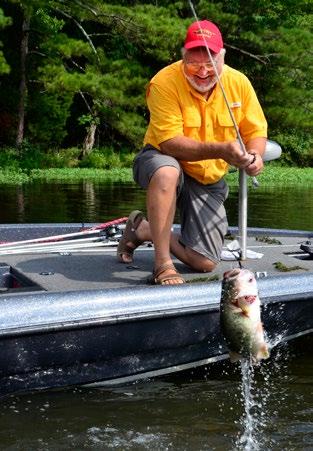
To catch a bass on a frog and not miss the fish, first, you need to feel the bass pulling on your line before you set the hook, “If the bass blows-up on the frog, count to two, and set the hook. Don’t try to set the hook the instant you feel or see the bass attack. Patience is one of the most-difficult skills to develop and use once a bass takes a frog from under the grass,” Criss said.
WHAT FROG TACTICS CATCH BIG GRASS BASS
*Change-Up Your Tackle
How to Fish Topwater Frog Lures for Bass 10 March 2023 // GreatDaysOutdoors.com // 877.314.1237
Catching numbers of bass, 2+ pounds or better, is a great day of frog fishing, and you may miss just as many bass as you hook-up
*Use the Proper Frog-Fishing Equipment
Criss likes to fish a long, heavy or extra-heavy rod, particularly a Duckett Fishing rod with a fast tip that many people will match with a 10:1 reel. However, Criss prefers a 7.1:1 wide-spooled reel.
“You can use regular-sized reels, but investing in a wide-spooled reel to use when frog fishing is a better choice. If the bass immediately goes down in the grass, you’ll not only have to pull the bass up, but also about 20 pounds of grass. Pulling the bass and the grass, as heavy as they both are, will pull the braided line down into the line on the spool, creating a backlash on your next cast. Luckily, you can eliminate that aggravation by using a wide-spooled reel. I think one of the best ones is the Super Duty Lew’s 7.1:1 gear ratio reel with about 12-15 pounds of drag.”

One of the main reasons that frog fishing tends to produce more and bigger bass during hot summer months is because bass under the grass receive the least amount of fishing pressure and have the most food to eat and ideal cover to attack bait.
You can go to https://www.youtube.com/ watch?v=oiC1ZmG98SE to learn more about fishing the Ultimate Frog.
SUPPORTING THE LOCAL ECONOMY & ECOLOGY
Admiral Oysters are now available for retail by the dozen at Bon Secour Fisheries, Inc. in Bon Secour, Alabama. Fresh, raw oysters can elevate any event. From a simple, nutrient dense appetizer at home to a shucking party with friends, Admiral Oysters will steal the show. Call 251.949.7411 for pricing and availability

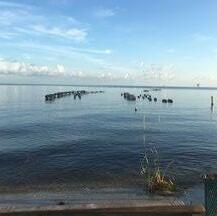
Oysters grown at our farm are consistent in size and flavor profile. Frequent handling and wave energy at our unique location creates a sustainable environment in which our oysters thrive. This combination results in the perfect half shell presentation of the Admiral Oyster.
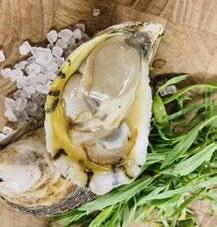
We are located near Fort Morgan AL, in an untouched wild stretch of beach that will be immune from development. The site has witnessed centuries of history including the Battle of Mobile Bay as Admiral Farragut charged into the Bay with the iconic line “Damn the torpedoes, full speed ahead”. That motto comes in handy on cold rainy mornings and when the winds get high! Visit Us at AdmiralShellfishCompany.com

How to Fish Topwater Frog Lures for Bass
Phillip Criss 205-461-5549
Duckett Fishing https://www.duckettfishing.com/ Lew’s Fishing https://www.lews.com/ Mustad https://mustad-fishing.com/us Contact Information
877.314.1237 // GreatDaysOutdoors.com // March 2023 11
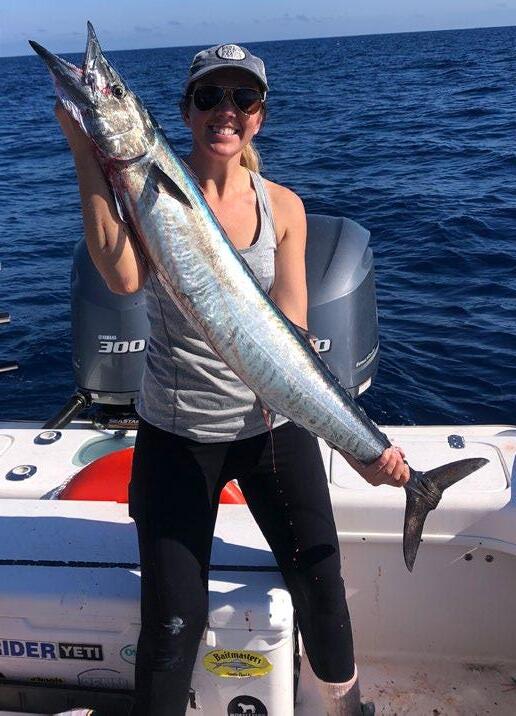 This one is headed for the grill—wahoo are among the best tasting of all pelagic species .
This one is headed for the grill—wahoo are among the best tasting of all pelagic species .
12 March 2023 // GreatDaysOutdoors.com // 877.314.1237
Photo by Captain Adam Peeples
Wahoo Fishing Tips and Tricks
BY FRANK SARGEANT
If you’ve never seen smoke fly off the spool of a reel, chances are you’ve never caught a wahoo.
Of course, the “smoke” is usually actually water vapor off the line, but with the spool spinning at up to 60 mph on the first run of a hooked “hoo”, the cloud that forms over the reel can be awesome.
Wahoo are in the mackerel family and similar to king mackerel in body shape, but the snout is more pointed and their coloration is silver-blue with dark stripes. Their mouths are larger than kings and their teeth are even more pronounced. Wahoo are made for shearing other fish in half.
They get much larger than kings, as well, with lengths approaching seven feet and weights to 180 pounds, though fish in the 20 to 60 pound class are much more common. The current IGFA all-tackle record is 184 pounds, caught out of Cabo San Lucas on the Pacific Coast—the same species swims in the tropic portions of the Atlantic and Indian Oceans according to NOAA Fisheries.
They’re primarily a bluewater species, found outside or on the edge of the green-water zone that covers much of the continental shelf of the southeastern U.S. They’re basically a tropic species, rarely venturing into water colder than 70 degrees.
Wahoo live hard and die young and most have a short life span which is about five or six years but they can reproduce at about one year old. They’re primarily found at or near the surface, though they frequently relate to underwater structure at depths of 150 to 450 feet below.
There’s not a huge commercial harvest because there’s usually no quick way to catch a bunch of wahoo. NOAA Fisheries reports only about 59,000 pounds of Atlantic wahoo are harvested by commercial fishers annually. There is no size limit for recreational anglers in federal waters, but the bag limit is two per person per day.
Wahoo are usually an incidental catch for anglers trolling for marlin and tuna in blue water. High speed trolling is a common tactic, pulling trolling heads or solid composite lures at speeds to 18 knots (over 20 mph!) to draw the strikes, which as you can imagine tend to be impressive at that speed. They can also be caught free-lining or bump-trolling live baits like bullet bonito at times.
Captain Adam Peeples of One Shot Charters in Fort Walton Beach, Florida, (www.oneshotcharters.com) fishes the waters off north Florida and Alabama almost daily year round, and regularly puts big wahoo in the boat. Here are some tips he shared with GDOD:
1. It’s often best to view wahoo as a bonus fish
“We usually set up and troll for them on our way out to swordfish and marlin grounds and on the way back. They can be hard to find if you go looking
for them, and when conditions are wrong you could troll all day and burn a lot of fuel and never get one—or you could get a dozen—you never know,” Peeples said.
(Peeples added that on one memorable December trip this year, he hit a huge school of wahoo on a break line, so many that they were skyrocketing like king mackerel, and could be caught by simply casting a jig at visible pods of fish swimming around the boat!).
2. Find the right conditions and you find the wahoo:
“We look for wahoo in water 70 degrees and over. There are often good numbers of them just outside that 70 degree break in February and March,” Peeples noted.. “Keep an eye on that temperature gauge in winter, and use the offshore temperature and current services to find where to look. Sometimes all it takes is half a degree, although it’s much easier if you have a bigger break, three degrees or so.”
(Writers note: Many pro skippers make use of Hilton’s RealTime Navigator at http://realtime-navigator.com to check not only water temperatures but offshore currents, upwellings and other offshore conditions that concentrate gamefish. Current breaks or color changes are also likely areas to investigate, both for wahoo and other bluewater species).
3. Fish the right depths
“We catch most in over 200 to 450 feet of water, often where there’s either a drop in the bottom, a reef or maybe oil industry structure, something to concentrate the bait. Trolling aimlessly out there rarely does any good for wahoo,”Peeples said.. “Out of Fort Walton Beach, we usually fish the edge of the shelf, the Knuckle and the Nipple.”
In general, bottom structures that may cause upwellings from current moving over them are likely spots for wahoo, sometimes in water as shallow as 100 feet, but usually deeper during the winter months when inshore water is too chilly for this tropic species.
4. Pull the right lures
“We pull Iland Islander lures a lot. You want a lure that tracks straight and stays in the water but just under the surface, catching air now and then. Adjust the line length until you get good action, and put a trolling lead on there to keep the lure in the water if you need to,” Peeples said.
“Other lures that expert ‘hoo’ anglers like include the Black Bart Wahoo Candy, Yo-Zuri Bonita, and Nomad Madmac. The lures must be rock hard to withstand the tremendous bite pressure and razor-like teeth of the wahoo, and also have to run true at speeds to 18 knots. Many lures won’t even stay in the water at that speed,” he noted.
5. Rig right
“Wahoo have really sharp teeth, so you need 400 to 500 pound steel cable to the lure to prevent cutoffs. Some of the lures cost $40 or more so you
FISHING 877.314.1237 // GreatDaysOutdoors.com // March 2023 13
don’t want a bunch of them cut off. The wire might cut down on marlin strikes but if you’re around wahoo, you need it,” Peeples explained. “You might get lucky now and then and land one on heavy mono, but if you’re after wahoo, go with cable or wire because those teeth are really sharp.”
6. Put out a spread
According to Peeples, he catches wahoo anywhere from way back on the riggers to right in the wake, so he usually puts out a spread covering the whole range.
“The most important thing is to have the lure running right, more than how far from the boat it is,” he said. “Our boat is your biggest fish attractor out there, and they’re not afraid to bite right at the transom, so don’t omit that short line.”
7. Don’t use tackle that’s too heavy
“We set up our trolling tackle to be a compromise so that it’s not so heavy it beats up the angler but it’s heavy enough to maybe land that occasional blue marlin that hits the lures,” Peeples explained.. “We use 30 wides for most everything, with 300 yards of 50 pound mono topshot, and hollow-core backing that allows me to put another 600 yards on the reel so I’m sitting around 900 yards. I can chase a marlin if I have to and keep up with her if I have to with that much line. We’ve landed plenty of blue marlin on that setup, and it’s just right for the wahoo, too.”
8. Where you catch one there’s probably another:
“If you catch one on a spot, there are probably some others around. They don’t school like kings but there might be three or four together so we make several passes over any area where we put a wahoo in the boat. If we pull for 30 minutes and don’t get bit again, we move on,” Peeples said.
9. Treat the fish right for best taste
“Killing the fish as soon as it’s onboard, bleeding it and getting it on ice are a big part of enjoying one of the best-tasting fish in the sea. “Bury the fish in ice,” Peeples said. “Don’t just flop it in there on top or half the fish won’t be preserved the way it should be.”
He also notes that on larger wahoo and other species, it’s a good idea to gut the fish and ice the body cavity, cooling it inside and out for best flavor.

10. Cooking Wahoo—Simple is Best
Wahoo flesh turns white when cooked, and is juicy, tender and delicious. Best way to cut it up is usually to steak it, cutting into one inch thick slices. For cooking, simpler is better: brush on a bit of melted butter, grill those slices until a fork goes through the meat easily, add a squeeze of lemon, then enjoy.
Mushroom Fried Rice

Prep: 20 mins • Cook Time: 10 mins
Ingredients
• Total: 30 mins
• 1/2-pound fresh mushrooms (see above)
• 2 cloves garlic, sliced thin
• 1 to 3 small, hot chiles, like Thai, pequin, arbol or Tabasco
• 1 tablespoon grated ginger
• 3 tablespoons lard, peanut oil or rice bran oil
• 3 cups cooked, cold rice
• 2 eggs, lightly beaten
• 2 tablespoons chopped chives or green onions
• 1/2-pound asparagus, sliced on the diagonal into bite- sized pieces
• 2 tablespoons cilantro or rau ram

• 2 tablespoons soy sauce
• 1 tablespoon sesame oil (optional)
Instructions
1. Slice or break apart the mushrooms into bite-sized pieces. Heat a wok or large pan over very high heat until the pan is quite hot. Add the mushrooms and stir fry until they give up their water, which will take a couple minutes. NOTE: If you are using rehydrated mushrooms, this won’t happen, so move to the next step after 30 seconds or so.
2. As the mushroom water boils away, add the ginger, chiles and garlic and mix well. When the water is almost gone, add the oil or fat and stir fry until you get some browning. You want to keep things moving and use really high heat here.
3. Add the cooked rice, breaking up any clumps. Stir fry 1 minute, then move everything to the side of the wok or pan. Drop the beaten eggs in the space you just made, stirring them to cook. When they are mostly set, mix everything all together. Stir fry for another 30 seconds.
4. Add the remaining ingredients except for the sesame oil, and stir fry for 1 minute. If you want, after you mix everything together, let it sit in the pan for 1 minute undisturbed: This gets you some serious browning that’s delicious.
5. Turn off the heat and drizzle over the sesame oil, if using.
BY HANK SHAW
Photo by Holly A. Heyser • honest-food.net
Wahoo Fishing Tips and Tricks
14 March 2023 // GreatDaysOutdoors.com // 877.314.1237
Double headers are not rare when the lures pass through a pod of wahoo, but they can often be challenging to find unless you fish over the right bottom terrain and in water of the right temperature Photo by Captain Adam Peeples


Allen Walston 215 S. Main St. Atmore, AL 36502 (251) 368-1414 awalston@alfains.com 877.314.1237 // GreatDaysOutdoors.com // March 2023 15
Our Team Works For You
CHOOSING THE BEST TURKEY SHOTGUN 2023
BY NICK WILLIAMS
Benelli SBE3 Turkey – Benelli has taken the smooth lines and smoother shooting that have made the SBE3

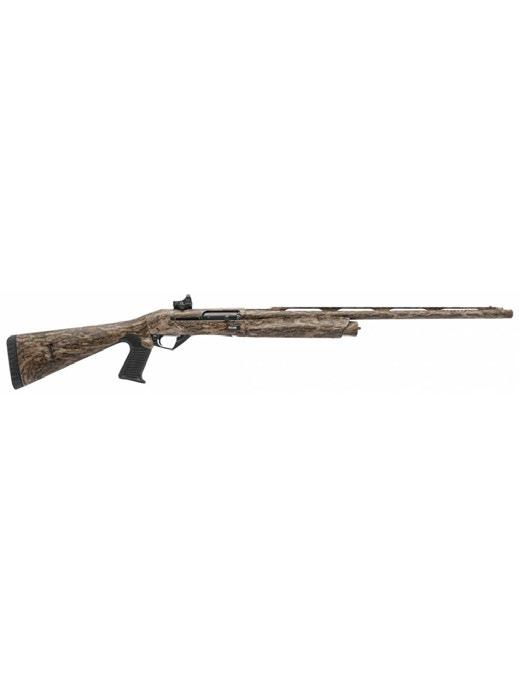
Mossberg 500 – This rugged classic has been redesigned this year with a milled receiver to make mounting optics a breeze
Savage 301 – Simple, lightweight and affordable; the Model 301 is perfect for smaller-framed shooters or hunters looking to experiment with a sub-gauge

.
16 March 2023 // GreatDaysOutdoors.com // 877.314.1237
Spring is here and the turkeys are gobbling. If you’re looking for a new gun to fling lead at heads, 2023 is a good year. Several big players in the shotgun world have developed new models to take advantage of the latest technology and the results are more effective than they’ve ever been.
If you’re new to shotguns or it’s just been a while since you’ve been in the market, it can be confusing. Here are a few key things to consider before you drop your hard-won cash on a new turkey killer.
ACTIONS
There are three basic types of shotgun action: break-barrel, pump, and automatic.
Single shot break-barrels hinge open at the receiver to allow for insertion of shells. Pumps rely on the user manually cycling the forend to eject the spent hull and ram a fresh shell into t he chamber. Semi-automatics use either a gas or inertia-driven system to accomplish this without input from the user, hence the phrase “automatic.”
All things being equal, single shot break open barrels are generally the cheapest to produce, automatics the most expensive, and pumps live somewhere in the middle. Break-barrels typically weigh the least and can be the most compact while pump and automatics are usually roughly tied in this respect with both fairly heavy and surprisingly light guns being available.
Break-barrels are in many ways perfect for “run-and-gun” hunters who enjoy large tracts of property and a morning of hopping from one ridgetop to another looking for a cooperative bird. Their simple action means that they are usually very lightweight, and because shells are manually inserted directly into the firing chamber they have very compact actions. This translates to a gun that can have the same length-of-pull and barrel length as a gun with another action type but be three inches shorter in overall length. If you’re maneuvering through underbrush in a sprint to beat a gobbler to a saddle or field edge this can be very desirable. Many manufacturers lean into this weight and bulk savings advantage and offer their break-barrels in sub-gauges (more on that to come) making them ideal for youngsters and smaller-framed shooters.
Pump action guns are a classic, dependable staple in the turkey hunting world. They are generally relatively inexpensive, tolerant of diverse loads and less-than-perfect cleaning habits and they allow for rapid follow-up shots. While this is not as important for a turkey hunter as for a small game or waterfowl hunter, many hunters like the piece of mind and the option to quickly place a follow-up shot brings. Pumps also have a well-deserved reputation of offering rugged, blue-collar, value-conscious service. If you’re hard on gear and value things that “just work” pumps are the tool for you.
Automatic actions are considered by many the pinnacle of effectiveness in shotgunning. They cost more, but they also do more. You don’t have to remember to “shuck” a new load into the chamber; the gun does it for you, and it does it quick er than you can recover from the recoil. This little luxury can be invaluable, because otherwise functional brains can devolve into incompetence in the face of a turkey that somehow didn’t drop and flop in response to the initial shot.
GAUGES
From the standpoint of pure efficiency, there is no substitute for a 12 gauge. The reason why is simple. More pellets leaving the barrel to start with means a higher chance of one ending up in a turkey’s brain or spinal column down range. A 12 gauge shell can hold more pellets than a 16, 20, or 28 gauge shell; and it can hold many more pellets than the diminutive .410 shell. (It’s a conversation for another day why the .410 is the only shotgun caliber that’s a caliber and not a gauge. Let’s just roll with it for now!)
But there’s a catch. For every action there is an equal and opposite reaction, and all that mass and energy leaving the barrel comes with big recoil forces into the shooter’s shoulder. This can be bad news for smaller shooters or those who are recoil sensitive. It can also be unfortunate for hunters who appreciate lightweight guns, because gun mass absorbs recoil, and less mass means more of a punch in your shoulder pocket.
Luckily, modern shotgun loads and chokes can do more with fewer pellets than has previously been possible. Tungsten, a heavier-than-lead metal, and chokes specifically designed with it in mind have revolutionized what sub-gauges are capable of. 20 gauge and .410 guns are currently the most widely-available sub-gauges. The diminutive .410 realistically remains a bit of a novelty caliber for experienced hunters bored with the usual options, but a 20 gauge in the hands of a hunter willing to spend some time patterning it can be a lightweight, compact, low-recoiling, turkey killing machine.
The .410 in particular has experienced a revival. For a long time it was considered a sub-par youth gun, capable perhaps of harvesting a kid’s first turkey at 20 yards or so. Killing power in a shotgun load is determined by 3 things variables…how many pellets you have, how much they weigh, and how fast they go. The .410 can fling a pellet just as fast as any other shotgun caliber, but its diminutive size has until now meant that you couldn’t get enough pellets that were heavy enough to kill turkeys into the shell, leading to thin patterns at a relatively close range.
Tungsten is a miracle-worker, since #9 tungsten pellets weigh about the same as #5 lead pellets, and you can fit more of them in a shell. How many more? A friend let me cut into one of his shells. A 3” Federal TSS tungsten load of had about 290 #9 pellets. I dug into my safe and found a box of 3” Remington #5 lead, which when cut open revealed about 120 pellets.
This means you can have about 2.5x more tungsten pellets coming out of the barrel than you can expect with lead, and they’re hitting just as hard as the old lead pellets. The result? With careful patterning, the .410 is now a capable 30-40 yard turkey gun.
CHOKES
Speaking of patterning, you should do it! It can be hard to “waste” high-dollar turkey loads on paper, but it remains the only real way to know what is going to happen when you put a bead on a turkey and pull the trigger. Once you’ve decided on a gun and ammo for it, the remaining variable that can influence your pattern is the choke. There are many choke manufacturers out there, and all of them offer full to extra-full chokes designed as “turkey chokes.” But your gun will come with factory chokes, and you should shoot them before you
HUNTING 877.314.1237 // GreatDaysOutdoors.com // March 2023 17
Choosing the Best Turkey Shotgun 2023 shop for aftermarket specialty products. You may be surprised with the results. If you can put 10-12 pellets on a turkey head / neck target at a range you find acceptable, you’re set. If not, pick a reputable manufacturer and start down the rabbit hole. Chokes are relatively inexpensive, which is good because odds are you may buy several before you find “the one.”
BARREL LENGTH

While duck hunters and other wing-shooters often prefer a longer barrel for a smoother swing while tracking moving targets, most designated turkey guns will have shorter barrels. Unless you plan to shoot iron sights, in which case you may benefit from a longer sight radius, a shorter barrel will weigh less when you’re burning boot leather and be more maneuverable in the brush or the blind. You can absolutely use your duck or dove gun with its 26-28 inch barrel for turkey season, but a designa ted turkey gun will usually come in the 22-24 inch range.
SIGHTS
Turkey heads are small, and modern turkey chokes and loads shoot very tight patterns at relatively long ranges. Put this together, and it means that it’s surprisingly easy to miss a gobbler. A simple bead is dependable and cheap and can’t be beat from a weight savings standpoint, but optics are for many hunters worth the added expense and weight. For the ultimate in accuracy, a shotgun scope is designed to stand up to stout turkey loads while providing a precision reticle and a little bit of magnification. For hunters who prefer something lighter, or for those whose vision isn’t as sharp as it used to be, tube and reflex-style red dot sites offer lightning-quick target acquisition in a small package. They’re particularly handy because you don’t have to have a perfect cheek weld when aiming. If you’re
contorted into an awkward position due to a bird slipping in from an unexpected direction, you can put the dot on the bird and pull the trigger.
RECOMMENDATIONS
Benelli Super Black Eagle 3 Turkey Performance Shop


If you’re looking for the “Ferrari” of turkey guns, this is it. Benelli is a premium name in the shotgun world, and the Super Black Eagle 3 is their flagship model. This iteration comes with a 24” barrel and a Burris Fastfire 3 reflex sight. It’s the pinnacle of performance, and a gun that your kids will be proud to inherit.
Mossberg 500 Optic-Ready Turkey Model
The Mossberg 500 is the most-produced civilian model longarm in the world. This year’s new optic-ready turkey model takes the proven pump action and adds a 22” barrel with a Truglo front site and a receiver milled to accept the optic of your choosing. It’s an affordable, utilitarian classic ready to endure decades of hard use.
Savage Model 301 Turkey Bottomlands
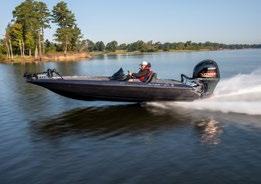
The Savage 301 is a return to simplicity. It is a lightweight and compact single shot break-open and is offered in 12 gauge, 20 gauge, and .410 caliber. Since its introduction to the market it has been immensely popular with hunters looking to add a subgauge to their arsenal. It comes with a choke factory-optimized for tungsten loads and a rail for attaching the optic of your choosing. It’s also very attractively priced, making it perfect for a kid or as a loaner gun.

4500 Hwy. 77 • Southside, AL 35907 1-800-IMREADY • www.bucksisland.com Fish’n fun Preorder your Powered by NOW AT ZXR20 ZX150 18 March 2023 // GreatDaysOutdoors.com // 877.314.1237


Surrounded by water. Engulfed in the catch. Escape to Alabama’s 32-mile island and experience a vacation like no other. Relax on sugar-white sand beaches, indulge in our coastal cuisine and reel in the catch of a lifetime, all in one unforgettable place. GulfShores.com . OrangeBeach.com . 875-475-1534 2023 OFFICIAL VACATION GUIDE GULF SHORES & ORANGE BEACH 877.314.1237 // GreatDaysOutdoors.com // March 2023 19
By going about it correctly, anglers can find and catch some big, strong, delicious triggerfish.
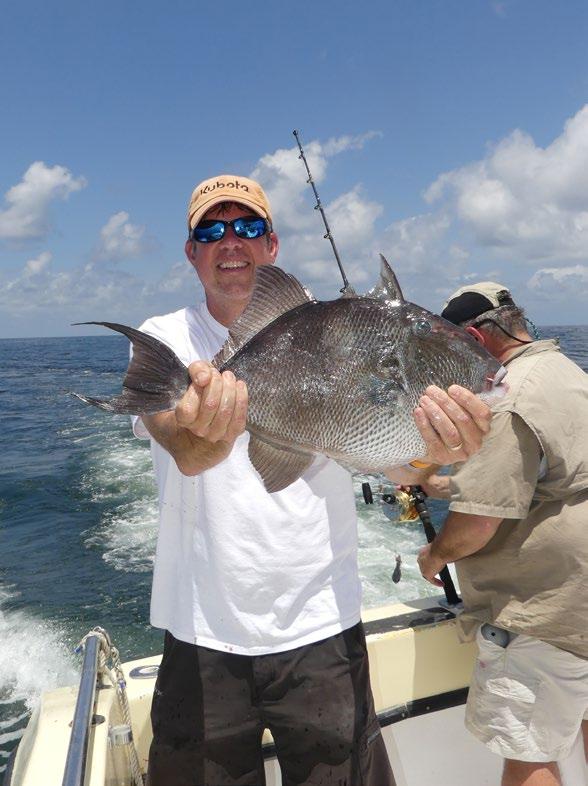
20 March 2023 // GreatDaysOutdoors.com // 877.314.1237
Catching Big GrAy Triggerfish
BY ED MASHBURN
For a long time here on the Gulf Coast, anglers who ventured offshore to chase after snapper and other delicious tasting and hard fighting fish scorned a very common offshore resident of our waters. It was not that long ago that when a triggerfish was hooked and brought to the boat, groans of disappointment and perhaps a few choice words of the coarser type would be heard.
My, how things have changed. Today, legal sized triggerfish are welcome additions to any offshore reef fish catch combination. Anglers have discovered that these funny-looking fish fight hard, bite very aggressively, and best of all, taste wonderful when prepared for a big fish dinner.
However, just because there are lots of triggerfish in the Gulf, that doesn’t mean that anglers can just run offshore a few miles and start catching big, bragging size triggers anytime. There are some things which can improve our chances of escaping the hordes of undersized bait-stealing triggers and finding the big, keeper- size and even trophy sized triggerfish.
SOME EXPERT HELP
Captain Harris Scruggs, an Alabama native who moved to Panama City, Florida with his family as a child has fished the inshore and offshore waters of the northern Gulf for a long time, and he knows quite a bit about catching triggerfish, especially, big triggers. He offers us some very good advice when it comes to catching triggers.
First, triggerfish are very common in the Gulf at this time. In fact, the swarms of smaller triggers can really complicate things for anglers who are looking for bigger fish such as snappers, amberjack and grouper due to the fact that can and will strip cut bait and even live bait intended for these bigger fish in a matter of seconds.
“Whatever the limit is, you’re going to catch a bunch of them that are just undersize. So, what do you do if you want to target bigger triggerfish?,” Scruggs said.
There are a number of things that anglers can do to improve their chances of catching a really big triggerfish, and make no mistake about this, big triggerfish are out there in our northern Gulf waters,
and they will put up a very hard fight when hooked. But the bigger triggers are not to be found on every reef and wreck.
LOCATION, LOCATION, LOCATION
“So, obviously on a charter boat, fishing the traditional two-hook chicken rig just doesn’t get it done often for the bigger triggerfish. So, if I’m going to try to just catch the bigger triggerfish, there are a few things to keep in mind,” Scruggs advised. “First, you have to obviously be in the right place and you know, a smaller rock is a really good place for bigger triggerfish to hang out. I’ve caught my bigger triggers, and by bigger, I mean ten or twelve pounders which are 26 inch fish and not the 17 or 18 inch fish, that were on a small junk pile, like a private spot like a chicken coop or something like that. Usually there’s some bigger triggerfish on those places. You’d be surprised at the bigger triggerfish that are on these little kinds of homemade places.”
So anglers looking for the mega-triggers might want to look for smaller, less-fished small spots on the bottom where the bigger triggers hang out away from the crowds of smaller triggerfish and anglers.
RIG IT RIGHT
Although triggerfish can be caught on just about any offshore fishing rig, our chances for fooling the bigger, smarter triggers can be improved by making sure our gear is right for the job.
Scruggs said that he likes to fish a 25 to 40 pound leader that is four or five feet long with a 3000 to 4000 spinning reel and rod set up. He fishes his bait up off the bottom 15 or 20 feet with a three or four ounce lead and a long leader and finds that small hooks work well.”
Traditionally, the bait of choice for triggerfish is a simple square chunk of squid or cut bait. Tons of triggers have been taken on just this simple bait offering.
However, Scruggs pointed out there may be better ways to fool the bigger triggers.
“Instead of using a square piece of bait like a piece of squid or something that’s going to twist on the way down especially on these lighter lines, I like to streamline the bait- kind of make it longer than it
FISHING 877.314.1237 // GreatDaysOutdoors.com // March 2023 21
is wide. It actually flutters down but doesn’t get all wrapped up in the leader. This usually gets the bigger triggers,” Scruggs said.


So how long should the mega-trigger bait offering be?
“How long do I make the bait strip? Up to four or five inches long. I think that is perfectly acceptable. If you were to cut a fillet off a baitfish- a mackerel or something- like a larger 14- inch strip, you could kind of cut it down a lot and have four baits off one fish,” he explained.
PAY ATTENTION!
Trigger fish will fool an angler in many ways. First, even though they don’t look like they could move very fast, triggers are notoriously fast at stealing an angler’s bait. These funny-looking fish are fast on the bite, and any angler who is not aware of what’s happening below the surface will soon be fishing with a bare hook, and not getting any attention from the triggers below.
“Anybody that’s spending time on the water knows that triggerfish will eat your bait off the hook whether you have two hooks, three hooks, one hook,he will eat it off before you know it, just like sheepshead. And if you’re not paying attention to the bite, you’re just sitting down there wasting time. When you drop that bait down- especially the first time and you get a good solid count- ‘One Mississippi, Two Mississippi, Three Mississippi- until you hit bottom,” Scruggs pointed out “Keep that count in mind. Because from now on, every time that bait is coming down, there’s triggerfish seeing it coming. Usually they’re up in the water column so they start to pick at the bait before it ever hits bottom. As soon as the bait hits bottom, they’re on it. So if you don’t get your line where you can feel those bites within the first six seconds, most of the time, you don’t have any bait left.”
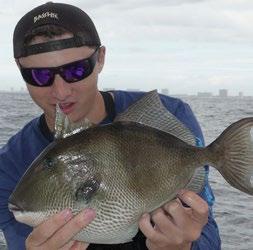
Clark’s

Plot Nutrients
is a true liquid fertilizer that is designed to not only provide fertilizer to your food plot, but also supply calcium. Calcium is vital to the development of deer antler growth and egg shell strength in turkeys.

• It is readily absorbed by plants because it is a foliar application. Therefore, within one hour 80-90% of the fertilizer is already absorbed into the plant and working
• Heavy rain will not wash away the fertilizer

Catching Big Gray Triggerfish Captain Harris Scruggs Team Aquatic Charters 850-532-5458 Teamaquaticcharters.com Contact Information Chris & Kelley Grantham Elba, Alabama 334-233-2687 ALFandSupply@gmail.com www.alfandsupply.com
ENDORSED BY:
DISTRIBUTED BY:
See what a difference it can make on your place! CALL FOR PRICING & QUANTITIES
equipment
• Will not settle out in your tank or application
• There are no particles large enough to clog spray nozzles
Unlike many liquid fertilizers, Clark’s Plot Nutrients: EASY APPLICATION!!!
Food Plot Fertilizer Plus Calcium
Liquid
22 March 2023 // GreatDaysOutdoors.com // 877.314.1237
Our northern Gulf reefs support large numbers of legal triggerfish for anglers to enjoy.
Through

VISION

To be a relationship driven partner integrating vital resources to ensure our members/farmers success.




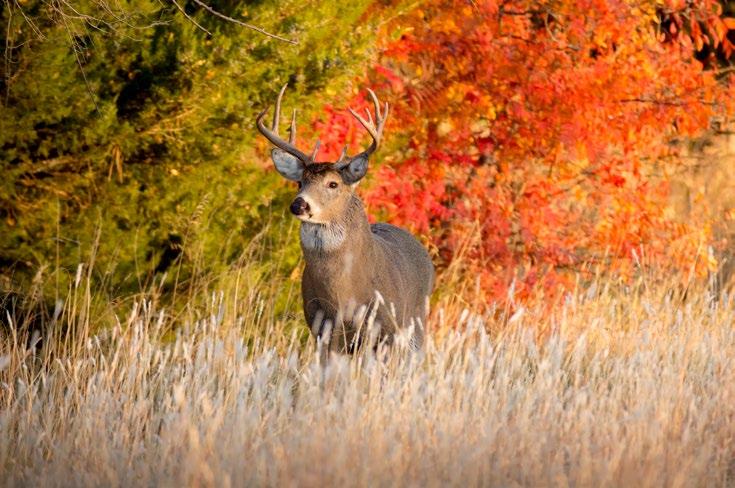


@ALAFARM_COOP WWW.ALAFARM.COM 877.314.1237 // GreatDaysOutdoors.com // March 2023 23
strong leadership and diversification, Alabama Farmers Cooperative, Inc. has grown to become one of the largest farmer owned agriculture related businesses in the Southeast.
/ALAFARM
No matter how bad the weather, economy, evening news, or even our health, it’s hard to keep anyone with a passion for fishing, hunting, or water sports away from the water.
The enjoyment that comes from a disappearing cork, tubers flying through the air, or seeing the anticipation of your retriever as you ease into a favorite duck hole just never fades. Sharing these moments with your significant other, kids/grandkids, or friends helps to create great memories that sometimes evolve into stories worth retelling and lifelong traditions.
Whether it’s enjoying the scenery, visiting sandbars, swimming or using your boat to reach remote hunting destinations, spending quality time with family and friends outdoors is good for one’s soul. There’s also a sense of freedom knowing that you can launch your boat anywhere your four-wheeled drive can maneuver.
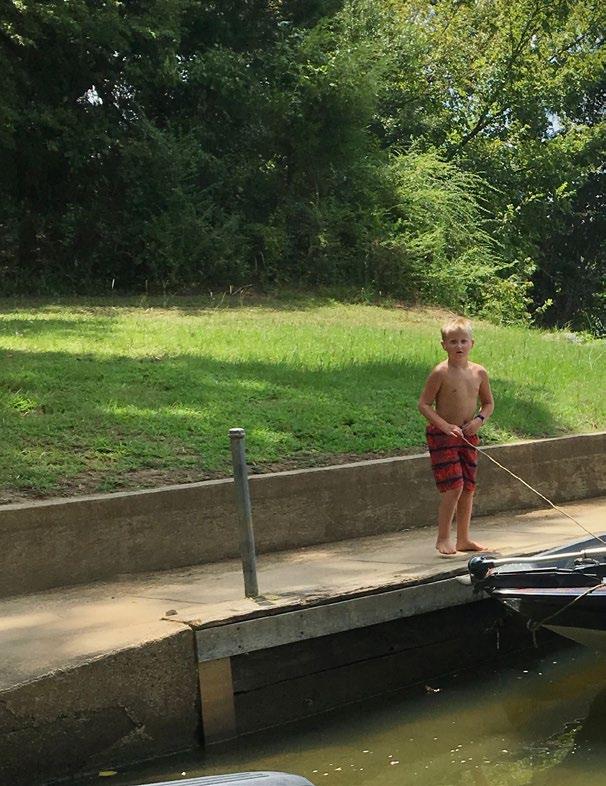
The type of water one roams in search of adventure, or fun varies considerably. That and the thickness of one’s wallet will significantly influence a potential buyer’s decision when they are in the market for a boat.
A light or moderately used boat can be an excellent option for someone looking to save a few bucks compared to paying the retail price of a new one. However, suppose they don’t know what questions to ask or neglect to ensure the hull and engine are in good shape. Then, what looks like a good deal can quickly become a regrettable decision.
Whether buying from an individual or a dealer, several questions about a boat’s hull and engine need answering before you make a commitment. However, suppose you’re not quite sure what questions to ask or where and what to look for to ensure everything is shipshape on a used boat. In that case, I suggest seeking advice from a seasoned veteran or a professional.
PROFESSIONAL ADVICE
I contacted the Service Manager at Buck’s Island Marine on Neely Henry Lake to discover what questions a prospective buyer needs to ask and where to best focus their attention in determining a boat’s overall condition.
Angela Britt oversees 18 dedicated service bays at this family-owned and operated marina entering its 75th year of sales and service. She has accumulated a wealth of knowledge through managing the service and repair of almost every type of boat imaginable. She also ensures that their factory-certified mechanics stay up-to-date on the newest products.
Britt discussed Buck’s Island’s inspection process when preparing a trade-in for sale. She said their factory-trained mechanics at Buck’s Island usually begin their evaluation with a boat’s engine.
ENGINE
Britt explained how their technicians inspect the lower unit and propeller for signs of impact or freeze damage, then check the foot and engine oil for contamination. She said that most outboards produced in the last couple of decades have a control module that records vital information such as engine hours and the number of starts.
She described that the transom is tested by raising the lower unit, grabbing the foot, and applying pressure up and down to check for any weakness or damage. Then, they remove the engine cover and look at the overall cleanliness, checking for any signs of leakage, corrosion or cracks in the lines. Next, they inspect all the screws and bolts and gently tug on the fuel lines and other parts.
If everything is good up to this point, it’s run at various rpm’s, shifted, stopped, and repeatedly cranked to ensure everything is in working order. Next, the engine is left running for 15-20 minutes in the shop with water flowing through the foot, after which they do a compression test to evaluate each cylinder’s condition.
24 March 2023 // GreatDaysOutdoors.com // 877.314.1237
What to Look For When Buying a Used Boat
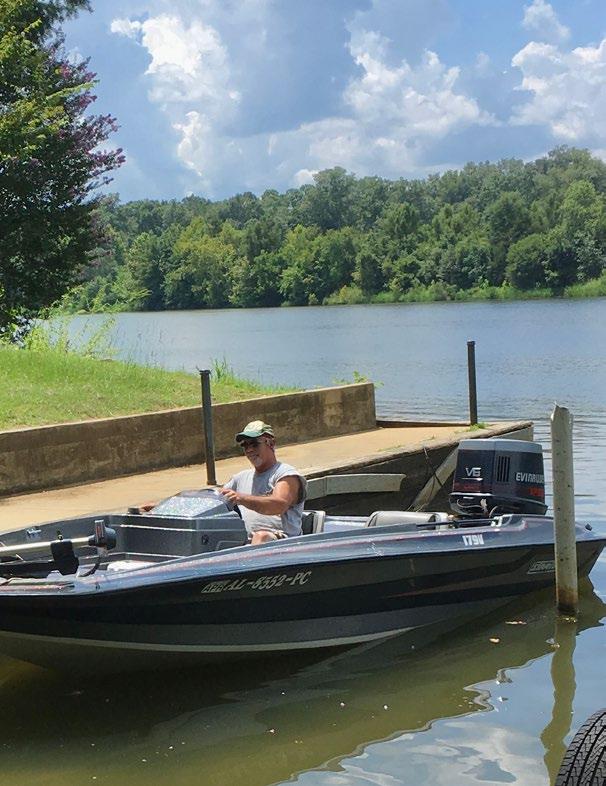 BY DAVID STRICKLAND
BY DAVID STRICKLAND
This 30+ year old model has plenty of life left, for a fraction of the price of a new one .
877.314.1237 // GreatDaysOutdoors.com // March 2023 25
FISHING
Britt added that if a technician detects any abnormal issue, they take it to the nearby Coosa river for further evaluation on the water,
HULL
Britt outlined how Bucks technicians determine the structural integrity of a boat’s hull and how they evaluate any visible damage.
“After ensuring that a boat’s transom is solid, they look for any abrasions or scratches that extend past the gel coating, and also for any spider-webbing, then determine if it’s normal wear or signs of an impact,” she said.

Britt added that they can repair most minor surface issues but any cracks that extend beyond the gel coating need more extensive repairs.
Walking on every part of a boat’s interior as you inspect the carpeting is an excellent way to check for any deck problems. A bounce or two can confirm any suspicions if an area feels a little soft.
ELECTRICAL WIRING AND COMPONENTS
Examining wiring at the battery terminals and trolling motor/fish-finder connections should give an idea of the overall wire condition. Unfortunately, most of a boat’s electrical wires are not easily accessed and run through channels in the hull. However, look closely at the terminal ends to ensure they are correctly shrink-wrapped, check all plugging connectors for looseness, and look for any discoloration or signs of overheating.
Always ask how and where the owner stores their vessel and if they used a cover. If the boat sits parked for an extended period, check for signs of damage to exposed wiring. Certain rodents love to sharpen their incisors on a wire’s insulation, and mud daubers have caused extensive engine damage when they build their miniature mud huts inside an air intake.
Britt said they check all switches and circuit breakers for looseness and functionality. Still, aside from ensuring all the electrical components are in working order, she stated that it’s difficult to fully evaluate the onboard electronics.
TRAILER



Don’t neglect to give the trailer a good once over:
1. Check that all runners are solid and supporting the hull properly.
2. Check each tire for uneven tread wear, jack up each wheel, wiggle it, and give it a good spin. Any excessive movement, rumbling or unusual noise might mean a bearing or axle issue.
3. Plug the wiring connector into your vehicle and check that all lights are operational.
4. Take a short test drive to ensure the brakes are working correctly.

PAPERWORK
If buying from a private seller, ensure the paperwork is in order and the numbers match on the hull and motor. Britt said that only after an engine and hull pass their inspection does she thoroughly examine the boat’s paperwork. Next, she verifies its service history and looks for any recall issues.
DIY
If you can locate a boat locally or have a friend or relative willing to sell you theirs, it’s still a good idea to give it a thorough once over, then ask to see the paperwork if it looks to be a keeper.
Be sure and ask about any repairs and when it was last serviced. Locate the manufacturing date of the hull and motor and also determine how many operating hours the engine has.
Ensure the boat and engine serial numbers match the paperwork and ask
What to Look For When Buying a Used Boat ◊ Buck Magnet ◊ Ideal Plus ◊ Superior ◊ Salad Bar ◊ Super Buck ◊ Select ◊ Select with Peas ◊ Select with Clover ◊ Select with Salad Bar ◊ Spring Summer Mix ◊ Rackzone ◊ Trophy Buck with Peanuts ◊ Ultra Rack ◊ Antler Magnet ◊ Extreme ◊ Rackmaker ◊ Rackbuilder Pellets ◊ Apple Corn ◊ Triple Cleaned Corn ◊ Rice Bran ◊ Rice Bran Acorn Flavor ◊ Rice Bran Peanut Butter Flavor ◊ Rice Bran Persimmon Flavor Increases emergence and early seedling growth Do you want to provide better nutrients to your deer ? IRRESISTABLE • SCIENTIFICALLY FORMULATED • PROMOTES EXCELLENT HERD HEALTH • EASY TO FEED • HUNTER SATISFACTION DEER LOVE IT Visit our website www.southernseedfeed.com or call 662-726-2638 to find the dealer nearest you. keeps em’ coming, keeps em’ healthy, and keeps em’ in your sights • EASY TO PLANT • PROVIDES NEEDED PROTEIN FOR ANTLER AND BODY DEVELOPMENT • PROVIDES FORAGE WHEN NATURAL FORAGE IS DORMANT • PROMOTES HEALTHY WILDLIFE • PROVIDES UP TO 10 MONTHS OF FORAGE
for:
Distributor
26 March 2023 // GreatDaysOutdoors.com // 877.314.1237
about a test drive. If that’s not possible, ask the owner to hook up a water hose to the lower unit, crank it several times, idle it for a few minutes, and then run it at full throttle for at least 10 seconds. There’s a problem if the engine is loose, smoking, running rough, or noisy.
Remove a small sample of engine oil into a clear glass bottle. Rub a small amount between your fingers to check for grit, moisture, or metal particles. If you’re considering buying a larger boat, consider hiring a boat engine mechanic to examine the engine(s) or conduct a fluid analysis. This simple test could save you from future problems that can be tricky to identify during a physical inspection.
CONCLUSION
A boat/trailer in good working order can allow you and your family to enjoy the great outdoors, breathe some fresh air, and enjoy a variety of waterborne activities. In addition, buying a used boat can result in significant savings- if you do your homework.
If you are in the market for a reliable, used boat, arm yourself with the knowledge you need to make a good decision concerning the seaworthiness of the next addition to your family.
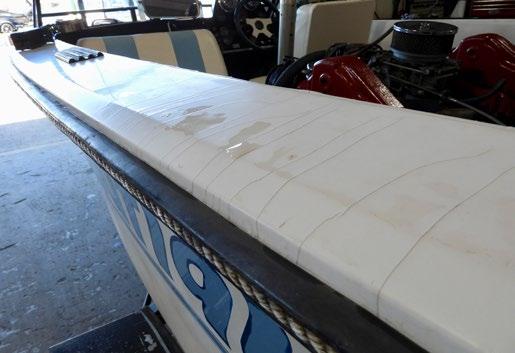
Remember, if you need assistance or want to avoid the hassle of traveling to and fro in search of a deal, Buck’s Island is just a click, call, or short road trip away and can answer any question you have about what to look for in a good used boat.
Contact Information
Buck’s Island Marina (256) 442-2588
bucksisland.com

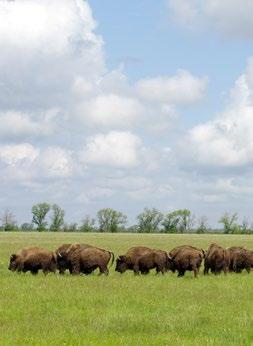
What to Look For When Buying a Used Boat
HARVEST YOUR OWN MEAT Our grass fed and hormone free Bison meat is a healthy alternative to beef with less fat, calories and cholesterol. Call 205-296-0072 for reservations, prices and to create a lifelong memory.
ALABAMA BISON HUNT
Cracks on an older model can be the result of impact or age-related stress
ALABAMA HUNT
877.314.1237 // GreatDaysOutdoors.com // March 2023 27
Wet-Aged vs Dry-Aged Venison
BY JOSH HONEYCUTT
Diving into the different aspects and avenues of aging wild game meat
It’s important to decide if you’ll dry or wet age wild game prior to starting the processing routine .
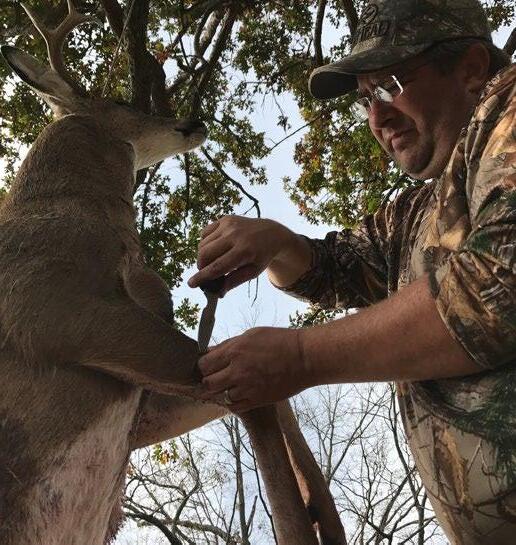
28 March 2023 // GreatDaysOutdoors.com // 877.314.1237
Aging wild game meat has long been a practice. Regardless, it’s been a very popular method for many decades now, and hunters have two great options to choose from. The first is dry aging, which is an older method, and wet aging, which is a newer version of aging meat. So, which is better, or right for you? Let’s find out.
AGING MEAT. WHAT IS IT?
To understand wet or dry aging, one must first learn what general aging means.
“Aging is the process of letting meat rest over an extended period of time so that naturally occurring enzymes break down the connective tissues, tenderize the meat, and in some cases, add flavor,” said Michael Pendley (https://www. instagram.com/mickypen_eats/), who is an expert wild game chef and author of Realtree’s Timber 2 Table blog (https://www.realtree.com/timber-2-table-wildgame-recipes).
WET AGING DEFINED
According to Pendley, this is a process where the meat is sealed in a plastic bag — which is usually vacuum sealed — and placed in a refrigerator. This process requires a temperature ranging between 33-38 degrees, and the complete process takes up to three weeks.
“Unlike dry aging, there is no moisture loss with wet aging,” Pendley said. “Wet aging can go for as short a time as three days for small cuts like backstrap roasts, or two to three weeks for entire quarters.”
This method has its benefits. Pendley says it tenderizes the meat without moisture or meat loss. With dry aging, the outer layer dries out and must be trimmed, but this isn’t necessary with wet aging.
“With wet aging, the enzymes break down the connective tissues, but the weight of the meat stays the same,” Pendley noted. “Wet aging can be done in a standard home refrigerator and doesn’t require a walk-in cooler or specific weather conditions to occur.”
Despite this obvious upside, it doesn’t come without tradeoffs. With wet aging, the enzymes break down the connective tissues, but it doesn’t produce the same flavor as dry aging.
DRY AGING DEFINED
According to Pendley dry aging usually consists of hanging meat up. Oftentimes, the animal is still whole, but it might be quartered, especially with larger game, such as elk or moose. Unlike wet aging, this does not involve a protective coating, such as an air-tight bag. However, this too can take up to three weeks.
“In a perfect world, the aging chamber will hold a consistent temperature and humidity level,” he said. “Temperatures for proper dry aging should range from 33 to 40 degrees Fahrenheit but a few degrees above or below that range for short periods is fine. Besides tenderizing the meat, the process of dry aging leads to moisture loss in the meat, concentrating the flavors in a way similar to aged cheese. The process of enzymes breaking down the muscle also adds new flavors to the meat as the amino acids react with compounds in the meat.”
The benefit of dry aging is obvious — more flavor. Pendley describes it as a richer, meatier version of the original meat. This route produces tenderizing enzymes that are allowed to be more active and productive.
As previously noted, it does have its downside, though.
“Dry aging dries and molds the outer surface of the meat to the point that it needs to be trimmed and discarded,” Pendley explained. “This can lead to a significant percentage of meat loss on an entire animal. Small cuts can lose as much as 50% of the meat total to trimming. Speaking of small cuts, always remove the tenderloins before aging. Any percentage of loss on these small cuts is too much. They are tender enough to start with and don’t need additional help.”
SO, TO AGE, OR NOT TO AGE?
Those who decide to wet age or dry age their wild game will make such decisions based on numerous circumstances. Questions to ask include:
• Do I have the tools necessary to dry or wet age?
• Do I prefer the flavors that are associated with dry or wet aging?
• Do I have the time and space to dedicate to dry or wet aging?
• Do I have the right cuts of meat best associated with dry or wet aging?
• Do I have the knowledge to safely, effectively dry or wet age meat?
Once you’ve asked these questions, and more, it’s time to make the call. Will you dry age your wild game? Will you wet age it? That’s your call. Determine what’s right for you.
Tips and Things to Know for Wet Aging Meat
Venison lovers who plan to wet age their bounty of wild game should follow certain practices. There are a number of tips and things to keep in mind.
• Wet aging is a newer process than dry aging and is ranked ahead of the older method by most experts.
• A vacuum sealer, refrigerator thermometer, and refrigerator are necessary for properly wet aging meat.
• This technique is much better for smaller and leaner cuts that aren’t suitable for dry aging.
• Wet aging can be done between the freezer and cooking it if it wasn’t wet aged before placing it in the freezer.
• No moisture is lost, which can lead to a juicier product.
• No meat trimming is necessary after using this technique.
Tips and Things to Know for Dry Aging Meat
Those who plan to dry age their hard-earned venison and other wild game should follow best practices. There are certain tips and things to keep in mind.
• Dry aging meat makes it more tender, leading to meat that’s easier and better for consumption.
• Dry aging can make a lesser cut of meat much better, but these are more susceptible to excessive dehydration.
• Enzymes break down the meat’s carbs, proteins, and even its fats.
• These same enzymes convert the meat’s carbs, proteins, and fats into flavorful sugars.
• Properly-aged meat is easier to cook and caramelize.
• All that is required for basic dry aging is a refrigerator, shelf system, and something to place the meat on.
• Using some salt helps to amplify the dry aging process.
• Some might prefer to brush the meat with certain rubs or spices before dry aging.
• A wire rack is better than a flat pan, as it optimizes air circulation around the meat.
• Use a sheet or pan underneath the wire rack to catch drippings.
• Dry-aged meat from a market can cost double or triple the same cut of meat that hasn’t underwent that process.
HUNTING 877.314.1237 // GreatDaysOutdoors.com // March 2023 29
Those who plan to age their venison should start the process with clean, sharp, effective processing equipment .
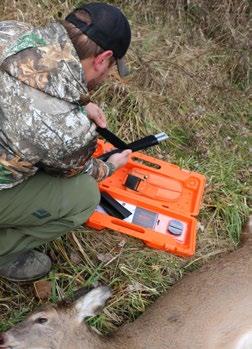 BY KIRSTIE PIKE
BY KIRSTIE PIKE
Venison Lasagna

Ingredients
• 1 pound venison burger
• 8 oz chopped mushrooms
• 1 tub Ricotta Cheese (30 oz)
https://resources.mossberg.com
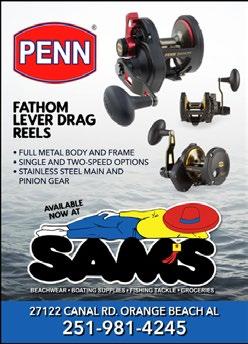
• 1 bag frozen chopped spinach
• 67 oz of your favorite spaghetti sauce
• 1 box lasagna noodles (DO NOT use the no-boil)
• 32 oz shredded Mozzarella
• 3 tsp Minced Garlic
• Fresh Basil (optional)
• Red Pepper – optional
Instructions
1. Boil water and add lasagna noodles. Cook until tender. Rinse and drain. Set aside in a colander.
2. In a skillet, cook your venison burger or Italian Sausage. Add mushrooms to burger/sausage and cook until browned. Set aside.
3. Thaw but do not cook spinach. Squeeze the remaining water from the spinach.
4. Combine the ricotta cheese, garlic, chopped spinach, and red pepper in a bowl. Set aside.
5. Make a layer of lasagna noodles in the bottom of a 9x13 pan.
6. Take half of the ricotta cheese mixture and evenly spread it over the noodles.
7. Take half of the sausage mixture and evenly spread it over the ricotta cheese.
8. Pour half of the spaghetti sauce over the sausage mixture and spread it evenly.
9. Take half of the mozzarella cheese and spread it evenly over the sauce.
10. Repeat steps 5-9 so you have 2 complete layers.

11. Cover with aluminum foil but do not let foil rest on the cheese
12. Bake at 400 degrees for about an hour.
13. Start checking on the lasagna around 45 minutes into the process. Once the lasagna looks bubbly and cooked throughout, remove the foil and cook until the cheese becomes lightly browned.
Recipe and image courtesy of Mossberg www.
Wet-Aged vs Dry-Aged Venison 30 March 2023 // GreatDaysOutdoors.com // 877.314.1237
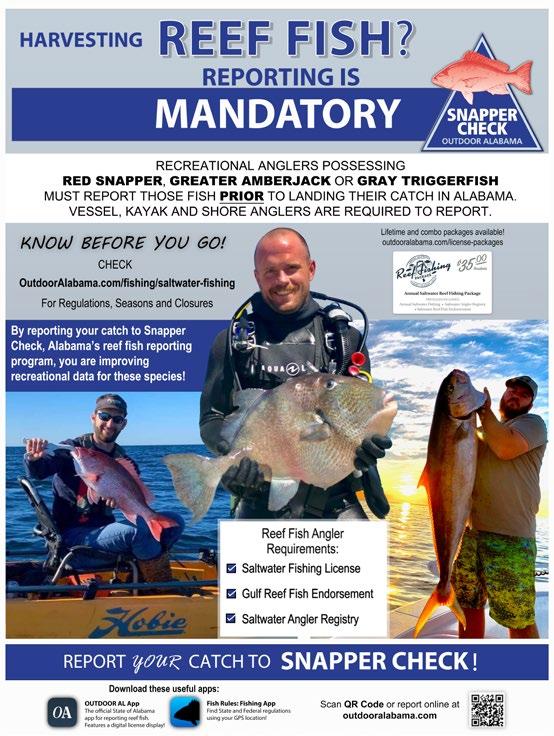
877.314.1237 // GreatDaysOutdoors.com // March 2023 31
Long-Lining vs Side Pulling vs Spider Rigging for Crappie
BY GREG MCCAIN
Crappie presentations
wax and wane in terms of popularity .
Brad Whitehead, who guides on the Tennessee River impoundment Pickwick Lake and also on the BCDA lakes in Franklin County, favors a unique type of trolling, side-pulling, which provide some advantages over more traditional methods .
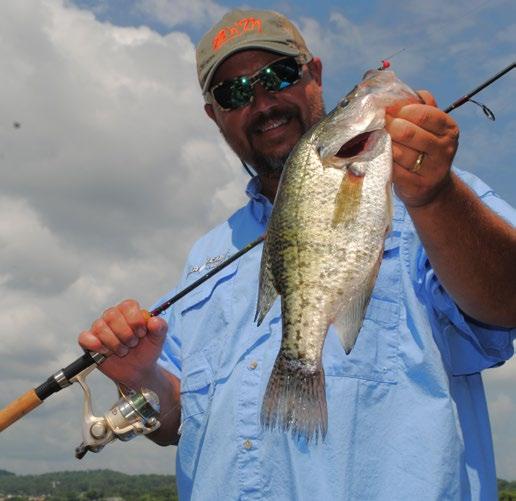
32 March 2023 // GreatDaysOutdoors.com // 877.314.1237
With the evolution of electronics – and especially since the advent of forward-facing sonar like Garmin’s LiveScope technology, many anglers have reverted to one-pole presentations, either casting, flipping, or vertical jigging to individual fish. In particular, that approach has dominated the tournament scene in recent years.
Pushed into the background of this modern era of crappie fishing are various approaches to trolling. Yet nothing has changed the productivity and efficiency of trolling presentations. The various iterations of the approach maintain their overall effectiveness. Simply put, trolling remains a deadly presentation for crappie regardless of the fishing venue.
Downplay that idea at the risk of catching fewer fish. Better still, take the advice of crappie guides who spend hundreds of days each year on the water. Guides Darrell Baker and Brad Whitehead put their own unique touches on trolling for crappie in north Alabama while guide Tim Howell deploys a multi-rod spread on the famed Big 4 lakes in north-central Mississippi. Each acknowledges the role of modern electronics in the crappie-fishing world, but trolling remains their go-to presentation on a trip-to-trip basis.
LONG LINING …
For years, Baker from Weiss Lake Crappie Guides in Centre, AL, has guided clients to scores of crappie on Weiss Lake, the uppermost impoundment on the Coosa River. As the harsh winds of winter give way to better conditions in March, Baker can likely be found trolling for Weiss slabs. While he is a versatile guide adept at various crappie-fishing techniques and presentations, Baker admits long-line trolling is hard to beat in late winter and early spring.
“The fish are schooling up in the coves in the spring, getting ready for the spawn, The fish are in large schools and are usually pretty active, so they will hit a moving bait,” he said. “I think they feel like the bait is trying to get away from them, and that is what triggers them to chase and bite it.”
According to Baker, fishing conditions in March also make long-lining preferable to other approaches. Wind comes into play on a daily basis in March and a moving boat is less susceptible to being redirected by the wind.
On Weiss Lake, local regulations limit anglers to three rods each. On other fisheries, at least eight rods and occasionally more are used for long-lining. Some boats can accommodate up to eight rods in the front with four more in the back. Rods of different lengths – needed to eliminate tangles – are staggered out the front on each side.
Long-liners typically troll from about .7 mph to just over one mph. Darrell ties one or two jigs directly to the main line with a loop knot. He uses B’n’M rods and fills his reels with six pound. Gamma Optic yellow line. His “go-to” plastic is the Charlie Brewer’s Slider Co. Crappie/Panfish Grub
“I use all six-pound Gamma because I know where my jigs are with that size line,” Baker said. “I’m fishing 1/32-oz. up to maybe 1/24-oz. jigs. I’m moving about .9 to 1.2 mph, fishing shallow in those stumps in the coves.”
Baker also knows his clients. Most of them come to Weiss looking for crappie filets. Long lining is just the right approach for them.
“It’s hard to beat a good long-lining bite in the spring,” Baker said, “and it’s an approach that any of my clients can adapt to quickly.”
… VERSUS SPIDER RIGGING
Tim Howell at Longbranch Guide Service, might practice his trolling techniques in Mississippi, but he suggests that his approach to spider rigging will catch crappie just about anywhere.
The monster white crappie on lakes like Grenada, Enid, and Sardis are very much affected by the vagaries of March weather. Howell said that the crappie there become lethargic, especially in post-front conditions. That mood swings demand a slower approach, and spider rigging addresses all the needs of finicky fish.
“The main reason is you can slow the presentation down to almost dead still whereas with long lining or side pulling, you’re having to move a lot faster,” Howell said. “Normally in prespawn, the fish are lazy and want a slower-moving bait in my opinion.”
Howell uses various presentations and rigging throughout the year. He finds pulling crankbaits is a hot ticket from late May through September, but he is usually slow-trolling jigs in the pre-spawn.
He uses a spread of up to eight ACC Crappie Stix 16-foot trolling rods. His favorite combination on the business end is a ¼-oz. jig head paired with a Midsouth Tackle tube-style plastics. He frequently uses two jigs, one about three feet up the main line, another about 18 inches down with a weight at the bottom. The size of the weight, which is usually ½- to one ounce, is dependent on various factors, including wind, water depth, and trolling speed.
Most of the time, Howell trolls at .3 mph to about .5 mph while spider rigging although he may reduce speed to target structure or individual fish. Later in the year, he transitions to what he calls power trolling, a similar spider-rigging presentation but with bigger bait and bigger weights, and significantly increases his speed to one mph or slightly more.
On an average day, Howell finds himself in the vicinity of other guides and anglers staring at their LiveScope screen in hopes of catching individual fish. He said that is not what his clients want. Despite the daily potential for big fish, Howell seeks to put his customers on numbers of crappie.
“For me as a guide, it’s just the easiest way to fish and the most productive,” he said.
… VERSUS SIDE PULLING
Crappie fishing guru Brad Whitehead spends a lot of time fishing and guiding on Pickwick Lake and the Bear Creek Development Authority lakes in northwest Alabama c takes a different approach to trolling. He said the uniqueness of side pulling creates a different presentation for pressured fish. He also finds himself side pulling in different areas not covered by long liners or spider riggers.
He fishes from a boat specifically designed for side pulling with a trolling motor mount in the middle on the right side. Whitehead controls the speed and direction with the trolling motor but frequently fishes with the wind.
“We’re side-pulling in a War Eagle 754VS, using 10 or 11 rods with a mixture of hair jigs, (Charlie Brewer) Sliders, and curly tails,” Whitehead said. “All the rods are in clean water all day long, meaning it probably hasn’t been fished by other trollers. I’m pulling a consistent .7 to .9 mph.
“One of the things side pulling brings to the table is that you’re able to go with the wind, cover water, catch the active fish on the move, whether they are coming off the bed or feeding up before the spawn.”
He uses B’n’M rods, nine foot models in the back and middle and 10-footers in the front. Whitehead sits in the back of the boat, and the longer rods in the front allow for easier bite detection. The rods, called The Difference, were designed by legendary Pickwick guide Roger Gant, from whom Whitehead learned side-pulling.
Whitehead rigs a vertical presentation that includes one jig at the end of the
FISHING
877.314.1237 // GreatDaysOutdoors.com // March 2023 33
Long-Lining vs Side Pulling vs Spider Rigging for Crappie main line, another about a foot above, and ⅓-oz. split a foot above the top jig. He said the weight “takes all the guesswork out of determining how deep your lures run. I’m able to count down to suspended fish and put the lures in their faces.”
Another benefit of side pulling is the opportunity to target deeper fish. Many of the bigger pre-spawn females rest in deep water until the urge to move shallow hits them.
“As a side puller, I like to target slightly deeper water than the typical trollers,” Whitehead said. “Most people would say 15 feet or under for most pre-spawn fishing. I’m out in 20, 22, or 23 feet of water.
“I’m catching slightly later fish and usually slightly bigger fish,” he added.
Regardless of the trolling presentation, long lining, spider rigging, or side pulling, the various approaches remain a fixture among knowledgeable crappie fishermen. Yes, it may be overshadowed by other trends, but any type of multi-rod trolling provides an effective means of targeting large numbers of crappie.
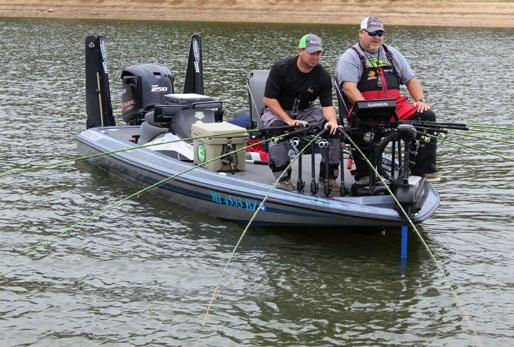
Contact Information
Darrell Baker Weiss Lake Crappie Guides https://www.weisslakecrappieguides.com/ 256.557.0129

Tim Howell Longbranch Guide Service Centre, AL 662.251.5625
Brad Whitehead 256.483.0834
Tim Howell, right, spider rigs on Grenada, the most famous of the Big 4 Mississippi lakes Howell finds that spider rigging remains the most appealing option for his clients .
34 March 2023 // GreatDaysOutdoors.com // 877.314.1237
Darrell Baker, long-time guide on Weiss Lake in northeast Alabama, puts his guests on plenty of slabs using the long-line trolling presentation
Land Loan Interest Rate Update
BY GREAT DAYS OUTDOORS
First South Farm Credit (FSFC) has been financing rural land since 1916. Since it was founded over 100 years ago, FSFC now has grown to over 40 branches with 9,000 members and serves the “Deep South” in Alabama, Louisiana and Mississippi.
As an affiliate of the national Farm Credit System, a network of borrower-owned lending institutions, First South Farm Credit specializes in providing credit for farming operations that include crops, livestock, land, and timber. FSFC is also chartered to help with financing lifestyle farms, rural home sites or rural land tracts for enjoyment or investment purposes.
As a rural lender, First South Farm Credit basically lends money to people for pretty much anything that they want to do “in the dirt”. That could be row cropping, growing timber, raising livestock or farming for wildlife. It doesn’t stop there.
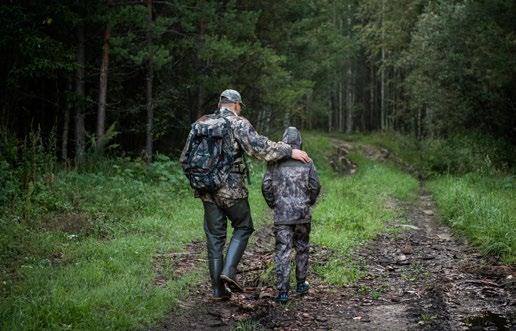
FSFC can assist a property holder in enhancing the value of the land. That includes things such as improving timber stands, clear-cutting, clearing roads, planting green fields, building ponds and planting trees and shrubs to improve green areas and cover for deer and turkey. It even encompasses lending money for controlled burns and planting of grasses and grain crops for things such as quail development and assisting in constructing access roads.
“First South Farm Credit can make construction loans and, if needed, can turn those loans into long-term loans. Some landowners are building secondary homes, hunting cabins or lodges, and others want to put their primary residences on 20 to 30 acres” says Taylor Hart, the branch manager of First South Farm Credit in Opelika, AL. “Perhaps that person wants to sit on his or her back porch and look at a pond and we make loans for pond construction as well.”
“First South can make loans for anything a landowner wants to do to
develop his property or its habitat or the amount of wildlife there. If you’re playing in the dirt, we want to be in there with you, as long as you’re improving the value of the dirt, which is the collateral of the loan,” Hart said.
But wait, it gets better.
In addition to its extensive experience in agricultural and land financing, one thing that sets First South Farm Credit apart from other lenders is that they are a cooperative.
When you borrow money from FSFC, you become a member and that means you own part of the business. That ownership entitles you to share in the profits through their Patronage Refund Payment Program.
In other words, First South Farm Credit gives its customers, who are actually owners, money back. While it can’t guarantee payments back to you or the exact rate of return, as long as it remains profitable and well capitalized, FSFC is committed to sharing its profits and has made patronage payments for the past 26 consecutive years.
As of 2/10/23 rates have been easing back in the last few weeks and are in the 7-8% range depending on the financial position of the borrower and terms. Call the First South office in your area for a rate quote
In addition to financing land, FSFC can finance your land improvements, new and used tractors, and other equipment that is used to maintain and enhance your rural property .
South Farm Credit has sixteen (16) locations in Alabama . You can call 1-800-955-1722 or visit their website at FirstSouthLand .com to find the location nearest you – and to start the conversation about financing your land.
First
877.314.1237 // GreatDaysOutdoors.com // March 2023 35
Choosing
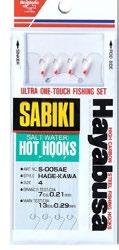

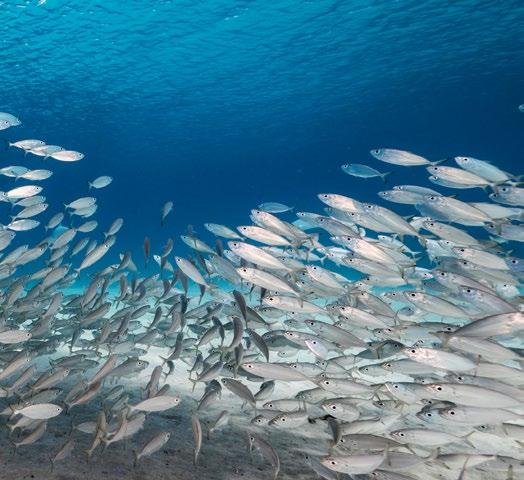 Schools of various baitfish are often found near piers .
Schools of various baitfish are often found near piers .
the right sinker for the job is important
imported sabiki rig for cigar minnows 36 March 2023 // GreatDaysOutdoors.com // 877.314.1237
Best quality
Choosing the Best Sabiki Rig to Make Bait
BY DAVID THORNTON
There remains a certain satisfaction in catching, that is ‘making’ your own bait .
When it comes to fishing fundamentals, no singular effort can be as rudimentary, or frustrating as the process of “making bait”. Even that term connotes that anglers are trying to create something from nothing, which at times may be all they end up with if they don’t have some of the basic tools and skills... needed to catch their own baitfish.
While many anglers are content to buy their bait from professional live bait dealers, others may trap, or castnet their own depending on what is available.
Depending upon the time of year and the habits of each potential baitfish species, one of the best bait gathering tools to use along the Gulf Coast is the so-called “sabiki rig”. This is a four to five foot long main line with a weight hanging below and a series of four to eight small “flies” tied off as branches. But not all sabiki rigs are made alike, nor intended for the same purpose.
The term “sabiki” (pronounced “sa-bee-kee”) originated in Japan in the middle 1970s. It is referenced to a specific brand name developed and marketed by Tajiri Hayato Shoten, the founder of Hayabusa Fishing Hooks Co., Ltd. Sabiki rigs were originally intended simply as a bait catching device. Nowadays the term “sabiki” has morphed to include any of the hundreds of similar multi-hook rigs from different manufacturers. They are intended to catch baitfish or small to intermediate sized predatory fish such as mackerel, jacks and bonito.
NOT ALL BAIT IS MADE ALIKE
Along the north central Gulf Coast, the most widely used baitfish species include Round scad (“cigar minnows”), Sardines (“Spanish Sardines”), and herring (commonly called “alewives” or “LYs”). During the warmer months of the year (March through November) these species commonly travel in relatively shallow water from three feet deep to three hundred feet deep. Often they form into large “shoals” or schools for feeding or spawning near the surface. They also gather for protection from a variety of predators from below including larger game fish (like mackerel), sharks and even dolphins. Baitfish mainly eat free-floating plank -
ton and the tiny eggs or fry of other fish species near or on the surface. So they tend to swim in unison with their mouths open to filter these mini prey items from the water. And they readily strike the small flies of the smaller sized sabiki rigs with a shallow presentation.
One of the trickiest things for American anglers to understand is the hook sizing difference between those made in Japan from the United States versions. Labeling numbers of smaller Japanese sabiki hook sizes (3 and 4) work best for smaller baitfish like cigar minnows, sardines or herring. These are equivalent to #16, #14 or #12 size hooks made in the USA. The main line and the branch line (to each fly) are made of very light monofilament (4 or 6 pound test) or even fluorocarbon so they don’t spook the small fish. The imported sabiki sizes 6, 8 and 10 respectively correspond to #10, #8 and #6 size USA hooks. These work better on mid-sized baitfish like “turbo cigs”, jumbo sardines and herring, or for small hardtails (like blue runners). Both the main line and the branch lines are made with slightly heavier mono to help prevent break offs. Break offs commonly occur when too many or too large of fish are pulling in different directions. Another inherent problem is the sharp teeth of small mackerel and bluefish cutting through the light lines. Not much can be done about these downfalls except to open your wallet and tie on another rig.
Some anglers do target spanish mackerel and bluefish with the larger sized sabiki rigs (4/0 to 6/0). These feature larger flies on heavier line (20 to 40 pound monofilament to better protect the inch and a half long lures from being bitten off by the toothy fish. They are also effective for non-regulated species such as blue runner (“hardtails”), and ladyfish (“skipjack”). Many times these intermediate predatory fish are used as bait (live, or cut) for even bigger gamefish ranging from “bull” redfish to sharks and even marlin.
Anglers even find sabiki rigs useful to bottom fish for pinfish, pigfish, grunts, croakers, kingfish (“whiting”) and even seatrout (“white trout”). All of these species, are commonly used as baitfish (whole or cut up) for larger offshore species like red snapper, amberjack and king mackerel. Simply
FISHING
877.314.1237 // GreatDaysOutdoors.com // March 2023 37


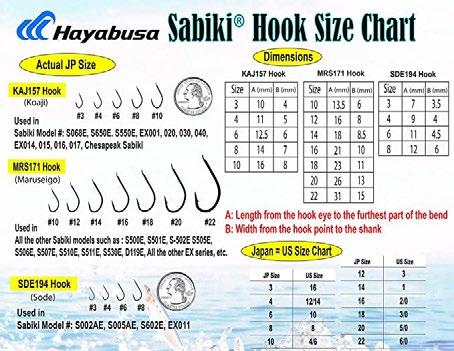
Show Your Support for Alabama’s Coastal Fishing & Marine Resources. All proceeds from your TAX DEDUCTIBLE purchase are used for marine conservation in Coastal Alabama. For more info on the events or CCA Alabama www.ccaalabama.org 251-478-3474 Choosing the Best Sabiki Rig to Make Bait
38 March 2023 // GreatDaysOutdoors.com // 877.314.1237
Compares Japanese to American hook sizes
adding a small piece of bait (shrimp, fish or squid) to the hooks, or even a small strip of synthetic bait like Fishbites gives the flies the added attractiveness of scent. Incidentally, a lot of spadefish are caught on small hook sabiki rigs tipped with ½ inch long slivers of Fishbites.
NOT ALL BAIT RIGS ARE MADE ALIKE EITHER
The use of sabiki rigs in the USA exploded through the late 1970s and 80s with a rush of imported and domestic versions. However, many of these brands lacked the quality in materials and workmanship of the original imported versions from Hayabusa. It was soon discovered the sabiki rigs that worked best for cigar minnows were made with “fish skin” on the smallest hook size available (3 or 4). And rigs made with a “glow bead” in front of the hook seem to attract more sardines and small jacks (Atlantic bumper and other “hardtails” or “yellowtails”) than cigar minnows or herring.
WEIGHTS THE DIFFERENCE?


Sabiki rigs perform best when the amount of weight allows a slow fall through the bait school in the conditions present. Too much weight, and the rig plummets through the school too quickly. Also a large splash and weight may spook skittish baitfish. But if the weight is too light, it tangles easily, rendering it useless. Choosing the style of weight can make a difference too. Teardrop shaped weights will usually perform better that pyramid shaped ones which offer more resistance underwater and slow the action. And the end of
a bank style sinker is often too large to fit inside the snap swivel at the end of the sabiki. The weight style known as “bass casting” is teardrop shaped and has a small brass ring that fits even the smallest terminal snap swivel.
USEFUL ACCESSORY ITEMS
The bait de-hooker is a handy little device with a short piece of non bendable wire with a curve on the end. The curve slides down the line to the mouth of the baitfish. Then with the flick of a wrist, the baitfish pops off the hook and falls into the bait well or bucket without any of its protective slime being removed. Such bait stays healthier longer and performs better. These cost only a few dollars.
The sabiki rod is a five foot long hollow tube with a mounted bait casting reel that safely stores the sabiki rig. The line comes off the reel and enters the tube through a small hole, then feeds through and out the other end. This way, the rig can be reeled into the tube for safe storage to prevent tangling and accidental hooking, which is a hazard of so many tiny yet ultra sharp fish hooks. They do cost in excess of $50, but that is recouped in being able to use the same sabiki rig for a number of fishing trips with added safety.
There remains a certain satisfaction in catching, that is “making” your own bait. And being able to do that efficiently, that is catching multiple baitfish on each drop minimizes the actual pre fishing time that can make, or break your day, and your budget.
Cables · Transmission Parts · Ring & Pinions, Axles · 4X4 Drive Shafts & Differentials Custom Built Control Cables · Complete 4WD Services · All Types of Parts Specializing in Agricultural Clutches and Drive Shafts Time to Get Your 4x4 Ready for Hunting Season 1159 South Broad St. MOBILE, AL 36603 1-800-239-2191 OUR LOCATION 251-433-3696 www.clutchproducts.com DIVISION OF CLUTCH PRODUCTS INC. & POWERTRAIN Choosing the Best Sabiki Rig to Make Bait
877.314.1237 // GreatDaysOutdoors.com // March 2023 39
Picking the Best food Plot for Deer in Spring and Fall
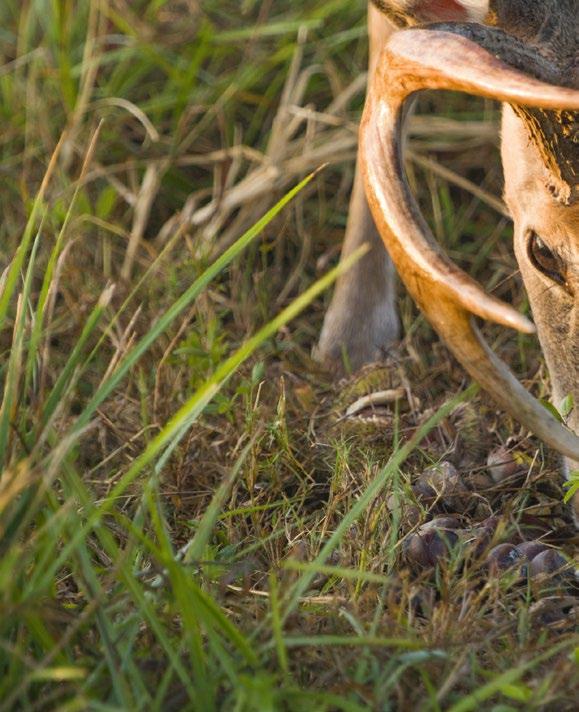 BY DAVID STRICKLAND
BY DAVID STRICKLAND
After your last deer hunt each year, do you review the highs and lows of the past season? Are you one of those hunters that immediately begin formulating a plan to draw more deer to your property next year? If so, now is the time to reevaluate your green field offerings and add year-round forage for your deer. You might also consider adding a more permanent solution by planting a few trees to add additional high-quality mast and maybe even a few varieties of plants for soft mast production.
Like many hunters, you probably view food plots as a place to sit in a shooting house, ground blind, or elevated stand with the hope of harvesting a trophy deer. Unfortunately, many hunters plant their fields to provide fall and winter forage but neglect them come spring and summer. However, newer planting options are available that many landowners may not have considered.
Evolving technology has contributed to many innovations that become apparent when one looks at the vast array of new bows, firearms, and even air-powered rifles offered to hunters each year. As a result, today’s hunter has more choices in their hunting clothes, gear, and blinds than any previous generation.
These choices extend to the variety of the seed and fertilizers they can use to attract and keep deer on their property. The hunters who educate themselves concerning the best available food plot options for their particular location can ensure that the deer will gravitate to their deer plots in the spring and utilize them through the fall into bow season. Deer need good quality forage all year, especially in late winter and early spring when does are heavy with fawns and bucks begin new antler growth.
40 March 2023 // GreatDaysOutdoors.com // 877.314.1237
In Alabama, deer have traditionally depended on the hard mast from various oaks to increase their fat stores to help them endure the winter months till springtime when everything greens up. Unfortunately, many oaks require at least 20 years to produce a decent crop of acorns, and peak production for some species takes about 50 years. Also, acorn production varies yearly, and deer prefer acorns with the least tannic acid.
Whether one is the manager of a large hunting operation or simply a hunter with one small field to plant, each has the same goal of drawing deer to a particular area by planting and fertilizing a variety of forage to attract and hold deer nearby.
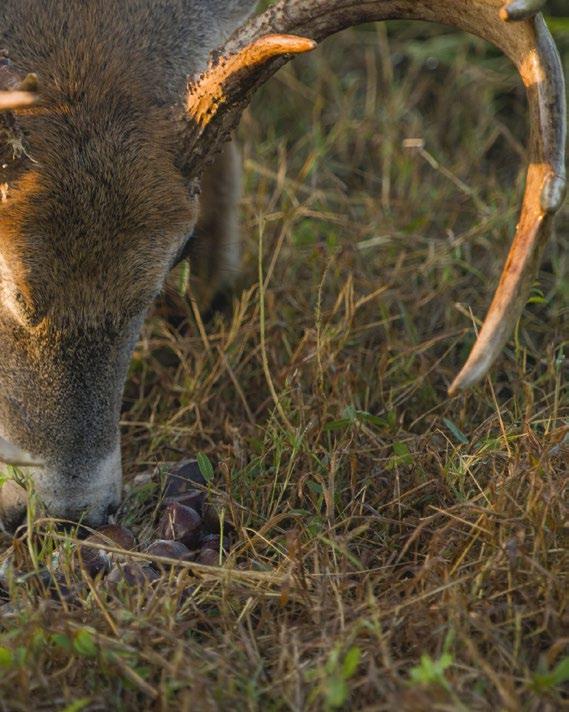
The availability and choices of what crops to plant for deer are so numerous as to be overwhelming. Many stores carry bags with exotic
Deer have historically preferred chestnuts over any oak species .
names and pictures of a large antlered buck on the front, but that’s no guarantee that those seeds will perform well where you intend to plant them.
The knowledgeable landowner will do annual soil testing to determine ph and soil type to help pick the appropriate seed and fertilizer for their plantings. Doing so will also help grow the healthiest does and biggest bucks while increasing the chances that their time and effort will result in some great memories and good stories shared around the supper table.
PLANNING THE BEST DEER FOOD PLOT
Research indicates that 1/2 acre is the average size of the typical whitetail food plot. Though their size varies greatly, most experts suggest a 1/4 acre minimum. Also, remember that if there are other plots nearby on adjoining property, it’s a good idea to find out what
HUNTING
877.314.1237 // GreatDaysOutdoors.com // March 2023 41
Picking the Best food Plot for Deer in Spring and Fall your neighbor’s plans are for his fields. It’s also helpful to know when they are planting.
Deer are similar to humans when it comes to food. We don’t mind experimenting, but we know what we like. Deer eat a variety of browse, plants, and acorns based on nutritional needs and taste. They need a certain amount of calories each day, and their feeding increases as the temperature drops.
Deer can be picky about their food sources and have preferences for what they eat throughout the year. That’s why planting additional nut-bearing trees on your property might be a viable option for some landowners.
TYPES OF FORAGE
The main categories of plants that most whitetail hunters plant are cereal grains, brassicas and legumes. Within these seed groups are varieties developed for specific soil types, ph tolerance, and latitude. So whether it’s along the Alabama Gulf Coast or into the Canadian interior, there are plenty of good choices when planting food plots for deer.
Brassica – is from modern Latin and can be translated as cabbage-like. This category includes leafy plants like turnips, radishes, kale, chicory, and canola, along with some newer additions. Brassicas do well in moist, welldrained areas and tolerate a broad pH range but require plenty of fertilizer to continue their growth into late winter. They are freeze tolerant and preferred by deer after the cold changes their starch to sugar. Food plots planted in brassica produce up to 10 tons of forage per acre, with crude protein ranging from 20% to 38%.
Cereal Grains – include wheat, oats, cereal rye, and triticale. Different cereal grains tolerate wetter soils (rye/wheat) and some do better in drier soils (oats/triticale). In higher quality dirt, choose wheat or oats. Rye does better in acidic, shaded, less fertile, or sandy soils. Triticale can perform
well in either situation but does better in loamy soils. Cereal grains provide great early fall options, stand up to heavy browsing, and provide 10-25% in crude protein.
Legumes – Lablab, soybeans, cowpeas, Austrian winter peas, clovers, and alfalfa are all legumes that produce their own nitrogen. They require a different fertilizer mix than cereal or brassicas, and some newer varieties of alfalfa can be grown as far south as the Alabama coast and Florida. They can be planted separately or in combination with other crops and do well in various soils. They are great for early plots, and some do well through cold weather but can be over-browsed if deer density is high. They range in crude protein from 20-30%.
THE SOUTHERN FEED AND SEED EXPERTS
One good source for the best seed choices for your spring and fall food plot is Southern Feed & Seed LLC. Roger Koehn began his business nearly 40 years ago in east Mississippi. It soon became a one-stop destination where local farmers could buy animal feed, fertilizers, and a wide variety of seeds for wildlife food plots.
They also developed specialty seed blends specifically for the climate and soil in Mississippi and Alabama. As a result, you can now find their products in over 150 locations in numerous states.
Caleb Weaver, who works with Southern Feed & Seed, has a ton of experience with the various soil types in Alabama and Mississippi and has experimented with combining seed blends that flourish in every kind of dirt between Yazoo City and Birmingham.
Weaver said that research indicates that bucks spend four times more time feeding in food plots than at feeders. So, it logically follows that green fields and seed choice should be the top priority of every hunter’s efforts to

Timeless Design

4500 Hwy. 77 • Southside, AL 35907 1-800-IMREADY • www.bucksisland.com Available at and Innovation
42 March 2023 // GreatDaysOutdoors.com // 877.314.1237
attract and feed their deer. In addition, Weaver recommends their exclusive blends for the landowner that doesn’t want the hassle of mixing several bags of grain and calculating the ratio and pounds per acre.

SOUTHERN BUCK SPRING & SUMMER MIX
This SF&S blend unique blend of seeds contains Brown Top Millet, Wild Game Sorghum, Stonewall Soybeans, Peredovik Sunflower, plus Iron and Clay peas. It provides a palatable and nutritious blend coated with Delta Seed Coat to ensure fast sprouting.
Their Spring & Summer Mix produces a unique blend of forage that attracts deer and benefits turkeys, quail, and doves. In addition, Southern Buck Spring and Summer Mix delivers much-needed nutrients to maintain your wildlife’s health and keep them coming to your property year-round.
Plant from early March thru July 15 for a plot that begins maturing 90 days and produces until the end of October.
SOUTHERN BUCK SUPERBUCK
Weaver said their Superbuck seed blend is a custom mix that contains wheat, forage oats, Austrian Winter Peas, Trophy Rape, Balansa Clover, Crimson Clover, Daikon Radish, & turnip. It provides early forage and will produce for 9-10 months. Weaver recommends a planting rate of 30-50 lbs per 1/2 acre.
SOUTHERN BUCK IDEAL
PLUS
Thei Southern Buck Ideal Plus is a mixture that works well in damp soil and contains wheat, oats, Balansa Clover, Crimson Clover, & Arrowleaf Clover. Ideal Plus will provide up to 10 months of forage, and the planting rate is 50 lbs per 1/2 acre.
SOUTHERN BUCK SELECT WITH SALAD BAR
Picking the Best food Plot for Deer in Spring and Fall the money spent on turkey permits, which is part of the licensing requirement to hunt turkeys in Florida, goes into that fund.
This mix contains a blend of Winfred Brassica, Hunter Brassica, Daikon Radish, Trophy Rape, wheat, oats, and rye. Blended specifically for the south and can be planted as early as September 1st for nutritious forage for the fall through May. It can be grown as a single plot mix or added to other mixtures to provide the needed protein for proper antler and body development. Recommended planting rate is 50 pounds per 1/2 acre.
Along with seed choice, planting time and fertilizer are critical aspects of good-quality food plots. Therefore, hunters should watch the weather forecast and plan their planting ahead of the rain.
“Many hunters and NWTF members are heavily involved in raising funds for the wild turkey and its habitat by participating in NWTF hunting heritage banquets, whereby a portion of those funds raised goes into the cost-share program,” Nicholson said. “Hunters’ purchases of hunting equipment also helps support wildlife conservation through the Wildlife and Sport Fish Restoration Program, which brings federal grant funding to state wildlife management agencies such as the FWC.”
FARMERS CO-OP
Wayne Gilliam is the manager of my local Tuscaloosa Farmers Cooperative and has been handling seeds and fertilizer for over 50 years. He’s seen the evolution in seed technology and knows what works in all soil types.
Through this combined effort from the NWTF, FWC, FFS and Florida turkey hunters, the wild turkey population is healthy and flourishing in Florida. And, if you’re a turkey hunter, then you must be getting excited because spring turkey season and the youth turkey hunt weekends are just around the corner.
Gilliam has sold hundreds of tons of seed and fertilizer, and he’s also a hunter who plants and experiments with various seed types and combinations on his personal hunting property.
Contact Information
Wild Turkey Cost-Share Program
Florida State Chapter of the National Wild Turkey Federation (NWTF)
Florida Fish and Wildlife Conservation Commission (FWC)
Florida Forest Service (FFS)
Gilliam emphasized that soil testing is the best starting point, and your local co-op can help with the sample and the solution for any soil corrections. His store also has specialized trucks equipped with spreaders and can deliver and spread lime for customers who need to adjust their soil ph. According to Gilliam, planting and fertilizing can be accomplished in various ways, and your local Farmers Co-Op can provide advice for any planting situation.
Green Swamp Wildlife Management Area (WMA)
Gulf Coastal Plain Ecosystem Partnership
Wildlife and Sport Fish Restoration Program
He said many farmers now use the newer no-till method, while others
Managing Wild Turkeys Through Teamwork 42 APRIL 2020 // GreatDaysOutdoors.com // 877.314.1237
877.314.1237 // GreatDaysOutdoors.com // March 2023 43
prefer the traditional route of mowing, spraying, plowing, fertilizing, then planting and covering. Gilliam emphasized that these methods are simply different ways to accomplish the same goal- planting the best seeds to attract and hold deer during the spring and fall while providing forage into the cooler months.
SPRING FIELDS
Gilliam said that hunters must plant in August or early September to have food plots ready for bow season in the middle of October. He recommends wheat and white clover for these early plots. (Ladino,
 White Dutch, Yuchi)
White Dutch, Yuchi)
According to Gilliam seed choice comes down to the soil type in each field and how well it drains, and with that knowledge, your local Co-Op can supply a custom seed blend for any of your plots.
BIG BUCK BLEND

Gilliam also recommends 3, 5, or 7-way Big Buck Blend with various seed mixes offered exclusively by your local Co-Op. Big Buck Blend contains wheat, oats, cereal rye, and various clovers that provide months of warm-weather forage.
He suggested that corn with planting dates as early as March and forage soybeans, iron clay peas, and sorghum are excellent producers for spring and fall when combined with existing clovers from fall.
Gilliam pointed out that the newer plant called Sunn Hemp is getting a lot of attention. It’s a prolific legume with growth rates of up to one foot per week and reportedly provides over two tons of forage per acre for deer. Sunn Hemp adapts to a wide range of soils if planted when soil temps reach above 50 degrees and grows well on well-drained soils with a pH of 5 to 7.5.
CHESTNUT HILL OUTDOORS
Chestnut Hill Outdoors has a different perspective on how a food plot should look. Iain Wallace is the company’s CEO, founded by his parents over 40 years ago. He recommends planting fruit and nut trees along with traditional food plots for longer-lasting results and a more wildlife-friendly environment.
Wallace revealed how his grandfather developed and patented a disease-resistant chestnut after a blight killed millions of trees throughout North America in the early 1900s. He also discussed how the American Chestnut had traditionally played a vital role in Native American culture and was an essential source of nutrition for numerous wildlife.
Wallace said that an acre of chestnuts annually produces 2,000 pounds or more nuts per acre, with more carbohydrates than an acre of corn! Chestnuts were once the favored fall food for many animals because the sweet-tasting nuts are high in protein and carbohydrates with no bitter-tasting tannins like acorns. He mentioned that European farmers once fed chestnuts to their livestock before butchering them to enhance their flavor.
Wallace said their trees produce chestnuts in as little as three years after planting in the spring or fall, and unlike oak acorns, they make nuts yearly that deer prefer over white oaks.
Food plot trees like the Dunstan Chestnut™, pear, persimmon, and crabapple have proven to increase a hunting land’s carrying capacity in the short and long term. In addition, their research says that adding nut and fruit trees to annual food plots provides significantly greater nutritional value for deer. Therefore, they feel every landowner should include their patented Chestnut trees as the best long-term strategy for attracting game to their property.
One advantage of incorporating more trees and shrubs on your property is that a single planting will provide increased food for your deer and other
ADVANCED FEATURES Learn More & Get One! The Ultimate Trail Cam Viewer A High-Speed Trail Cam Viewer That Really Works! LOWDOWNVIEWER.COM Contact us at: information@lowdownviewer.com • (715) 571-1694 • DEALERS WELCOME View a large number of images fast and easy Allows you to finger-zoom in on individual images 3x faster than any other trail cam viewer Software built for intuitive, simple operation Faster (HD) video-viewing (w/sound) No Wi-Fi or Internet . Works anywhere All full size SD cards . SD cards up to 128gb Universal Format system . Good for all cameras Built-in Navigation help system No more reading instructions
Picking the Best food Plot for Deer in Spring and Fall 44 March 2023 // GreatDaysOutdoors.com // 877.314.1237
wildlife year after year. Even though feeding habits vary throughout the season, planting additional hard and soft mast can help sustain your wildlife’s nutritional needs throughout the year. That’s why Chestnut Hill Outdoors provides specific tree varieties with varying early and late drop dates, ensuring that necessary nutrients are available at different times of the year.
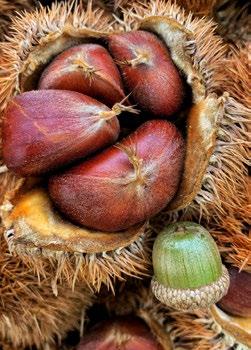
FALL PLOTS
Bow hunting for deer in Alabama has grown in popularity as more hunters look to get an early start with their whitetail season. Many clubs now cater to bow hunters, but establishing fields that draw deer in mid-October can be challenging. These early-season plots require careful planning, but a little sweat in the warmer months will lead to the best food plot for deer in the fall.
Planting winter peas and clovers that emerge quickly will provide early forage. Establishing a biennial clover plot in early fall can also provide excellent foraging opportunities through the winter into warmer weather.
CONCLUSION




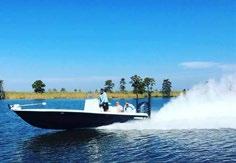






The many options available when choosing the best seeds or trees for your deer plots can be daunting, but a little research can help ease your anxiety. So now is a great time to test your soil and get a jump start on preparing those fields for the upcoming deer season.
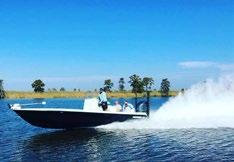
Capt. Richard Rutland 251.459.5077 richard.rutland@yahoo.comwww.coldbloodedfishing.com richard.rutland@yahoo.com www.coldbloodedfishing.com Speckled Trout Tripletail Redfish Flounder USCG Licen d & InsuredDauphin Island Alabama CAPT. RICHARD Capt. Richard Rutland 251.459.5077 richard.rutland@yahoo.comwww.coldbloodedfishing.com Speckled Trout Tripletail Redfish Flounder USCG Licen d & InsuredDauphin Island Alabama Inshore and Offshore Fishing Charters USCG Licensed & Insured Dauphin Island, AL Follow us on Facebook and Instagram @coldbloodedfishing Inshore and Offshore Fishing Charters USCG Licensed & Insured Capt. Richard Rutland Speckled Trout Tripletail Redfish Flounder Capt. Richard Rutland Inshore Fishing Guide Service 251.459.5077 richard.rutland@yahoo.comwww.coldbloodedfishing.com Capt. Richard Rutland Inshore Fishing Guide Service 251.459.5077 richard.rutland@yahoo.com www.coldbloodedfishing.com Speckled Trout Tripletail Redfish Flounder USCG License d & InsuredDauphin Island Alabama CAPT. RICHARD RUTLAND 251.459.5077 Capt. Richard Rutland 251.459.5077 richard.rutland@yahoo.comwww.coldbloodedfishing.com Speckled Trout Tripletail Redfish Flounder USCG License d & InsuredDauphin Island Alabama Inshore and Offshore Fishing Charters USCG Licensed & Insured AL Follow us on Facebook and Instagram @coldbloodedfishing Dauphin Island, AL Capt. Richard Rutland 251.459.5077 richard.rutland@yahoo.com www.coldbloodedfishing.com Follow us on Facebook and Instagram @coldbloodedfishing (251) 342-6672 • 5300 Overlook Rd. Mobile, AL ricciardonefamilydentistry@gmail.com Hours: Monday - Thursday 8am-4pm • Also call for info on extended hours Don’t let a toothache ruin your Great Day Outdoors Services: • Cleanings & preventive care • Crowns • Bridges • Veneers • Root Canals • Fillings • Implant restorations • Extractions • Dentures • Partial dentures • Teeth whitening • Botox We treat all ages Call us today for an appointment We accept most most dental insurances Important Contact Information Chestnut Hill Outdoors 1-855-386-7826 Alabama Farmers Co-Op 1-256-353-6843 Southern Feed and Seed 1-662-726-2638
Picking the Best food Plot for Deer in Spring and Fall Dunstan Chestnuts begin producing mast in as little as three years and produce every year 877.314.1237 // GreatDaysOutdoors.com // March 2023 45
How To Improve Wild Turkey Habitat with Trapping
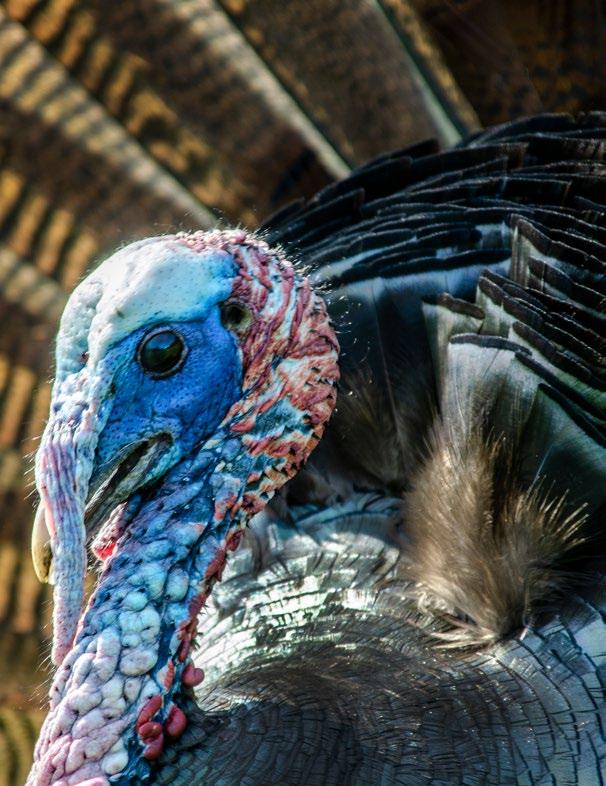 BY JOHN E. PHILLIPS
BY JOHN E. PHILLIPS
If you want to have more turkeys quickly, trap the feral hogs on your lands .
46 March 2023 // GreatDaysOutdoors.com // 877.314.1237
Scientists have learned that if you kill a feral hog, you immediately save 10+ wild turkeys.
Wildlife biologists and researchers long have known that feral-hog numbers detrimentally impact wild-turkey populations. These scientists have touted the advantage of feral hog removal to help more wild turkeys survive. Auburn University has conducted a new study for the past three years lead by research assistant Matt McDonough that shows several startling facts:
* Wild-turkey numbers increased by 70% when the number of feral hogs removed was equal to the initial population of hogs present;
* Wild-turkey numbers increased, sometimes drawing adult turkeys from other places, if the hog numbers were greatly reduced on a property.
* Landowners had to remove at least 50% to 70% of hog populations each year on their properties to bring the hogs under control.
* Pig-density reduction meant less turkey-nest predation and more acorns for turkeys and deer to eat.
WHAT AUBURN UNIVERSITY HAD LEARNED PREVIOUSLY ABOUT FERAL HOGS
Auburn University has long been interested in the correlation between feral hogs and how they affect croplands and the numbers of wild turkeys.
Dr. Stephen Ditchkoff, a professor of wildlife ecology at Auburn, has conducted numerous studies through the years on these nuisance animals and serves on several national committees studying the wild pig problem.
“About 47 of the 50 states have problems with feral hogs. The estimate of crop damage, which biologists believe is widely underestimated, is that besides killing wild turkeys and deer fawns just the annual crop damage from feral pigs is more than $1.5 billion,” Ditchkoff explained. “Texas seems to have the worst problem, and wild pigs also are creating many problems in Hawaii and California, as well as the Deep South.”
“Trapping is our best tool to eliminate hogs right now. Shooting hogs out of helicopters also has proven effective where the land is very open. But anyone who traps feral hogs must trap the entire sounder of pigs, a group of related female hogs and their offspring, for the trapping to be effective. And, the trapping must be done every year to keep the numbers of wild pigs in check,” he said.
HOW MCDONOUGH’S STUDY WAS CONDUCTED
McDonough had four separate study sites, ranging from 6,100 to 13,500 acres with feral-hog densities, all located within 15 miles of each other. One site was the control site where turkey populations were monitored, but hogs weren’t removed for comparison purposes.
McDonough had one camera for every 250 acres to monitor the turkey populations. The USDA’s APHIS Wildlife Services provided professionals to set-up remote-triggered corral traps for whole sounder removal and to shoot hogs from helicopters. The study learned that removing:
* 657 hogs from Site 1 equaled 226% of the initial hog estimate;
* 879 hogs from Site 2 equaled 125% of the initial hog estimate; and
* 315 hogs from Site 3 equaled 113% of the initial hog estimate
and significantly reduced the wild hog populations.
But McDonough also learned that these measures didn’t eradicate the hog problem, due to the rapid reproduction of hogs, although the numbers of wild turkeys improved. Each female wild pig could produce up to three litters per year with up to 12 piglets per litter, possibly resulting in 15-35 piglets per female wild pig (females are capable of reproducing at age 7 months) per year. When you compare those numbers to wild-turkey hens that each produce clutches of up to 14 eggs each per year, understanding the growing problem of nest predation by hogs and how that impacts wild-turkey numbers is simple.
What Are More Reasons to Trap Feral Hogs and Nest Predators
According to the National Deer Report presented by the National Deer Association, an average of 88% of the white-tailed deer harvest across the U.S. occurs on private lands. Texas reports the highest number of private land deer harvested at 99% with Alabama coming in at 95% for private land harvests of deer.
So, private landowners and lessees have the ability to make a huge difference in harvests of turkeys and deer. Each year, billions of dollars are spent clearing land, planting and fertilizing green fields, putting out feeders and raising crops for deer and turkeys on private lands. However, for a fraction of this amount, private land lessees and landowners can borrow, buy and/or rent corral traps to remove sounders of wild hogs off their lands and hire trappers to remove nest predators to greatly increase the numbers of turkey and deer on their lands. The Auburn University studies support the premise that trapping and removing feral hogs can aid in stopping the declining trend of wild turkey numbers.
Biologists also know that feral hogs:
* eat the acorns and other natural browse on which turkeys and deer feed; and
* will kill not only wild turkeys but also deer fawns at birth. When Forrest Armke, longtime ranch manager at the former Ford Ranch in Brady, Texas, instituted an intense hog-removal program there for four years, he saw a dramatic increase in deer and turkey population numbers. He continued to remove feral pigs from the property for years and thereby increased the numbers of fawns and turkeys.
HUNTING
877.314.1237 // GreatDaysOutdoors.com // March 2023 47
How to Trap Feral Hogs with Dr. Stephen Ditchkoff
1) Use bait and trail cameras to find a group of hogs coming in and feeding on that bait.
2) Try to identify each pig in that group of hogs once you have trail-camera pictures of all the hogs in the sounder to know that the sounder is composed of perhaps 8 individuals, 10 individuals or possibly 12 individuals. You need to be able to determine if there’s 6 or 8 adult individuals, or perhaps 4 to 5 juvenile pigs in that sounder.
3) Build a trap that will hold the entire sounder, start baiting the trap, and watch the hogs coming into the trap. You continue that baiting with the door to the trap up and open, so the pigs can get to the bait. Don’t try to catch the hogs, until you’re absolutely sure you have all the individual hogs from the sounder in that trap.
4) Use a remote device that will drop the door to the trap once all the hogs in the sounder are inside the trap. New types of traps and doors can send pictures to your cell phone, computer, tablet or other device, so that you can see how-many hogs are in a sounder and identify the hogs in the trap. Once you’re convinced you’ve got the entire sounder, you can activate the app on your phone, which automatically will drop the door on the trap, preventing the pigs from getting out.
5) Go to your trap, dispatch all the wild pigs, take them out of the trap, and dispose of them.
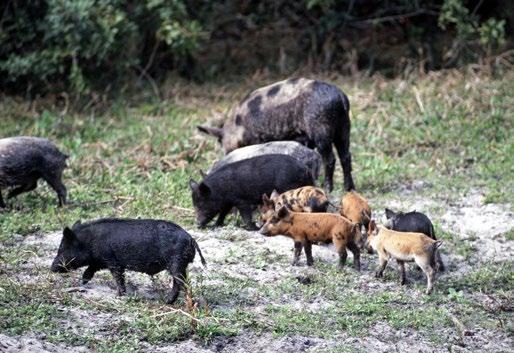
6) Continue to bait the trap to make sure that you’ve eliminated every hog in that sounder.
Another type of feral-hog trap uses a feeder, a camera and a drop gate to catch a sounder of feral pigs to be removed

How To Improve Wild Turkey Habitat with Trapping
A sounder of pigs like this can devastate wild turkey populations
48 March 2023 // GreatDaysOutdoors.com // 877.314.1237
WHAT A PROFESSIONAL TRAPPER HAS LEARNED ABOUT PREDATORS IMPACTING WILD-TURKEY NUMBERS
Tad Brown of Missouri has been an avid turkey hunter for 45 years and a trapper for 50 years. Like many of us, Brown realizes that turkey populations have been on the decline for several years now and believes the increasing numbers of nest predators has detrimentally impacted wild-turkey numbers.
“I know that every furbearer I take that’s not a water animal eats turkey eggs, turkey poults and turkey adults. The numbers of trappers have decreased each year with fur prices so low, which definitely has increased furbearers’ numbers,” he said. “You must continue trapping every year to stay ahead of the declining numbers of turkeys with wild hogs being the biggest culprit. But I also know bobcats, coyotes, snakes, opossums, crows, skunks, feral cats, feral dogs and armadillos all love to eat turkey eggs and turkey poults. However, I’m convinced that raccoons are particularly a tough predator on turkeys. Raccoons are very prolific, they’re aggressive and strong, and they can muscle a hen off her nest to kill her and eat her eggs.”
HOW A LANDOWNER OR LESSEE CAN IMPROVE WILD-TURKEY NUMBERS
The quickest way to have more turkeys to hunt on your lands is to conduct a hog-removal program before turkey season and a trapping regime of these other nest predators before and after turkey season. Although improving habitat for turkeys and planting small-grain green fields also helps your property to produce and hold turkeys, predator removal, particularly of wild hogs, appears to be the quickest way to have more turkeys in the least amount of time. As a landowner or a property lessee, to have more turkeys and deer, consider removing as many feral hogs as possible, as well as nest predators.
You can contact the National Deer Association at https://deerassociation.com/ and/or go to the information about wild hogs at https:// deerassociation.com/to-hear-more-gobblers-stop-the-squeal/ to learn more.
Editor’s Note: Author and longtime, avid turkey hunter John E. Phillips has written 8 books on turkey hunting and his 9th turkey-hunting book, “Turkeys: Today’s Tactics for Longbeards Tomorrow,” will be available in the spring of 2023 at www.amazon.com/author/ johnephillips. One of his well-known books is “The Turkey Hunting Guides’ Bible”
How Science Is Helping to Eliminate Feral Pigs
“In the next five years, scientists hope to eliminate large numbers of wild pigs by using a toxicant that’s being developed. The U.S. Fish and Wildlife Service is testing sodium nitrite in bait and by using feeders to give the Environmental Protection Agency evidence to manage and reduce feral pig populations,” Ditchkoff said. “This process probably will take five years more of study. The sodium nitrite operates similarly to carbon-monoxide poisoning by asphyxiating the pigs, and then they just go to sleep and don’t wake up.”surviving on the ranch.
BY MICHAEL PENDLEY Recipe and image courtesy of Realtree. www.realtree.com
Easy Skillet Wild Turkey and Broccoli

Prep: 15 mins • Cook: 20 mins • Total: 35 mins
Ingredients
• 1-pound wild turkey breast, thinly sliced across the grain
• 1 tablespoon cornstarch
• 2 tablespoons soy sauce
• Olive oil
• 1 onion, thinly sliced
• 4 cups of fresh broccoli
• Salt and pepper to taste
Sauce
• 1/2 cup beef stock
• 1/4 cup soy sauce
• 4 cloves garlic, finely chopped
• 1 tablespoon fresh ginger, grated
• 3 tablespoons brown sugar

• 1 tablespoon cornstarch
Instructions
1. Slice the turkey into thin strips, going across the grain for tenderness.
2. Whisk the cornstarch into the soy sauce and then stir it into the sliced wild turkey breast. Set this aside.
3. Pour over the cornstarch and soy mixture and stir to coat the turkey.
4. Heat the oil in a large skillet over medium-high temperature. Add the wild turkey and sauté the meat for 4 to 6 minutes or until just about cooked through. Remove the turkey from the skillet and set aside.
5. Sauté the turkey until just cooked through, then remove from the pan.
6. Add more olive oil to the skillet if necessary. Add the sliced onion and cook for 4 to 6 minutes or until the onion is soft and translucent. Add the broccoli. Continue cooking another 4 to 6 minutes or until the broccoli is cooked through but still crisp. Return the turkey to the skillet.
7. Return the turkey to the pan with the vegetables and stir in the sauce.
8. Whisk the sauce ingredients together. Pour the sauce into the skillet and continue cooking a few more minutes until the sauce thickens. Check for flavor and season with salt and pepper, if needed. Serve over rice or noodles.
How To Improve Wild Turkey Habitat with Trapping
877.314.1237 // GreatDaysOutdoors.com // March 2023 49
How to Stock F1 “Tiger Bass” in your Pond
 BY WILLIAM KENDY
BY WILLIAM KENDY
50 March 2023 // GreatDaysOutdoors.com // 877.314.1237
If you live in the southeast and have a pond that you envision to be your “trophy fish factory” then it will only be a matter of time before you think about stocking some largemouth bass that will aggressively and continuously hit lures and baits, are hardy enough to survive the occasional winter temperature dips and grow quickly, as to the tune of one or even two pounds or more per year.

To get more insight into that route I spoke to Brian Senn, host of the Great Days Outdoors weekly Alabama Freshwater Fishing Report. Senn has interviewed a number of sources regarding growing trophy bass in ponds and knows all about largemouth bass strains.
BASIC BASS BACKGROUND
Senn pointed out that there are three types of largemouth bass; the native or “Northern” strain, the “Florida” strain and the “F1 Largemouth” strain, commonly referred to as “Tiger Bass”. F1s are the product of breeding a Northern and Florida strain bass.
Northern (Native) Largemouth Bass
• Northerns are tough fish that can survive in a wide range of water temperatures from “ice over” to warm summer water.
• They have relatively fast growth rates that, depending on the pond’s forage fish base and if there are supplemental feeders utilized, can range up to two pounds a year. Even with relatively fast growth, the Northern strain bass rarely get over 10 pounds.
• They readily strike lures and baits and are naturally aggressive.
Florida Strain Bass
• Perfect for warm climates but not great for surviving colder weather conditions.
• They add weight quickly and consistently, even in older age and can get up to the 20-pound trophy level.
• When the water temperature drops, they become more lethargic and tend to lose aggressiveness in terms of biting lures and baits.
F1 Largemouth (Tiger Bass)
This is a hybrid mix between a Northern bass and a Florida bass and the result is the best of both strains.
• Can survive colder water better than Florida bass.
• Consistent growth rate over a longer period. F1s, like Florida bass, can grow upwards of 20 pounds and in well managed ponds can add two pounds
FISHING 877.314.1237 // GreatDaysOutdoors.com // March 2023 51
How to Stock F1 “Tiger Bass” in your Pond a year. The U.S. record largemouth bass weighing 22 pounds 4 ounces was caught in Lake Montgomery, Georgia in 1932 is thought to be a cross between a Northern and Florida bass.
“They are aggressive feeders (not as aggressive as the Northern strain) and make for a good fishing quarry but they lose some of that aggressiveness as they mature and are a bit more reluctant to hit lures and become harder to catch. Consequently, you may need to restock them every four to six years to maintain the vigor of the Tiger population,” Senn said.
SETTING THE STAGE
When you fish your pond and find that all you are catching are “skinny bass” in the 10–14-inch range that all weigh about a pound or so, chances are good that your pond is “forage deficient” and “bass predator crowded”. That means that the pond is out of balance in terms of the number of hungry bass and the amount of forage food available for them to eat in order to become lunkers. It takes a lot of threadfin shad and bluegill fry to get a bass to grow to trophy size. It is a supply and demand scenario and easy to grasp but not so easy to implement.
Norman Latona is the founder and owner of Southeastern Pond Management, headquartered in Calera, Alabama with offices in two other states.
Southeastern Pond Management offers full-service pond management services including fish stocking, fertilizing and weed control, electrofishing, pond design and construction and more.
“If you are catching a fish that has a bucket mouth, a fivepound head and yet he weighs a pound and a half or catch a fish that weighs two pounds that isn’t plump and has a sucking belly, there probably is a balance issue,” Latona said.
“That is what we refer to as bass or predator crowded and it is the most out-of-balance condition we run into,” he said. “The fish may be easy to catch, but it is frustrating and not that much fun when small bass is all that you catch.”
Latona points out that bass are like aquatic “saber-tooth tigers’ in that they are voracious feeders and if there are too many of them, they will eat themselves out of house and home. The result is a bass population of a bunch of “stunted” small fish.
In a nutshell, to fix this problem you need to make a concerted effort to reduce the number of predator bass per acre, either by time and effort intensive “hook and line” methods (fishing) or the more efficient electrofishing, for which Southeastern Pond Management has the equipment and expertise to do Once the predator population is at a manageable level then you can concentrate on the forage fish base.
“We utilize electrofishing and we can be very selective. It doesn’t hurt the fish. It just stuns them and we can pick and choose which fish we take out. So, in that respect, it’s probably even a better approach than hook and line and the process doesn’t damage any fish that we don’t want to remove,” Latona explained. “Electrofishing doesn’t really discriminate, it removes fish, not just the aggressive fish, not just the fis h that don’t tend to be aggressive, we just select based on size. Obviously, we don’t take the seven to nine-pound fish, since
these are the ones we are trying to produce.”
That is a bare bones explanation of the logistics of a healthy fish pond. Changing gears, if your pond is in balance and your goal is to manage that water for really big bass, as in 8-10 pounds or more, then it entails a paradigm switch.
WHEN IS THE BEST TIME TO STOCK AND WHAT SIZE FISH?
Both Latona and Senn pointed out that generally, the best time to stock Tiger bass is in the spring and early summer and, to avoid winter and high summer periods, which are greater fish stress times in order to keep mortality rates down.
The stocking issue is easier if you have a new pond then an existing one. In a new pond there aren’t any predator fish present and it makes sense to stock your forage fish (bluegill and threadfin shad) first to allow them to get a solid base established before you introduce the bass predators. In an existing pond with a decent forage base, it is a good idea to remove as many of the “resident” predator bass as possible before you add the Tiger bass… and the reason is size.
Senn said that in discussing this issue with a number of different sources, that the typical size of a Tiger bass brood fish is one to three inches which is the perfect size for dinner for resident predator bass. That defeats the whole purpose of introducing the new strain if they are going to be eaten before they can grow.
“The typical size of a Tiger bass fish is one to three inches and the normal rate of stocking for that size fish is 50 to 100 per acre. Now if you haven’t reduced the predator bass presence in the pond it makes sense to stock Tiger bass in the bigger six-to-eight-inch size so they won’t get gobbled up by the resident bass and more will survive.”
“I’ve found that, in general, the cost of a one-to-three-inch Tiger bass is about $1.50 and for the six-to-eight-inch stock is about $6.00. So for a three-acre pond at 100 small fish per acre it will cost you $450.00 but if you stock the larger fish at only 50 per acre the cost is twice that. It is a tradeoff depending on the situation. Southeastern Pond can help you determine the best route to take and advise you on the predator fish to forage fish ratio to get everything in balance and can help you fine tune your pond depending on your goals.”
Contact Information Southeastern Pond Management www.Sepond.com 205-288-1371 Texas Hunter www.texashunterproducts.com (210) 734-5189 52 March 2023 // GreatDaysOutdoors.com // 877.314.1237
If you are serious about managing your pond for trophy bass it makes sense to have experts professionally stock it .
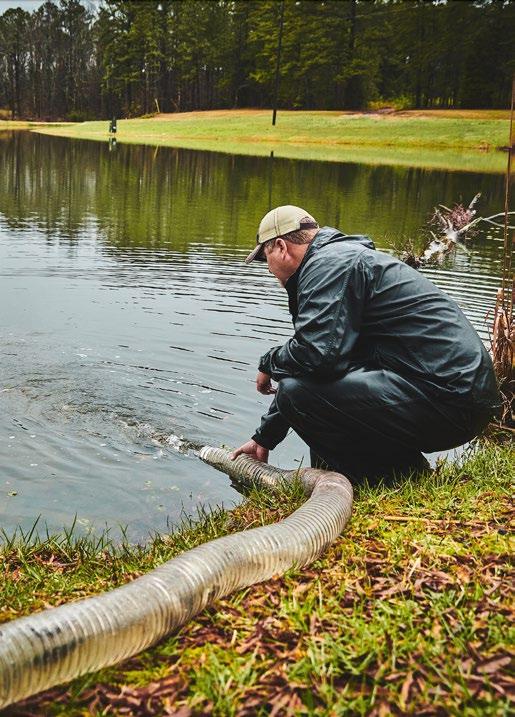
877.314.1237 // GreatDaysOutdoors.com // March 2023 53
The trees that Winks hides behind to hunt squirrels he often uses to brace for his shots .
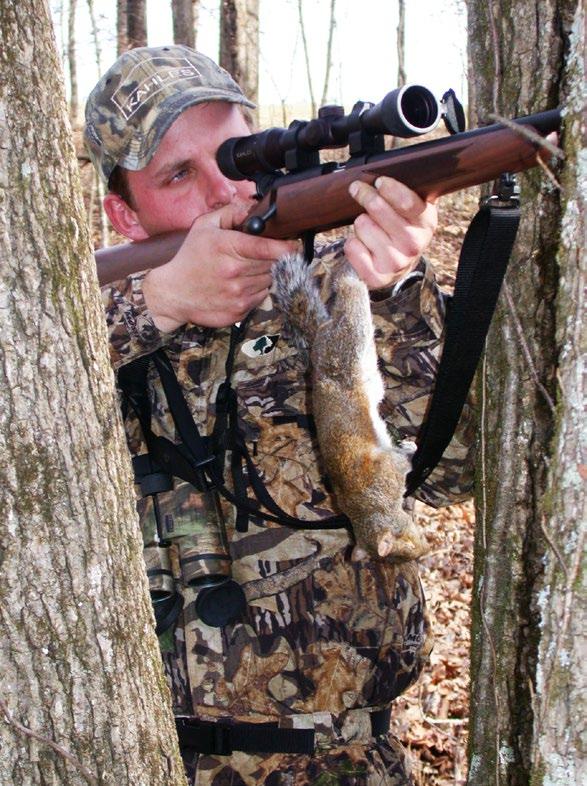
54 March 2023 // GreatDaysOutdoors.com // 877.314.1237
Squirrel Hunting with the Experts
BY JOHN E. PHILLIPS
A squirrel laying on a limb is a very-small target, so you must shoot accurately each time you squeeze the trigger.
“Hunting squirrels can teach you everything you need to know about hunting,” my friend Eddie Winks told me and he has taken the sport of squirrel hunting to an expert level. “You first need to know where to find squirrels. Squirrels prefer nuts of all kinds to eat, especially big ones like overcup and white oak acorns. Later in the season, squirrels enjoy red oak acorns as the larger ones are usually gone by then. Also, deer love acorns too, so, where you discover squirrels, you’ll locate deer.”
Before a squirrel hunt, Winks advised me to pinpoint squirrels’ locations where I found uneaten, partially-eaten or fully-eaten acorns. Then he told me his expert tactics for taking squirrels.
Eddie Winks
*Create a Path, Circle the Area, and Have Patience - Winks was one of the most-meticulous and successful squirrel hunters I ever knew. Once he found an area with squirrels, he’d use a yard rake to move the leaves away, exposing the ground. He’d create a path to work around and through where he’d located squirrels. Winks always made sure the path he’d cleared went past several large trees that he could hide behind.
With this strategy, he’d reach the first tree he wanted to hunt from and wait on daylight. He’d sit on a cushion to remain noiseless. He’d locate squirrels with barking and whining calls and the Mr. Squirrel Whistle. After he shot one or two squirrels, and the bushytails vanished, he’d move 30-50 yards to his next tree, making sure that the squirrels hadn’t spotted him. He’d then use a cutting call (a plastic screw with a plastic paddle) and pull the paddle down the plastic screw to make the sound of squirrels cutting acorns – calling softly and infrequently to make squirrels show themselves in the trees.
“You often can get two, and if you’re lucky, sometimes three squirrels, before they all scurry to their hiding places and seem to disappear,” Winks mentioned. “The next step is patience, much like when you’re turkey or deer hunting. Most often, the squirrels will reappear in 10-20 minutes after you harvest the first few squirrels. Then, you can continue to take them, if the area’s heavily populated with bushytails. I’ll usually circle the entire area where I’ve seen the largest concentration of squirrels.”
*Stalk Slowly: Once Winks cleared a road of sticks and leaves, then he’d walk slowly - stalking like a leopard prowling for his prey. Dressed in camouflage from head to toe and using his 8x10 binoculars to scan the ground and tree tops in front of him, he’d plan his route to keep the squirrels he hoped to bag from seeing him as he approached.
*Know Your Rifle’s Bullet Drop: “Because you never know what distance you’ll be from bushytails, a critical factor in successful squirrel hunting is to know the bullet drop of your rifle at distances from 10-50 yards,” Winks ex-
plained. “A squirrel laying on a limb is a very-small target, so you must shoot accurately each time you squeeze the trigger.”
*Use Double Barking: Squirrels bark to let each other know where they are and to signify danger like predators or other critters moving on the ground. When squirrels bark, they give away their locations, making them easier for the hunter to find and take.
Double barking was a technique that Winks used often when hunting with friends. He’d place one friend 50-75 yards from him. If he was hunting with more than one friend, he’d have each hunter at roughly that same distance from him. One hunter would use a bellows-style squirrel call to bark like a bushytail. A few minutes later and/or immediately after the hunter barked, one of the other hunters would give the same call. Often, this technique would cause squirrels to come out from their hiding places and start barking back at the hunters. When this strategy was used in areas with an abundant squirrel population, each hunter would have an opportunity to bag squirrels.
*Know When to Use What Tactics: Most often, your best opportunity to take squirrels is when the leaves begin to fall. They’ll feel comfortable in the trees because the leaves provide some cover. One of the most-difficult yet fun times to take squirrels is when the leaves are off the trees, and squirrels can spot the hunter’s moving. So, don’t forget to stalk through the woods - especially early in the morning and late in the evening when the squirrels come out of their trees and are hunting acorns on the ground.
When the leaves are off the trees, and you’re hunting later in the season, hunting squirrels with a dog is much-more productive than stalk hunting or stand-hunting and is a much-easier and fun way to find and take them. A productive dog hunt usually starts later in the morning, an hour or two after daylight, or earlier in the afternoon when there are two to three hours of daylight left. At that time, squirrels generally will be out of the trees and feeding on the ground. A dog will pick up their scent, follow them to a tree and bark – telling the hunter which tree to look for the squirrel.
Winks considers dog hunting for squirrels the most enjoyable because he can train children how to squirrel hunt easily with dogs that will discover and bark to let hunters know the trees where the squirrels are.
Dr Robert Sheppard
Very-few squirrel hunters are as passionate about taking bushytails as Dr. Robert Sheppard of Tuscaloosa, Alabama. He’s as meticulous about finding about the very-best equipment he can choose for hunting squirrels, as he is practicing medicine.
* Guns: Today Sheppard hunts squirrels with four rifles: the Kimber .17 22
HUNTING
877.314.1237 // GreatDaysOutdoors.com // March 2023 55
Long Rifle (LR) that’s necked-down to a .17 caliber bolt-action squirrel rifle that costs about $1000 brand new; a Browning A Bolt in 17 HMR by Hornady Rimfire that costs about $800 brand new; a Kimber .22 Long Rifle (LR) Bolt Action; and a Browning T-Bolt .17 caliber.
“Over the years, I’ve bought about 50-different squirrel rifles because I love to squirrel hunt,” Sheppard explains. “I’ve continued to test squirrel rifles, until I’ve found the one that I feel is the most effective and accurate. My perfect squirrel rifle, for me, is the Kimber .17 caliber.”
Sheppard reports that Savage makes a much-less-expensive .17 caliber gun that’s about half as accurate as the Kimber Bolt, delivering a 1.5-inch group at 50 yards. The Kimber shoots a 0.25-inch group at 50 yards.
The .17 caliber rifle and bullet, even though smaller than a .22, is capable of downing almost any varmint from an armadillo and coyote size down to the size of a rat. Dr. Sheppard emphasizes, “Using a turrets’ style scope on my Kimber .17 that calculates my bullet’s performance at different distances means I don’t hesitate to shoot a squirrel out to 100 yards or a coyote out to 200 yards.”
* Ammunition: Sheppard prefers the .17 caliber ammunition over the .22 caliber when hunting squirrels. He reports that he’s killed several thousand squirrels with his Kimber .17. “If you’re serious about squirrel hunting and shoot .22 ammunition, you’ll see that the arc the bullet travels drops-off at about 40 yards. If you don’t know the distance you are from the squirrel, the tendency when shooting .22 ammo is to either shoot over or under the squirrel. A .22 rifle takes squirrels perfectly at 30 yards. However, at less than 30 yards, the bullet will drop or rise before it reaches the squirrel.”
Sheppard mentions that shooting squirrels after the leaves fall off the trees
means you often must shoot them at a further distance than when the leaves are still on the trees. Sheppard explains he’s had to modify his squirrel hunting somewhat due to health issues. He now takes a folding chair to sit in when hunting squirrels and uses a two-legged shooting stick as his brace. When a squirrel comes out, and Sheppard can see it with his binoculars or hears the squirrel bark or squeal, he doesn’t have to hold over or under to make an accurate shot - even at a squirrel 100-yards away - by shooting .17 caliber cartridges.
“In 2007, Hornady created a .17 caliber cartridge with a muzzle velocity that moved 2000 feet per second – a .22 Magnum cartridge, necked-down to a .17 caliber. When I bought a rifle that shot .17 caliber bullets, I saw that it was much more accurate at longer ranges than a traditional .22 cartridge. The Hornady Magnum Rimfire (HMR) .17 caliber has almost the same velocity as a .308 Winchester,he explained. However, this much-smaller .17 caliber bullet travels faster and shoots flatter out to about 100 yards then a .22 traditional cartridge does. The .17 caliber is being pushed out of the rifle at 1.5 times the speed of sound. Therefore, the bullet hits the squirrel long before the sound of the bullet’s being fired reaches the squirrel. I don’t believe any cartridge made for a squirrel rifle is as fast and as noiseless as a .17 caliber.”
* Rifle Scopes: Sheppard prefers two rifle scopes - a Nikon and a Leupold. On his Browning A Bolt .17 caliber, he’s mounted a Leupold scope made with ballistic tabs built into the scope. This turret on top of the scope can be turned, and the scope will be automatically adjusted, so you can hold it on target out to 300 yards. This scope retails for about $1000.
From Eddie Winks we’ve learned expert tactics to take squirrels, and Dr. Robert Sheppard has explained the best rifles, ammo and rifle scopes that the most-serious squirrel hunters use.
 Here are a variety of squirrel calls to consider using . Left to right: a bellows-style barker; a squirrel squealer; and the two pieces of the plastic screw and paddle to make the sounds of a squirrel cutting nuts
Here are a variety of squirrel calls to consider using . Left to right: a bellows-style barker; a squirrel squealer; and the two pieces of the plastic screw and paddle to make the sounds of a squirrel cutting nuts
with the Experts 56 March 2023 // GreatDaysOutdoors.com // 877.314.1237
Squirrel Hunting
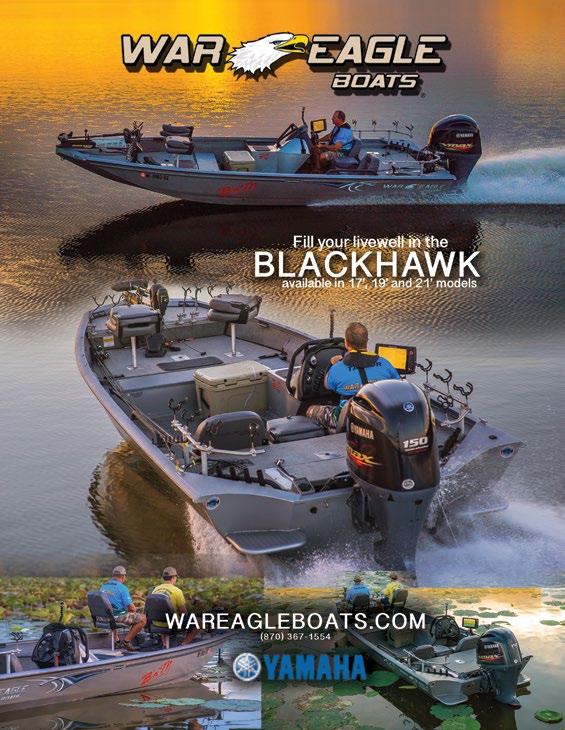
877.314.1237 // GreatDaysOutdoors.com // March 2023 57
Pine Nut Cookies

Prep: 20 mins • Cook: 12 mins
• Total Time: 32 mins
Ingredients
• 1 teaspoon finely chopped fresh rosemary (optional)
• 2/3 cup sugar, or light brown sugar
• 10 ounces almond paste, or acorn paste (see above)
• 1 cup pine nuts, toasted (4 ounces)
• I egg white (maybe 2, see below)
• A pinch of salt
Instructions
1. Preheat your oven to 325°F. Line a baking sheet with parchment paper or a Silpat.

2. Buzz the sugar, 1/3 of the pine nuts and rosemary together in a food processor until you get small bits of pine nuts and rosemary sugar. Don’t process into a paste. Pour the mixture into a bowl and add the almond or acorn paste, salt and egg white. Mix into a paste. You want this to be wet but workable. Sometimes you need a second egg white.
Option 2:
1. Start with the 2 egg whites and, if you need it, add a tablespoon or 3 of allpurpose flour so you can form balls with your hands. I prefer this, but the cookies will no longer be gluten-free.
2. Divide the dough into 12 to 16 pieces – or about a heaping tablespoon per cookie – and roll with moistened hands. Gently set a cookie ball onto the whole pine nuts, rolling to coat. Set the cookie on the baking sheet. If rolling the dough in the pine nuts proves difficult, you can set pine nuts on top of each cookie after it’s on the baking sheet.
3. Bake the cookies for 15 to 18 minutes, until you see just a bit of browning. Let them cool on the cookie sheet for a few minutes, then dust with confectioner’s sugar if you want to. Move them to a rack to cool thoroughly. They should keep in an airtight container for 3 to 4 days.
Notes
If you happen to use marzipan, the additional sugar in it will make the cookies browner, so don’t pull them before 15 minutes.
58 March 2023 // GreatDaysOutdoors.com // 877.314.1237
Beer Braised Short Ribs
Hunters can also use large ribs from elk, moose, nilgai or oryx. In the case of elk or moose, you will want to trim most of the fat because it can get waxy as it cools.
The beauty of beer braised short ribs is its simplicity. Similar to Lancashire hotpot, this recipe relies on only a few ingredients, all of which should readily available all over the country.

Ingredients
• 2 heads garlic
• Olive oil for drizzling
• 4 pounds short ribs
• Salt
• 4 cups sliced yellow onions
• 1 tablespoon flour
• 1 to 2 bottles dark, malty beer (see above for styles)
• 1 tablespoon juniper berries (optional)
• 1 tablespoon dried marjoram or lovage
• 2 tablespoons Dijon mustard
• A splash of Worcestershire sauce
• black pepper
Instructions
1. Preheat the oven to 350°F. Slice the top third of the heads of garlic off. Set them in a foil packet. Drizzle some olive oil over the cut tops, then close up the packet. Pop into the oven for 1 hour. If this is the first thing you do, you will be mostly done chopping and browning things by the time it’s ready.
2. In a large Dutch oven or other heavy, lidded pot, sear the short ribs over medium-high heat, starting with the fattiest side down. This renders fat for browning everything else. If you are using elk or moose ribs, or your ribs aren’t fatty, add some olive oil, lard, bacon fat or butter. Salt the ribs as they cook. Brown them well on every side except for the side that’s just bone and membrane. Take your time and do this in batches if need be. Remove the browned ribs for now.
3. When all the ribs are done, add the sliced onions, some salt, then brown them well. You might need to add more fat or oil. This step can take a solid 10+ minutes. When this is done, check the garlic to see if it has browned and softened. If not, wait until the garlic is ready before proceeding. Just turn the heat off the pot.
4. When you are ready to add the garlic, squeeze it into the pot, stir and add the flour. Cook this over medium heat for a few minutes. Again, this step takes some time because you want the flour to brown. If you use Wondra flour you’ll save a few minutes.
5. Once the flour has browned, add some beer to the pot and use a wooden spoon to deglaze it. Add the remaining ingredients, stirring well, and then return the ribs to the pot. If the level of beer isn’t up to the top of the ribs, add some water or stock. Cover the pot and put in the oven, which should still be hot from the garlic. Drop the heat to 300°F and simmer for at least 2 hours, and in some cases as much as four hours. (Five hours is not unheard of, but is rare.)
6. When the ribs are tender, gently remove them to plates. Add salt and black pepper to taste, then spoon sauce over them. Serve with mashed potatoes or other root vegetables, bread or roasted root vegetables.
CAMPHOUSE KITCHEN 877.314.1237 // GreatDaysOutdoors.com // March 2023 59
NEW & Cool gear
BY WILLIAM KENDY
Rocky® Men’s Waterproof Snake Boot
The 16-inch-high Rocky® Waterproof snake boot sports a Denier Cordura upper with a Terra Suspension footbed for support and comfortable cushioning. It has a side zipper for “easy on and off” process and a waterproof construction that ensures dry feet regardless of whether you are traversing swamps, marshes or other wetlands and offers rugged protection from snake bites and nips from other critters.
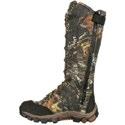
Suggested Retail Price: $177.00 www .rockyboots .com
Savage 110 Carbon Predator Bolt Action

The Savage 110 Carbon offers an adjustable AccuTrigger that can be adjusted down to a 1.5 trigger pull for ‘spot on’ accuracy and is paired with a carbon fiber wrapped stainless steel barrel with a threaded muzzle. It comes with a AICS detachable magazine along with a black granite textured adjustable stock in seven calibers weighing in at under seven pounds.
Suggested Retail Price: $1,695.00
www .savagearms com
ALPS OutdoorZ Introduces the Upland Game
Vest X 2.0
Designed for optimal comfort the new Upland Game Vest is the ultimate in game vests. It has an expandable and removable 26-to-62-inch waist size belt and wide and adjustable shoulder straps to accommodate whomever is wearing it. All that along with a vented back in a lightweight package including a 17-inch rear storage compartment and an oversized game pocket.
Suggested Retail Price: starting at $199.99 www .alpsoutdoorz .com

Millennium Ground Blind Chair Gets a Fresh Look
The stable four legged Millennium G-450 ground blind chair can quietly swivel 360° and has a height adjustment of 3.5 inches. Its aluminum powder-coated frame comes equipped with an adjustable padded shoulder carry strap and weighs only 7.9 pounds light enough to do “running and gunning” if needed and can accommodate hunters up to 400 pounds. It comes in Mossy Oak® Bottomland camo pattern.
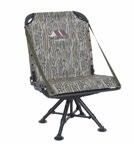
Suggested Retail Price: $243.99
www .millennium-outdoors .com/
Havoc Hunter Slingshot

The Havoc Hunter slingshot from Barnett features a 3-distance range finding ring sight patentpending tapered Double-X tapered speed bands, and laser-cut ammo pouch to ensure power and precision. Vibration dampeners keep every shot smooth and consistent, while the folding wrist brace and diamond-knurled grip keep you on target. It has a folding, compact lightweight design having a pro-sized texture grip along with a brushed leather center-shot pouch.
Suggested Retail Price: $29.00
www .barnettcrosbow .com
60 March 2023 // GreatDaysOutdoors.com // 877.314.1237
Stay Dry and Protected with the AFTCO Reaper Shell Jacket

The Reaper Shell Jacket is constructed from a durable 2.5-layer 92% stretch ripstop shell with a 10K waterproof membrane with a DWR water resistant finish. The integrated neck gaiter features an adjustable shock cord anchoring system for a secure and comfortable fit. It has YKK® AquaGuard® zipper hand pockets, armpit vents and hook and loop cuff adjustment
Suggested Retail Price: $149.00
www aftco com
Booner Five Panel Dagger Hunting Blinds
The 75 by 72 inch sized 5-panel Dagger HW blind has five 22 by 10 inch clear or tinted Plexiglass horizontal windows allowing for all round shooting options. It is constructed of 3/16-inch-thick Polyethylene and is six feet high. It has three door latches to keep the doors tight, is easy to set up and is a very solid hunting blind with a 10-year warranty.

Suggested Retail Price: $799.99
www .huntingblindshq com/
Rapala Shad Rap®

The Rapala Shad Rap® is the ultimate multi-species bait. Constructed with premium balsa, the Shad Rap® is just as effective at casting or trolling. Handtuned and tank-tested for perfection right out of the box it can be fished slow or super-fast and is hand-tuned and tank-tested for performance. It features VMC® black nickel treble hooks and is available in a number of colors and size combinations.
Suggested Retail Price: $7.59-10.49
www rapala com
PENN Slammer® IV Spinning Reel
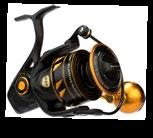
Available in a wide range of sizes the PENN Slammer ® IV Spinning Reel builds off of Penn’s IPX6 sealed body and spool and its redesigned Slammer drag system is better sealed, and offers a wider range of usable drag, all while being bearing supported for extra smoothness. It features Penn’s all brass CNC gear technology, 8+1 stainless steel bearing system and Hydrophobic Line Roller.
Suggested Retail Price: $259.95
www .pennfising .com
Bear Knife OPS 61125 offers Performance and Great Value
With a blade length of 3.25 inches, a weight of 3.4 ounces and an overall length of 7.5 inches, the Bear 61124 knife combines a stainless-steel textured handle with a 440 stainless steel blade. It is a frame lock knife, spring assisted, pocket clip folder with ball bearing washers that opens with a flipper tab and is a handy deep pocket knife.
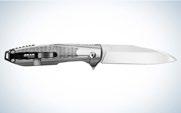
Suggested Retail Price: $69.99
www .bearandsoncutlery .com
NEW & COOL GEAR FOR OUTDOORSMEN
877.314.1237 // GreatDaysOutdoors.com // March 2023 61
Alabama is a Spectacular Place — We Just Need to Get the Word Out!
BY CHRIS BLANKENSHIP Commissioner of the Alabama Department of Conservation & Natural Resources


I love living and working in the State of Alabama! I love the diversity of the landscape from north to south. The mountains in Northeast Alabama down through Birmingham, the Tennessee River Valley, the Black Belt and pine forests of central and west Alabama, the Wiregrass and plains in the southeast and, especially, the Mobile-Tensaw River Delta and Gulf Coast are spectacular and special in their own way and character. What a beautiful place to live and enjoy!
I love the cost of living in Alabama compared to other areas of the United States. Electricity, water, natural gas, housing, property taxes, gasoline and groceries cost less here than in most places. Even though housing prices and groceries have risen the last couple of years, it is still a lot more cost-effective to live here than just about anywhere else.
for
I love the people of Alabama. Overall, we have a fine group of folks! Most of us care about our fellow man and enjoy raising our families here. I have seen people of all races, political parties, sexual orientations and religions showing respect and care for their fellow man. In the aftermath of natural disasters, we come together as one, and that is when you really see the quality of our people.
I love the great hunting and fishing opportunities we enjoy. With outstanding saltwater and freshwater fisheries and long hunting seasons for multiple species, it may be about the best of anywhere in the country for an outdoorsman.
We also abound in other outdoor recreational opportunities. Boating on our millions of acres of lakes, rivers, bays, and sounds is a favorite pastime that can be enjoyed almost year-around with our
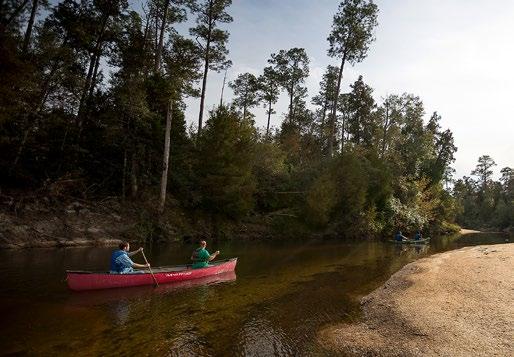 Alabama’s great outdoors provides abundant opportunities
exploration via canoes, kayaks or hiking .
Alabama’s great outdoors provides abundant opportunities
exploration via canoes, kayaks or hiking .
62 March 2023 // GreatDaysOutdoors.com // 877.314.1237
Photo by Billy Pope
warm climate. Having more miles of rivers and streams than any other state in the nation, Alabama is the perfect place for canoe and kayak adventures, and access to these waters is growing every year. Alabama is number one in aquatic biodiversity in the U.S. and fifth in overall biodiversity. That means we have more creatures than just about any other place in the Northern Hemisphere. We also have hundreds of miles of scenic hiking trails and some of the best mountain bike trails this side of the Rocky Mountains.
Dauphin Island and Fort Morgan are the last pieces of dry earth that migrating birds and butterflies see in the fall as they head south and the first they see in the spring when returning from South and Central America. We have birding trails that are unrivaled in diversity of species and terrain to enjoy one of t he fastest growing segments of outdoor recreation, birdwatching. As a matter of fact, 2023 has been deemed “The Year of Birding” by the Alabama Tourism Department to highlight this amazing resource we are so blessed with in Alabama and to increase the non-consumptive, sustainable tourism where people flock to see these wonderful creatures.
Most of you reading this already love living and thriving in Alabama as much as I do. You have already experienced the great recreational opportunities we enjoy and appreciate the lower cost of living. You have traveled all over the state and camped in our State Parks and fished in Lake Guntersville or on a snapper reef in the Gulf of Mexico. So why am I writing about this?
I am writing about this because we need to get this word out to other parts of the country and to the students at our universities so that Alabama can grow and retain talent to fill jobs and grow the economy of our state. Governor Ivey and my fellow cabinet members have done a great job of attracting business investment into our state. Those companies are investing billions of dollars in Alabama and have added tens of thousands of new, good-paying jobs over the past decade. What we are now seeing is super-low unemployment, less than 3%, and worker participation rates that are not keeping up with the demand for employees. We need more folks to move here, or stay here after graduating from college, to realize the full benefits of these investments.
Alabama was tenth nationally in population growth in 2022, which is good, but with all Alabama has to offer, why are people not falling over themselves to make Alabama their home? I think a lot of it has to do with perception. People around the country just don’t know what to think of Alabama or have old stereotypes that make them reluctant to make the leap and move here, even for great employment and family quality of life improvements that would be realized with the move.
In Huntsville, the FBI is moving several sections of their operation and thousands of employees to Redstone Arsenal. When told of their job moving from expensive Northern Virginia — with terrible traffic woes, cold winter weather and high crime — to beautiful Alabama, about 30% refused to make the move and transferred to other departments or left federal service.
WHY?
Mostly, they have an outdated perception of our state. I have had conversations with numerous people who were reluctant to move here but did it for a short term until they could retire or find
something else. Almost to the person, once they moved here, they never wanted to leave and couldn’t believe they had the wrong impression of us as a backwater, racist, poor state with nothing to offer. They now love it here and are telling their former coworkers who refused to move what a mistake they made!
I must say, I am the same way about other places. I had the perception that Idaho was a barren, cold place with a few trees in the south part of the state (Boise means covered with trees in French) but otherwise ugly and uninhabitable. Boy, was I wrong, it was beautiful and the people were so nice. Now I was there in August so I can’t say how it is in winter, but it was different than I pictured.
It was the same with New York City. My wife thought it would be a cool place to go for a visit. I imagined it would be a spectacle with lots of tall buildings, some theaters, and a bunch of pizza restaurants. It was something I was willing to see once because I wanted to see Times Square and Letterman, and I thought I might squeeze in a Yankees game. I thought everyone would be rude and loud and that I would probably be ready to go not long after we arrived. However, it was a pretty cool place! They have a lot of restaurants other than pizza, and the people were much nicer than I anticipated. As a matter of fact, the day I wore my Alabama shirt, I got more “Roll Tides” in NYC than I ever get in T-Town.
I say all that to say, we need to change people’s perception of Alabama if we want our state to grow and thrive. We need to get them to come to Alabama and try us on. If we can get them here once, so they can see what we are really like and get them to envision what living in Alabama would mean for their quality of life and happiness, I think we can make converts of them.
On the same track, Alabama universities do a great job of recruiting talent from other places to come to our universities. The University of Alabama has more National Merit Scholarship finalists than just about any university in the U.S., and over half of the university’s students are from out of state. Auburn, UAB, Troy and USA are also bringing them in from all around the country. Football has been a big help in that, but there is more to Alabama than just football. We need to get these young adults out in the woods and on the waters so they can see what it would be like to live, work and raise a family here instead of going back to where they came from. I figure if they really liked it there, they would not have come here to go to school in the first place. So, we are already trending in the right direction with them; we just need to close the deal.
We can use outdoor recreation and the beauty we have in Alabama as the carrot to get them here that first time or get the students out into the real Alabama; we just need an Alabama Outdoor Recreation brand and some kind of comprehensive program to start the perception change. Outdoor recreation can be a differentiator to set Alabama apart from other states and let people see what it really means to spend time in Outdoor Alabama. Louisiana has already taken “Sportsman’s Paradise” and North Carolina has claimed “The Great Trails State.” Innovate Alabama and the Outdoor Recreation Council it created are working on doing something similar for Alabama. I will have more on those efforts in next month’s column. Please visit outdooralabama.com or alapark.com to find your place to enjoy Alabama this spring.
FROM THE COMMISSIONER
877.314.1237 // GreatDaysOutdoors.com // March 2023 63
Will They Never Give Up??
The “long-tailed cat” conspiracy theorists are still trying to prove big cats are in Alabama .

After almost a decade of writing monthly articles for this wonderful magazine, sometimes I just have writer’s fatigue or writer’s block, whatever you want to call it. Trying to come up with new interesting topics can be difficult. Still, whenever all hope seems lost, a catalyst always sparks an idea and the words just seem to appear on paper.
This was one of those months when, honestly, I thought of not submitting an article. Still never fear, bubbling up from the depths of the social media morass, a beacon of light emerged to spotlight the topic that never goes away.
PANTHERS IN ALABAMA
as proven by the latest social media posts I saw.
“There were 1,000 of those big cats turned loose in Alabama along with 3,000 Coy Wolves. Most still have tracking collars. Most of them don’t. It was some kind of conservation research project that didn’t go as planned.”
Later in that article, I attempted to use proof from the Florida Fish and Wildlife Commission that we don’t have “1000s of those big cats” in Alabama. The following two paragraphs came from that same article:
BY CHARLES “CHUCK” SYKES Director of the Alabama Division of Wildlife and Freshwater Fisheries (WFF)

This topic surfaced just a little over a year ago, which inspired me to write the February 2022 article “Where is the Proof?” Here is an excerpt from that article:
“Fast forward to January of 2022, and the passion is still high for panthers of all colors
“FWC keeps records of all verified panther deaths in the state, and in 2021, there were 27 deaths reported with 21 of them being from vehicle collisions. Since 2014, an average of 24.8 panther deaths have been confirmed because of vehicle collisions.
“So, using our 200-animal population estimate
64 March 2023 // GreatDaysOutdoors.com // 877.314.1237
with an average vehicle death of 24.8 animals each year, that means that roughly 12% of the entire panther population is killed by vehicles each year. If we use the same math based on the social media post I referenced in the first paragraph, Alabama would have 125 ‘long-tailed’ cats hit by cars each year. When was the last time Al.com posted a picture and story of a ‘long-tailed’ cat dead along a roadside? Never ”

Over the weekend, I received a text from the staff member who oversees all of our social media accounts; we call her the “Wil dlife and Freshwater Fisheries Know-it-all.” She was sent a photo of what definitely appeared to be a mountain lion from a woman in north Alabama. The lady claimed that her family had been hearing strange sounds and goats had been disappearing, so they set up a trail camera on their property and got the photo in question. The woman stressed that she notified us first and the photo had not been circulated any other place. She wanted us to know first, “didn’t want to start a panic,” and even sent her address for us to come and verify.
Such news is of great interest to our staff. Confirmation of mountain lions in Alabama after more than 50 years of absence would be national news. Our biologists are eager to fulfill their investigative duties and perhaps be a part of an announcement that will include multiple wildlife agencies and countless news releases. Although most photos submitted as big cats are domestic cats, coyotes, or even raccoons, those that do depict mountain lions get us interested, especially when the person reporting the information is forthcoming with details (others simply don’t respond when we press for more information).
Well, something seemed fishy about the photo and the woman’s information, so my “wildlife know-it-all” started digging into her story. After conducting a quick Google search, an article appeared with the same photo from December of 2016. The photo that had been sent to WFF had been cropped and somewhat edited from a trail camera photo taken on November 20, 2016, in Kansas !!
I don’t quite understand why someone would take the time to con jure up a story, edit a photo, and then contact WFF trying to pass it off as real. Who has that much time, and how is that a top priority in a person’s life? The effort placed on a farce like this is just mind boggling.


Once confronted with the truth, the woman from north Alabama completely changed her story and said the photo was sent to her by someone else saying the cat was on their property. Of course, she didn’t accept responsibility. She placed the blame on someone else.
What a complete waste of WFF staff time and resources, and how insulting to the intelligence of the WFF staff to think they couldn’t figure out this was a lie. Why is it so important to try to prove that there are “big cats” in Alabama? I was taught as a kid to tell the truth by repeatedly being told the story of the little boy who cried wolf.

I was also taught that if caught doing something wrong, it’s best to just own up to the mistake and take the punishment because perpetuation of the lie will only make it worse. I guess this woman was not taught these two foundational principles. Not only did she destroy her credibility with WFF, but she also helped to prove the fact that there are no mountain lions in Alabama.
We know mountain lions have been verified in neighboring states and cannot say with certainty that one hasn’t set foot here. We can say with certainty that no one has sent us any photos of one that could be verified or that we haven’t confirmed as a hoax. I also add a reminder
here that mountain lions have never been known to occur in black, so you certainly haven’t seen one of those.

I guess the reason I’m writing this article today is to ask everyone not to waste our time debunking lies. We have much more important tasks to accomplish. If a big cat is actually in Alabama, I guarantee someone will catch it on a trail camera or, like in Florida, it’ll end up pursuing the wrong career in directing traffic.
We’re not trying to dismiss the possibility; we just need honest proof. So, if you have it, let us know. If you’re fabricating the story, we’ll find it out!
In the meantime, please know that state and federal wildlife agencies aren’t cooperating with every reporter in the Southeast to hide the truth from you. When we know, you’ll know.
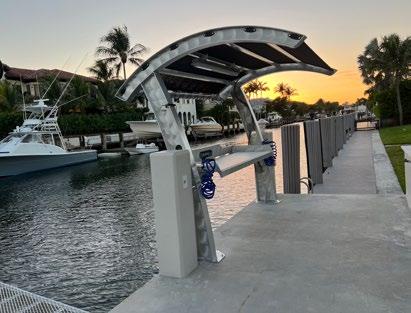
Made In The USA Built-In Hose Stations Ceramic Coated Aluminum WWW.KILLERDOCK.COM The greatest fish cleaning stations known to mankind. Table and Canopy Models Table widths from 42” to 90” King Starboard Cutting Surface (251) 207-1743 FROM THE DIRECTOR
877.314.1237 // GreatDaysOutdoors.com // March 2023 65
The Best Kayak Fishing Near Me
Although coastal creek bass don’t get too big, there are some quite nice bass to be found
Being a kayak angler as I am, I have to admit that I am very lucky to live where I do. Here on the northern Gulf Coast, I have a very wide range of kayak fishing possibilities ranging from small private farm ponds to big wide rivers to backwater bayous to the ultimate kayak fishing location- the big blue Gulf of Mexico.
I’m lucky, and I value all of these kayak fishing locations.
However, in my opinion the best kayak fishing near me is something else.
viewing, and low-cost, low-effort fishing nearly any time of year. All along the Gulf Coast there are hundreds if not thousands of these small tidal creeks which empty into larger bays and bayous.
And no, I won’t give you the name of this creek and you’ll have to find your own creek for your kayak fishing adventures. Don’t worry, there are many small creeks just like my creek which offer the same kind of kayak fishing options.
BY ED MASHBURN

There’s a small creek in the southernmost part of Baldwin County, Alabama which provides me with great fishing, wonderful wildlife
Kayak anglers who want to get into the small coastal creek fishing can find a multitude of these smaller flows just by either paddling around the shorelines of Mobile Bay, Wolf Bay, Grand Bay, Pensacola Bay, East Bay or the ICW.
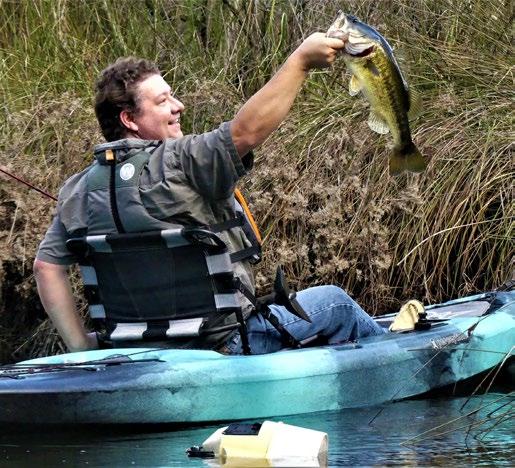 Photos by Ed Mashburn
Photos by Ed Mashburn
66 March 2023 // GreatDaysOutdoors.com // 877.314.1237
Doing a little map-reading or online research will quickly indicate many small creek fishing possibilities.
A WIDE RANGE OF TARGETS

One of the best things about fishing these small, tidal flows is the wide range of different fish anglers can encounter. Both freshwater gamefish and saltwater species will be in the small creeks at different times, so as long as anglers spend some time on the water throwing the right bait-and live shrimp are always prime small creek baityou will catch fish. For artificial lures in the small creeks, it’s hard to beat a 1/8 ounce jig head with one of the many scented soft plastic bodies. Bounce this jig along the bottom and hang on.
On a recent creek fishing trip, my son and I caught redfish, mangrove snapper, sheepshead, and a whole load of largemouth bass. Often these different species of fish came from the same water on the same bait. Most of these brackish water largemouth bass will be in the one pound range. These bass just don’t get as big as their biglake totally freshwater cousins, but on this recent trip, my son caught a bass which went five pounds, so there are some good old big bass to be found in the coastal creeks, but they are not common.
In winter, most of our small coastal creeks have a lot of speckled trout which winter over in the protected waters, and these winter specks can be a whole lot of fun when a school is located.
EASY TRIP- IN AND OUT
Many of the northern Gulf Coast tidal creeks offer anglers good access to the water, and by doing a little online research, anglers can often find creeks which have maintained kayak access launch points. OK, here’s a free bit of information, Wolf Creek in Baldwin County, Alabama has a wonderful kayak launch facility with great parking close at hand jplus the fishing here can be great.
Most of the coastal creeks will have decent parking for vehicles even if the angler has to brush-pop a trail to the water from the parking area or roadside, it’s almost never a difficult or long-distance carry or drag to get the kayak to the water.

Anglers will want to keep an eye open for depth changes in the creek. Fish of all species tend to concentrate in the deeper, more sheltered parts of any creek. If a good, steep drop-off shoreline with some wood cover can be located, this will be a place to spend some time slow fishing, because schools of redfish in particular often hold in such places.
Bends in the creek are also good places to locate fish. Quite often the outside bend of the creek curve will be deeper and the fish often are found in these deeper curves.
SPRING- YEAR ROUND
Lots of our small coastal creeks have year-round springs which pump water into the creeks. Lots of our coastal creeks head-up with a big spring which starts the actual flow of the creek.
These springs are great places to kayak fish because the spring water is almost always either warmer or cooler than the regular water of the creek. In winter, fish of all kinds concentrate in the creekbottom springs to keep warm. In summer, the springs help keep the creek fish cooler.
Often these springs can be located by a slight sulfur smell in a particular stretch of the creek. Almost all of the sprung water here on
the coat has a sulfur content, and the smell can lead an angler to a fishing hotspot.
An angler who drifts a live shrimp or live bull minnow in one of the creek bottom springs can encounter a wide range of fish.
Not always but sometimes especially in winter, baby tarpon will hold up in these spring holes, and kayak anglers can have a whole lot of fun playing with the baby tarpon.
GIMME SHELTER
Another thing which makes our coastal creeks such great places for kayak anglers is that most of the small creeks are heavily forested with big trees and taller shoreline reeds which effectively block strong winds.
This wooded shelter makes it possible for kayak anglers to get on the water and catch some great fish even on windy, blustery days which make open water fishing difficult if not impossible.
And the small size and twisting creek structure makes larger boats and such things as jet skis and other wake-making craft stay elsewhere. On most smaller coastal creeks, the only other angler a kayaker is likely to see is perhaps another kayak angler. These small flows are usually very private and very undisturbed.
The shoreline trees provide wind protection along with shade in hot summer, and fishing a deep shady hole while sitting in the cool shade of overhanging trees is very pleasant.
CAMPER CITY TRUCK ACCESSORIES Specializing in Truck Toppers + Accessories • Spray-in/Drop-in Bedliners • Bug Shields • Gooseneck & 5th Wheel hitches • Vent Visors • Running Boards • Warn Winches • Bed Covers Mobile 1051 N. Schillinger Rd. Mobile, AL 36608 (251) 633-9004 1-800-431-6692 Pascagoula 1340 Denny Ave. (Hwy 90) Pascagoula, MS 39567 (228) 762-6082 1-877-732-8782 hattiesburg 7166 Hwy. 49 N. Hattiesburg, MS 39401 (601) 296-1800 1-888-730-0432 And MORE! PADDLE FISHING
877.314.1237 // GreatDaysOutdoors.com // March 2023 67
Gulf Coast Fishing Outlook
BY CHRIS VECSEY
March is the biggest turning point of the year. Longer and warmer days are ahead and this month will see most species of gamefish moving out of their winter haunts. In addition, the first migratory species will begin to show up as spring progresses and water temperatures increase.

MISSISSIPPI
Redfish and trout will begin taking over the shallower bayous and marsh systems. These fish will be feeding heavily on smaller baitfish and shrimp as they move out of the grass
March is the month for sheepshead! Lee Chase with a 10+lb sheep! photo courtesy Stephen Franklin
and smaller creeks.
Small jerkbaits, twitchbaits and soft plastics like paddletails and flukes will work well. For live bait use freeline shrimp or small menhaden.

Keep leaders light, with 15-20 pound fluorocarbon being a good choice. Topwater action can be expected as well and can be a fun way to cover water.
The barrier islands and the Chandeleurs will
68 March 2023 // GreatDaysOutdoors.com // 877.314.1237
be prime places for big trout. Fishing the beachfronts, focusing on dropoffs in 3-6ft of water is usually best.
This is a good time and place to score trophy specks, so think larger baits and lures than usual. Live baits like croakers, five to six inch mullet, and pigfish will be top choices to connect on gator trout. For artificials, bigger twitchbaits like the Mirrolure 27MR and Yo Zuri 3DB inshore twitch in the 90 size are excellent picks. Larger profiled soft plastics such as the Slick Lure provide excellent mullet imitations.
These baits should be fished along drops in anywhere from two to six feet of water. Location choices should revolve around good current and plenty of bait.
Pompano will also be a welcomed catch around the barrier islands. They will mostly be found along the beachfronts of the islands. Pomps will take shrimp imitations, small bucktail or nylon tailed jigs and both live and dead shrimp.
ALABAMA
Speckled trout will begin moving out of the creeks and onto the flats and open waters. Areas around river mouths and inshore reefs will be good places to work. Freeling live shrimp is a sure fire way to locate trout and reds in these scenarios. You’ll pick up bonuses like flounder, drum, sheepshead and the occasional pompano as well.
This is one of the best times to fish the surf in Alabama. The pompano run will fire up this month and some of the biggest fish of the year will be caught during this period.
Focus on washouts/rips that carve deep troughs and expose bait for pomps and other surf runners. Ghost shrimp, sand fleas, fish bites and small pieces of dead shrimp will get the job done. Rigs should be fished on the bottom and can be “undressed” or with small, colorful floats.
Sheepshead will begin their annual spawn and will form huge aggregates around Ft Morgan and Perdido Pass. These fish will generally be less cautious once the spawning period begins and will take both live and dead shrimp, fiddler crabs, ghost shrimp and a few other baits.
Offshore, natural bottom areas like the Trysler grounds and yellow gravel will be good places for vermilion snapper and other bottom species. Two-hook “chicken rigs” with pieces of squid or cut bonito will do well.
As a reminder, shallow water grouper species which include scamp, red, black, gag, and yellowfin groupers, are closed outside of the 20 fathom line until April 1st. Gags will remain closed until June.
FLORIDA PANHANDLE

Mackerel will begin moving in as water temps climb into the upper 60s and above. Both king and spanish macks can be found right off the beaches and can be caught trolling a variety of artificial lures and baits.
March is a great month to target trophy speckled trout on grass beds and shallow flats. These fish will begin to feed heavily as we head towards their first spawn of the year. Big female trout will hang around areas with a good supply of mullet, croakers and
other forage. Live baiting is a sure thing, but bigger hardbaits like jerkbaits and topwaters will produce quality specks as well.
As with inlets on the Alabama coast, Sheepshead will form the same spawning aggregates along panhandle passes. Action with these fish will continue through the month until the spawn concludes and the fish begin to disperse. This usually happens around the end of the month.
Wahoo will be a prime target around the 50 and 100 fathom lines. High speed trolling is a good way to cover water and locate these fish.
The Okaloosa County fish aggregating devices (FADS) will offer solid action with many pelagics. Wahoo, dolphin (mahi mahi), tuna and billfish will be possible catches around the FADS. It’s best to monitor water conditions around the FADS to know when to go. Subscribing to a satellite imaging service like Hilton’s RealtimeNavigator is the best way to keep up with surface temperatures, water color, etc.
Contact Information
• Custom Fabrication • Premier Repairs • Expert Finish Work • Estimates & Supplies • 14’ Ultralight Tunnel Boats 251-473-3176 2100 Halls Mill Road • Mobile, Alabama 36606 www.fiber-plastics.com Time to call Professional Fiber Glass Repair Since 1974 FIBER-PLASTICS INC We can help... Look Familiar? FISHING OUTLOOK
Hilton’s Realtime-Navigator www.hiltonsoffshore.com
877.314.1237 // GreatDaysOutdoors.com // March 2023 69
Pier & Shore Fishing Outlook

Pompano numbers begin to increase along the Gulf beaches in March .
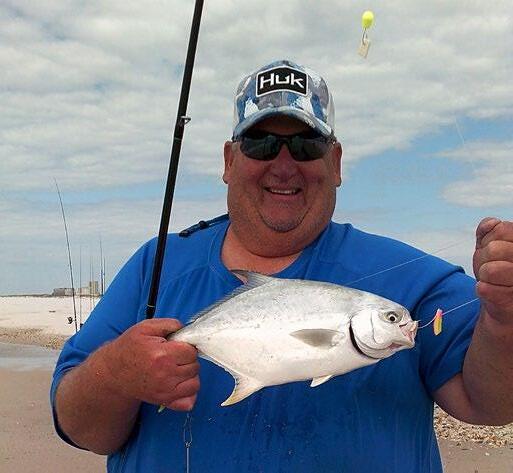
Pompano numbers should be on the rise this month along with water temperatures
BY DAVID THORNTON
by David Thornton
March is our main transition month from winter into spring along the Emerald Gulf Coast, and weather from both seasons is possible at any time. Depending upon the climatological nuances for each year, sustained coastal water temperatures historically show a marked rise from the low 60s into the middle or even upper 60s by the end of the month. This, plus longer length of daylight hours, increases the amount and variety of activity anglers may experience, especially near or after the Spring Equinox March 20th.
NEAP tide periods around March 9th and 22nd supply less water exchange between the deeper, cooler waters in the Gulf and those more rapidly warming waters in the shallow surf zone and
back bays. These are the times when it is easier to fish passes or similar areas where diurnal tidal fluctuations ordinarily make the current too swift. The typical pattern of early to mid-morning low tide means we will see rising tides through the afternoon and evening hours. This leads to all sorts of angling options for pier anglers, such as dangling live shrimp or fiddler crabs around the piling to entice spawning sheepshead.
The apex of the sheepshead spawn is influenced by the moon phases and warming water temperatures. This activity usually peaks around the full moon in March (on the 7th), then diminishes through early April. Look for schools of spawning sheepshead on the upwind/ upcurrent side of the seaward end of the Gulf
Photos
70 March 2023 // GreatDaysOutdoors.com // 877.314.1237
beach piers and jetties. These fully mature fish are all over 12 inches fork length (about a pound) and average four to six pounds. They may reach over 10 pounds if they live long enough, which takes about 15 years. Regulations on sheepshead differ in each state, so take care to acquaint yourself before fishing.
Often these spawning sheepshead will not bite while their tiny little brains are focused on other activities. But some sheepshead may not yet be ready to take part in amorous affairs and may be seen actively feeding on pier pilings. These are the ones to target with fiddler crabs or small live shrimp. They may still be finicky biters, so a small hook is often used to ease their wariness.
Sheepshead are scrappy fighters and a hooked sheepshead will repeatedly dive for safety behind barnacle encrusted piling. So, the angler must be tackled up with a rod and line heavy enough to prevent that. Setting the drag to slip some will help prevent the hook from tearing out of the fish’s mouth. And it is a good idea to employ a landing net to hoist larger specimens onto the pier deck.
Jigging for migrating Spanish mackerel and pompano are other options this month for pier and jetty fishers. Both species move primarily from east to west.
Pompano schools prefer to stay inside the longshore sandbar while Spanish mackerel are usually found outside the sandbar. Both will strike lead head jigs in the ½ to ¾ ounce range. Pompano seem to be more wary of heavy line or leade while the sharp teeth of Spanish mackerel require the use of heavy mono or light wire as leader.
Either may be caught on light or medium class spinning tackle. Seven-foot rods are commonly used with 3000 size reels capable of holding at least 200 yards of monofilament or braided line. These fish commonly weigh from one to three pounds, though larger specimens or surprise hookups from other large species are possible though not probable. Toward the end of the month, much bigger potential quarry such as jack crevalle, cobia or king mackerel may appear on the scene. These are usually targeted with heavier tackle more suitable for the task. Bluefish are another bycatch species for jig fishing, which may surprise anglers by cutting off unprotected gear. The teeth are real!


Inshore and from shore anglers may still be treated to schools of whiting or Gulf kingfish while fishing for pompano with pieces of shrimp or ghost shrimp. They are likely the most common unintended catch for surf zone anglers, and certainly one of the most delicious. While they are not regulated, their numbers and average size are not near what has been experienced in years past. This suggests possible over fishing, at least locally in the more intensely fished areas along the coast. Anglers can aid the fishery by releasing any whiting less than 12 inches long and limiting their retained catch. Gulf kingfish grow rather rapidly in the first year, reaching 8 to 10 inches. But once they reach sexual maturity, their growth rate slows markedly, and they gain only an inch or so per year. But they can live more than 7 or 8 years and occasionally reach over two pounds in weight.
Pompano numbers along with water temperatures should be on the rise this month as they gather into larger schools in anticipation of next month’s spawn. Their prey items like ghost shrimp, mole crabs (“sandfleas”), and coquina clams become more active in the warmer waters too. This stimulates the fish to binge whenever the opportunity presents itself especially with a moderately rough surf.
Surf casters set up rod holders along the shore with rods 10 feet or longer to reach and wait for pompano that may be 60 to 80 yards out. Pyramid,

storm or “sputnik” weights in the three-to-six-ounce range are employed on double drop pompano rigs to get more casting distance and holding power in rough surf or high winds. Consequently, heavier lines testing over 20 pounds and bigger reels are often used to complement the heavier duty rods and rigs.
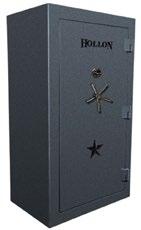


urfzone that is wiithin 50 yards or so at times, especially as the tide is rising. This is when seven to nine foot, medium size spinning tackle in the 10-to15-pound class can do the bulk of the work of targeting pompano along with a variety of bycatch species.

Whiting, ground mullet, redfish and black drum prowl nearer to shore this time of year. They are commonly caught on pieces of fresh shrimp and/ or Fishbites on single drop rigs or Fishfinder (“Carolina”) rigs. The short 8-to-12-inch leaders of 10-to-15-pound monofilament or fluorocarbon aids with bite detection on the more sensitive tip of the lighter class tackle. Any number of rod holders or sandspikes may be used, but fewer can be properly supported as the action heats up.
Look for sandbars with sharp drop offs into deeper water which appears a darker green color, or where the “whitewater” from waves stops rolling. This is indicative of a trough or channel where the deeper water will attract and hold feeding fish. Even bluefish are attracted to these spots. Along the Alabama coast and Mississippi barrier islands, speckled trout use these same “soft” sandbar structures to ambush baitfish. Thus, they are good spots to try wade fishing with various lures like MirrOlure’s MirrOdine or similar suspending hard baits.
March brings increasing opportunities for shorebound anglers as average air and water temperatures rise. More species, along with growing numbers of each give pier and shore anglers a myriad of options to pursue as they venture forth to enjoy their great days outdoors.
FISHING OUTLOOK WE SERVICE ALL BRANDS OF GUN SAFES BUT... WE PROUDLY SELL ONLY HOLLON GUN SAFES (251) 479-5264 457 Dauphin Island Parkway “At the Loop” Mobile, AL 36606 WE SERVICE ALL BRANDS OF GUN SAFES BUT... WE PROUDLY SELL ONLY HOLLON GUN SAFES (251) 479-5264 457 Dauphin Island Parkway “At the Loop” Mobile, AL 36606 WE SERVICE ALL BRANDS OF GUN SAFES BUT... WE PROUDLY SELL ONLY HOLLON GUN SAFES (251) 479-5264 457 Dauphin Island Parkway “At the Loop” Mobile, AL 36606 877.314.1237 // GreatDaysOutdoors.com // March 2023 71
REGIONAL FRESHWATER
Fishing Outlook
BY ED MASHBURN
The Sipsey Fork is a wonderful Deep South trout fishery
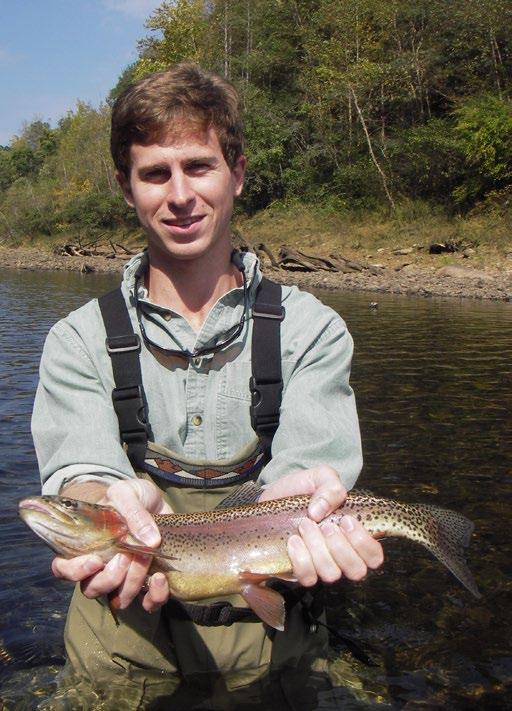 Photos by Ed Mashburn
Photos by Ed Mashburn
72 March 2023 // GreatDaysOutdoors.com // 877.314.1237
ALABAMA WATERS LAKE GUNTERSVILLE
We’re starting to get into full spring fishing patterns on the lakes of Alabama, and there’s no water better for fast fishing in spring than massive Lake Guntersville.
Veteran Lake Guntersville guide and tournament angler Captain Jake Davis says bass anglers will have good luck with Rat-L-Traps in the standard Guntersville red colors, and Texas-rigged soft plastics will also be very good. Square-bill crank baits will be good bets to cover a lot of water in order to find the best concentrations of bass. It looks like just about every kind of offering made to the bass this month should be good
Davis advises anglers to look for water warming into the upper 50s or above for actual bedding to begin. When the water temperature hits the low 60s, things should get very good for bass anglers as the bass will go to the shallow bedding areas.
Bass anglers should work the staging areas- drop offs and channelsnear the flats where most of the Guntersville bass go to make their beds for spawning.
Crappie anglers should have good results in March by fishing the bigger creeks where the slabs will be getting ready to spawn in April and May. Both small jigs and live minnows worked slowly around deeper structure will be good.
SIPSEY FORK
Year-round trout fishing is the rule in Alabama’s only full-time cold water trout fishery.
March is a good time for anglers to get a good start in trout fishing in Alabama’s only full-time cold water trout fishery. This month will see March browns hatching as well as black caddis. Blue wing olives have been hatching all winter, and they will continue into March. Fly hatches can occur anywhere along the run of the Sipsey Fork. Riverside Fly Shop will have flies to match all of the hatches.
Another kind of fly fishing will occur in March as fly anglers throw streamers in white, silver and black top to match the run of threadfin shad. These one to three-inch streamers can attract some of the biggest trout in the river.
Trout will be stocked monthly at the Sipsey Fork, but the folks at Riverside have a donation jar where anglers can drop a few dollars in for the purchase and release of three to five pound rainbows in the river- these are some fine fish.
Riverside is doing guided drift boat trips, wading trips, and striper on the fly trips above the dam in Smith Lake.
Anglers who want some world-class fly fishing fun should contact the shop for coastal saltwater fly fishing trips to various Gulf Coast locations.
WEISS LAKE
“It’s March- THE time for crappie here,” says well known Captain Lee PItts.
Anglers can fill a big ice chest with fine eating crappie by long-line trolling jigs over open water and then as the month moves on, fast results will come from a jig fished under a float. This rig should be cast over submerged stumps on flats.
“Throw it out, and let it sit. Then, move it a foot and let the jig settle back
under the float. Keep moving the float and jig a foot at a time. The crappie usually hit the jig as it falls,” PItts said.
Anglers who are crappie fishing on Weiss at this time need to think about using light line and six pound test is a good choice because it allows good lure movement and a more natural presentation.
The bass at Weiss are starting to get tight to the shorelines in preparation for bedding. Anglers need to really focus on hard clay and gravel and rock bottom. The bass will be holding on hard bottom structure at this time.
“I cover a lot of water at this time using a Larue Bifflebug on a jighead. I can feel the jig hit rocks. I also throw spinner baits. I like a Talon 3/8 oz spinner bait with double Indiana gold blades. I like chartreuse and white colors,” Pitts said.
MOBILE DELTA
“Everything about fishing in March is predicated on the river stages. The higher the rivers, say eight feet or higher at the Berry Steam Plant, and you’ll be fishing down around the Causeway because of the very high water,” predicts long-time Delta angler and guide Captain Wayne Miller.
He says that it is not impossible to catch bass in the very high water and fast currents, but it can be close.
After the high waters run down, bass will find lots of food coming out of the flooded woods. The bass will bulk up and get really healthy, and this benefit can carry on through the rest of the year.
In March, the Delta bass will be eating crawfish, and lures need to match this food. Really bright reds and oranges are good choices for crankbaits. Jigs can be very good too.
“Tn March is the one time I get away from my usual advice- ‘Think small.’ In early spring we see large crawfish, and the bigger bass will target big crawfish. Use big jigs with trailers, and I will bulk up the size of jigs and crankbaits in the crawfish patterns,” Miller said.
LAKE EUFAULA
Long-time Lake Eufaula guide Sam Williams said that the bass will be in a pre-spawn pattern, which means they will be feeding heavily. Smaller crank baits and lipless crank baits fishing in five to seven feet of water should be quite good in March.
Anglers need to work creek mouths very hard. Look for water grass which will be starting to grow.
On another note, anglers can have some serious fun trolling along drop off and old creek channels for white bass, hybrids, and even some very big stripers in March. White jigs and shad pattern crank baits are good choices for slow trolling for the whites and hybrids.
The crappie at Eufaula will be off deep ledges, and as the month goes one, they will move to the tops of drop offs and ledges as they get ready for the big spring spawn.
Anglers need to pay attention to the weather. If the weather and water warm sooner than unusually, the crappie may start their spawn earlier than they most often do- April and May.
WILSON LAKE
Captain Brian Barton says that in March the catfish at Wilson are getting ready to spawn. Anglers should look near the lake flats and long points.
FISHING OUTLOOK
877.314.1237 // GreatDaysOutdoors.com // March 2023 73
Between Wilson Lake Shores and McKiernan Creek is a very good region to find these pre-spawn catfish.
Look for rock and wood cover, and work the bait just above or beside the cover.
Catfish anglers should try cut bait, chicken livers, and live shad if they can be found. Big catfish will be found right below Wilson Dam- try big chunks of shad or whole shad in deeper holes along bluff walls. Use electronics to find holes on the bottom that are five feet or deeper than the surrounding bottom- the bigger cats love these areas.
As March moves on, bigger catfish will be moving up in shallower water for spawning.
MILLER’S FERRY
“In March, everything is on the banks in a pre-spawn or actual spawn pattern. When the water gets to 60 degrees, everything will start to happen,” advises Joe Dunn from Dunn’s Sport Shop.
Bass anglers can flip jigs in grass that will be starting to emerge, and chatter baits and spinner baits will also be very good. All lures need to
be in some kind of shad pattern since shad are the primary forage for bass.
Dunn reminds us that lots of anglers will be riding around the lake at this time looking for the right conditions, because the lake doesn’t all have the same water and temperature conditions at the same time. Some bays and sloughs will be warmer and more productive than others.
The Miller’s Ferry crappie will be up on the banks by late March, and they will be shallow near wood and grass. Crappie anglers should look for crappie to be just off the banks. Use a cork with a jig a foot or so below the cork. This rig works very well on suspended crappie along the banks at this time.
“I like a Southern Pro jig- the color depends on water temperature and clarity. Silvers and blues work well for clear water. Chartreuse, black, and electric chicken are better for stained water conditions,” Dunn said.

FLORIDA WATERS
LAKE TALQUIN
Regional Freshwater Fishing Outlook
According to Buddy Cartwright of Whippoorwill Lodge on Lake Talquin t that should visit the lake early in the month for the best shot at the
74 March 2023 // GreatDaysOutdoors.com // 877.314.1237
Now is the time to find and load up a bunch of greattasting crappie
biggest bass as they will be moving on the beds for spawning. The bedding bass will take worms, lizards, and other soft plastics, and March is a good time for sight fishing the big girls as they are on the spawning beds. June Bug has been a consistently good color for the March soft plastics.
Crappie anglers will find plenty of slabs in the shallows as they continue their spawning, but some of the biggest fish will have moved off the beds and back into more open water. Try trolling creek mouths and deeper creeks with jigs and live minnows.
The catfish will still be in deeper water in March, but they will be getting ready to move on the flats and ledges for spawning as the water warms.
WAKULLA RIVER
Rob Baker of Wilderness Way, a long-time resident of the area and guide, said that as the water warms, the bass will start moving into shallow water bedding areas, and depending on the water clarity, some good sight fishing for bedding fish can occur.
This will be a good time for top water frogs worked over very thick cover. Work the soft-plastic frog slowly and be ready for some violent strikes.
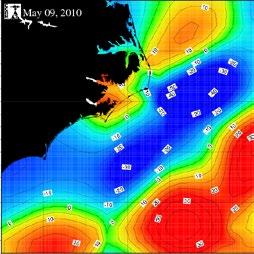
Plastic worms in watermelon color on Carolina rigs will catch bass near heavy cover. Look for logs and old blowdown treetops, especially in the Wakulla River.
For panfish anglers, the bream will be moving into quiet backwaters off the main river channels, and tiny artificials and live crickets and worms will collect.
Important Contact Information
Capt. Brian Barton
256-412-0969
Brianbartonoutdoors@aol.com
Capt. Jake Davis Mid-South Bass Guide Service
615-613-2382
www/midsouthbassguide.com

Joe Dunn Dunn’s Sports 334-636-0850 33356 Hwy 43, Thomasville, AL
Rob Baker Wilderness Way Kayak Shop 850-877-7200 3152 Shadeville Road Crawfordville, Fl 32327
Whippoorwill Lodge 850-875-2605
fishtalquin@gmail.com
Randy Jackson
Riverside Fly Shop 17027 Hwy 69 N Jasper, AL

256-287-9582
riversideflyshop.com

Captain Wayne Miller
Mobile-Tensaw Delta Guide Service
251-455-7404
Millewa12000@yahoo.com
Capt. Lee Pitts
256-390-4145
www.pittsoutdoors.com
Capt. Sam Williams Hawks Fishing Guide Service 334-355-5057

www.hawksfishingguideservice.com
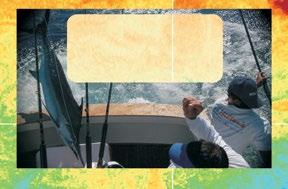
Regional Freshwater Fishing Outlook
visit us at www.pureflats.com
most versatile lure yet SLICK Jr. now available in 12 colors!
Our
An Online Map Server Catch More Fish Using Less Fuel! www.Realtime-Navigator.com 877.314.1237 // GreatDaysOutdoors.com // March 2023 75
PRIME FEEDING TIMES
This chart is specifically designed for fishing times in the Mobile/Tensaw Delta & other tidally influenced waters of South Alabama.
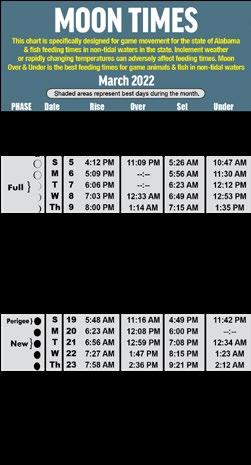
Mobile / Tensaw Delta March 2023

MOON
FEED TIMES Date Day
&
1 2 3 4 5 6 7 8 9 10 11 12 13 14 15 16 17 18 19 20 21 22 23 24 25 26 27 28 29 30 31 Wed Thu Fri Sat Sun Mon Tue Wed Thu Fri Sat Sun Mon Tue Wed Thu Fri Sat Sun Mon Tue Wed Thu Fri Sat Sun Mon Tue Wed Thu Fri ★★ ★ ★ ★★ ★★ ★ ★ ★★ ★★★ ★★★ ★★ ★★ ★ ★ ★★ ★★ ★★★ ★★★ ★★ ★★★★ ★★★★ ★★★★ ★★★★ ★★★ ★★★ ★★ ★ ★ ★ ★★ ★★ 76 March 2023 // GreatDaysOutdoors.com // 877.314.1237
Fowl River
Fort Morgan
Mobile River
Perdido Pass
Yamaha’s award-winning 4.2-liter V6 four strokes set the standard for offshore performance. Not only do they feature class-leading 4.2-liter displacement, but they’re also:
FLEXIBLE — The entire lineup of 4.2-liter V6 four strokes—from the F225 and F250 up to the mighty F300—is now available with either mechanical or digital controls, for ease of repower
LIGHTER — At 562 pounds (digital) and 551 pounds (mechanical), they’re up to 73 pounds lighter than other four strokes in their class
FASTER — Up to 19 percent faster than other 300-hp competitors, planing offshore boats with ease*
SMARTER — Up to 17 percent better fuel economy, at cruise RPM, than comparable outboards*

Learn more about the powerful performance of our 4.2-liter V6 Offshore F300, F250 and F225 at YamahaOutboards.com/V6offshore.

W Th F S Su M T W Th F S Su M T W Th F S Su M T W Th F S Su M T W Th F 06:28 PM / 0.91 07:23 PM / 0.94 08:07 PM / 0.96 08:47 PM / 0.94 09:28 PM / 0.89 10:12 PM / 0.81 11:22 AM / 0.29 11:01 PM / 0.70 11:42 AM / 0.37 11:59 PM / 0.59 09:17 AM / 0.53 01:10 AM / 0.47 10:00 AM / 0.68 10:47 AM / 0.82 12:37 PM / 0.94 01:34 PM / 1.03 02:38 PM / 1.08 03:41 PM / 1.10 04:43 PM / 1.07 08:10 PM / 1.06 09:05 PM / 1.03 09:59 PM / 0.94 11:15 AM / 0.31 10:59 PM / 0.79 11:35 AM / 0.45 12:03 AM / 0.62 11:58 AM / 0.59 01:11 AM / 0.46 10:37 AM / 0.73 11:06 AM / 0.86 11:45 AM / 0.94 12:28 PM / 0.98 01:15 PM / 0.97 02:12 PM / 0.93 03:11 PM / 0.88 06:51 PM / 0.81 08:01 PM / 0.82 04:21 AM / -0.17 05:01 AM / -0.18 05:36 AM / -0.15 06:07 AM / -0.10 06:28 AM / -0.02 06:25 AM / 0.09 08:57 AM / 0.23 01:32 PM / 0.24 04:59 AM / 0.30 03:57 PM / 0.22 04:50 AM / 0.33 05:03 PM / 0.17 04:32 AM / 0.35 05:56 PM / 0.12 07:06 PM / 0.10 01:04 AM / 0.01 02:26 AM / -0.11 03:45 AM / -0.21 04:51 AM / -0.27 05:35 AM / -0.28 06:07 AM / -0.23 06:25 AM / -0.10 06:34 AM / 0.07 01:39 PM / 0.27 06:34 AM / 0.25 04:32 PM / 0.23 05:14 AM / 0.38 06:01 PM / 0.14 04:40 AM / 0.40 06:56 PM / 0.09 10:51 PM / 0.04 12:47 AM / -0.03 01:48 AM / -0.07 02:45 AM / -0.09 03:48 AM / -0.10 04:48 AM / -0.09 05:34 AM / -0.07 1 2 3 4 5 6 7 8 9 10 11 12 13 14 15 16 17 18 19 20 21 22 23 24 25 26 27 28 29 30 31 ALABAMA TIDE CHARTS
*Testing conducted by Yamaha at Yamaha’s test facility on a Grady-White® 257 Advance/300 hp, with each boat rigged for maximum performance. REMEMBER to always observe all applicable boating laws. Never drink and drive. Dress properly with a USCG-approved personal floatation device and protective gear. © 2017 Yamaha Motor Corporation, U.S.A. All rights reserved. 1-800-88-YAMAHA BIG-BLOCK DIGITAL & MECHANICAL RIGGING MEET 116 E. I-65 Service Road N. Mobile, AL 36607 Phone: 251-476-2699 www.bluewateryachtsales.net POWER
t
US A CALL OR STOP BY TODAY TO GET A QUOTE ON REPOWERING YOUR BOAT
t t t GIVE
W Th F S Su M T W Th F S Su M T W Th F S Su M T W Th F S Su M T W Th F 06:26 PM / 1.29 07:29 PM / 1.28 08:35 PM / 1.26 09:37 PM / 1.21 10:35 PM / 1.13 11:31 PM / 1.02 12:33 AM / 0.88 02:56 PM / 0.55 01:55 AM / 0.74 01:56 PM / 0.69 03:55 AM / 0.63 01:29 PM / 0.89 01:37 PM / 1.10 03:07 PM / 1.29 03:53 PM / 1.46 04:53 PM / 1.59 06:01 PM / 1.69 07:12 PM / 1.74 08:28 PM / 1.71 09:53 PM / 1.60 11:29 PM / 1.41 01:06 AM / 1.18 03:15 PM / 0.59 02:50 AM / 0.94 01:58 PM / 0.80 01:17 PM / 1.08 01:33 PM / 1.32 02:07 PM / 1.47 02:49 PM / 1.53 03:40 PM / 1.53 04:39 PM / 1.50 05:44 PM / 1.46 06:50 PM / 1.40 07:56 PM / 1.33 06:15 AM / -0.44 07:03 AM / -0.47 07:40 AM / -0.47 08:07 AM / -0.42 08:25 AM / -0.33 08:34 AM / -0.18 08:32 AM / -0.00 08:19 AM / 0.20 07:17 PM / 0.41 08:02 AM / 0.39 08:30 PM / 0.27 07:37 AM / 0.54 09:33 PM / 0.14 10:46 PM / 0.03 01:54 AM / -0.06 04:00 AM / -0.20 05:24 AM / -0.35 06:32 AM / -0.48 07:29 AM / -0.54 08:17 AM / -0.49 08:57 AM / -0.31 09:26 AM / -0.03 09:26 AM / 0.31 07:08 PM / 0.46 08:28 AM / 0.61 08:56 PM / 0.25 10:17 PM / 0.07 11:34 PM / -0.05 01:15 AM / -0.10 03:03 AM / -0.13 04:24 AM / -0.16 05:28 AM / -0.18 06:19 AM / -0.18 06:59 AM / -0.14 1 2 3 4 5 6 7 8 9 10 11 12 13 14 15 16 17 18 19 20 21 22 23 24 25 26 27 28 29 30 31
W Th F S Su M T W Th F S Su M T W Th F S Su M T W Th F S Su M T W Th F 05:00 PM / 1.22 06:05 PM / 1.19 07:16 PM / 1.16 08:20 PM / 1.12 09:12 PM / 1.04 10:02 PM / 0.93 03:10 PM / 0.56 10:57 PM / 0.80 01:54 PM / 0.61 12:20 AM / 0.65 01:14 PM / 0.74 02:33 AM / 0.54 01:02 PM / 0.89 01:11 PM / 1.06 02:36 PM / 1.21 03:13 PM / 1.34 04:01 PM / 1.43 04:57 PM / 1.49 06:02 PM / 1.50 07:20 PM / 1.46 08:48 PM / 1.36 10:12 PM / 1.22 11:36 PM / 1.02 02:41 PM / 0.59 01:31 AM / 0.82 01:25 PM / 0.73 03:53 AM / 0.68 12:33 PM / 0.97 12:47 PM / 1.19 01:20 PM / 1.33 02:01 PM / 1.40 02:47 PM / 1.42 03:37 PM / 1.41 04:29 PM / 1.37 05:23 PM / 1.31 06:22 PM / 1.24 05:31 AM / -0.31 06:13 AM / -0.34 06:47 AM / -0.34 07:12 AM / -0.29 07:28 AM / -0.20 07:33 AM / -0.08 07:26 AM / 0.06 05:20 PM / 0.55 07:13 AM / 0.20 06:47 PM / 0.43 06:59 AM / 0.33 07:46 PM / 0.29 06:39 AM / 0.44 08:44 PM / 0.17 10:04 PM / 0.07 01:52 AM / -0.03 03:44 AM / -0.16 05:05 AM / -0.31 06:07 AM / -0.42 06:57 AM / -0.47 07:39 AM / -0.42 08:13 AM / -0.26 08:34 AM / -0.01 08:20 AM / 0.27 06:37 PM / 0.48 07:35 AM / 0.50 08:05 PM / 0.30 06:55 AM / 0.63 09:16 PM / 0.16 10:33 PM / 0.07 12:30 AM / 0.02 02:18 AM / -0.01 03:42 AM / -0.04 04:54 AM / -0.07 05:47 AM / -0.08 06:26 AM / -0.06 1 2 3 4 5 6 7 8 9 10 11 12 13 14 15 16 17 18 19 20 21 22 23 24 25 26 27 28 29 30 31
W Th F S Su M T W Th F S Su M T W Th F S Su M T W Th F S Su M T W Th F 06:46 PM / 1.52 07:51 PM / 1.49 09:02 PM / 1.45 10:06 PM / 1.40 10:58 PM / 1.30 11:48 PM / 1.17 12:43 AM / 1.00 03:40 PM / 0.77 02:06 AM / 0.82 03:00 PM / 0.92 04:19 AM / 0.67 02:48 PM / 1.12 02:57 PM / 1.32 04:22 PM / 1.51 04:59 PM / 1.67 05:47 PM / 1.79 06:43 PM / 1.86 07:48 PM / 1.87 09:06 PM / 1.82 10:34 PM / 1.71 11:58 PM / 1.52 01:22 AM / 1.28 04:27 PM / 0.73 03:17 AM / 1.02 03:11 PM / 0.92 05:39 AM / 0.85 02:19 PM / 1.22 02:33 PM / 1.48 03:06 PM / 1.66 03:47 PM / 1.75 04:33 PM / 1.78 05:23 PM / 1.76 06:15 PM / 1.71 07:09 PM / 1.64 08:08 PM / 1.55 07:03 AM / -0.39 07:45 AM / -0.43 08:19 AM / -0.42 08:44 AM / -0.36 09:00 AM / -0.25 09:05 AM / -0.10 08:58 AM / 0.07 08:45 AM / 0.25 08:19 PM / 0.54 08:31 AM / 0.41 09:18 PM / 0.37 08:11 AM / 0.55 10:16 PM / 0.21 11:36 PM / 0.09 03:24 AM / -0.04 05:16 AM / -0.20 06:37 AM / -0.38 07:39 AM / -0.53 08:29 AM / -0.58 09:11 AM / -0.52 09:45 AM / -0.32 10:06 AM / -0.01 09:52 AM / 0.34 08:09 PM / 0.60 09:07 AM / 0.63 09:37 PM / 0.38 08:27 AM / 0.79 10:48 PM / 0.20 12:05 AM / 0.09 02:02 AM / 0.03 03:50 AM / -0.01 05:14 AM / -0.05 06:26 AM / -0.08 07:19 AM / -0.10 07:58 AM / -0.08 1 2 3 4 5 6 7 8 9 10 11 12 13 14 15 16 17 18 19 20 21 22 23 24 25 26 27 28 29 30 31 877.314.1237 // GreatDaysOutdoors.com // March 2023 77
Pensacola Bay
Destin East Pass
Navarre Beach

W Th F S Su M T W Th F S Su M T W Th F S Su M T W Th F S Su M T W Th F 05:37 PM / 0.59 06:49 PM / 0.59 07:46 PM / 0.59 08:31 PM / 0.57 09:12 PM / 0.53 09:54 PM / 0.46 10:48 PM / 0.37 12:59 PM / 0.21 12:05 AM / 0.27 12:10 PM / 0.30 11:57 AM / 0.40 12:09 PM / 0.49 01:41 PM / 0.57 02:32 PM / 0.63 03:41 PM / 0.68 05:02 PM / 0.73 06:28 PM / 0.76 07:46 PM / 0.77 08:58 PM / 0.72 10:09 PM / 0.63 11:28 PM / 0.50 01:01 PM / 0.19 01:13 AM / 0.37 11:56 AM / 0.34 11:51 AM / 0.49 12:11 PM / 0.61 12:44 PM / 0.68 01:27 PM / 0.70 02:20 PM / 0.69 03:24 PM / 0.67 04:39 PM / 0.65 05:54 PM / 0.64 07:01 PM / 0.61 04:35 AM / -0.16 05:29 AM / -0.17 06:10 AM / -0.17 06:38 AM / -0.15 06:54 AM / -0.13 07:01 AM / -0.08 06:58 AM / -0.02 06:41 AM / 0.04 05:47 PM / 0.10 06:01 AM / 0.10 07:28 PM / 0.04 08:45 PM / -0.01 10:03 PM / -0.06 12:37 AM / -0.10 02:23 AM / -0.13 03:55 AM / -0.18 05:06 AM / -0.21 06:03 AM / -0.23 06:48 AM / -0.21 07:24 AM / -0.15 07:47 AM / -0.05 07:45 AM / 0.07 05:42 PM / 0.09 06:51 AM / 0.17 07:45 PM / 0.02 09:11 PM / -0.05 10:25 PM / -0.09 11:42 PM / -0.10 01:09 AM / -0.10 02:40 AM / -0.10 03:55 AM / -0.10 04:50 AM / -0.09 05:28 AM / -0.09 1 2 3 4 5 6 7 8 9 10 11 12 13 14 15 16 17 18 19 20 21 22 23 24 25 26 27 28 29 30 31
W Th F S Su M T W Th F S Su M T W Th F S Su M T W Th F S Su M T W Th F 03:48 PM / 1.04 05:02 PM / 1.03 06:09 PM / 1.02 07:06 PM / 1.00 07:54 PM / 0.94 08:40 PM / 0.86 11:37 AM / 0.16 09:29 PM / 0.75 11:02 AM / 0.29 10:34 PM / 0.61 10:22 AM / 0.46 12:04 AM / 0.46 09:46 AM / 0.68 10:04 AM / 0.90 11:42 AM / 1.10 12:33 PM / 1.25 01:36 PM / 1.36 02:50 PM / 1.43 04:11 PM / 1.45 05:38 PM / 1.41 07:13 PM / 1.32 08:49 PM / 1.16 10:17 PM / 0.95 11:34 AM / 0.38 11:41 PM / 0.72 11:01 AM / 0.58 01:15 AM / 0.50 09:39 AM / 0.85 10:17 AM / 1.06 11:01 AM / 1.19 11:49 AM / 1.25 12:43 PM / 1.25 01:44 PM / 1.22 02:54 PM / 1.17 04:08 PM / 1.13 05:25 PM / 1.09 03:13 AM / -0.57 03:59 AM / -0.56 04:40 AM / -0.52 05:14 AM / -0.44 05:34 AM / -0.33 05:24 AM / -0.18 04:43 AM / -0.04 01:42 PM / 0.13 04:21 AM / 0.10 03:04 PM / 0.12 04:07 AM / 0.22 04:18 PM / 0.09 03:55 AM / 0.31 05:36 PM / 0.02 07:20 PM / -0.07 11:47 PM / -0.23 01:01 AM / -0.41 02:05 AM / -0.54 03:06 AM / -0.61 04:04 AM / -0.61 04:59 AM / -0.51 05:49 AM / -0.32 06:20 AM / -0.06 04:31 AM / 0.18 03:29 PM / 0.12 04:17 AM / 0.33 04:53 PM / 0.01 04:05 AM / 0.40 06:18 PM / -0.09 08:10 PM / -0.18 11:23 PM / -0.29 12:30 AM / -0.35 01:30 AM / -0.37 02:25 AM / -0.34 03:15 AM / -0.29 03:55 AM / -0.20 1 2 3 4 5 6 7 8 9 10 11 12 13 14 15 16 17 18 19 20 21 22 23 24 25 26 27 28 29 30 31 Panama
W Th F S Su M T W Th F S Su M T W Th F S Su M T W Th F S Su M T W Th F 05:11 PM / 1.08 06:33 PM / 1.09 07:31 PM / 1.09 08:20 PM / 1.06 09:06 PM / 0.98 09:55 PM / 0.87 10:51 PM / 0.73 12:14 PM / 0.38 11:55 PM / 0.58 11:59 AM / 0.53 01:11 AM / 0.43 11:34 AM / 0.71 11:45 AM / 0.90 01:16 PM / 1.08 01:58 PM / 1.22 02:53 PM / 1.33 04:01 PM / 1.39 05:31 PM / 1.43 07:10 PM / 1.42 08:32 PM / 1.36 09:49 PM / 1.22 11:08 PM / 1.01 12:26 PM / 0.38 12:32 AM / 0.78 12:13 PM / 0.60 02:09 AM / 0.57 11:51 AM / 0.85 11:44 AM / 1.08 12:14 PM / 1.23 12:55 PM / 1.31 01:40 PM / 1.32 02:32 PM / 1.29 03:35 PM / 1.24 05:03 PM / 1.18 06:53 PM / 1.13 04:04 AM / -0.54 04:45 AM / -0.53 05:21 AM / -0.49 05:52 AM / -0.42 06:11 AM / -0.32 06:08 AM / -0.19 06:00 AM / -0.05 05:56 AM / 0.09 04:30 PM / 0.21 05:33 AM / 0.23 06:12 PM / 0.14 04:43 AM / 0.30 07:58 PM / 0.03 09:41 PM / -0.10 12:39 AM / -0.24 02:23 AM / -0.41 03:30 AM / -0.56 04:24 AM / -0.67 05:14 AM / -0.69 05:59 AM / -0.61 06:41 AM / -0.43 07:13 AM / -0.16 07:08 AM / 0.15 04:46 PM / 0.21 06:20 AM / 0.42 06:34 PM / 0.08 04:36 AM / 0.54 08:14 PM / -0.05 10:00 PM / -0.16 11:43 PM / -0.23 01:15 AM / -0.27 02:30 AM / -0.28 03:29 AM / -0.28 04:16 AM / -0.26 04:53 AM / -0.20 1 2 3 4 5 6 7 8 9 10 11 12 13 14 15 16 17 18 19 20 21 22 23 24 25 26 27 28 29 30 31
City
W Th F S Su M T W Th F S Su M T W Th F S Su M T W Th F S Su M T W Th F 06:10 PM / 1.20 07:22 PM / 1.21 08:19 PM / 1.22 09:04 PM / 1.17 09:45 PM / 1.08 10:27 PM / 0.93 11:21 PM / 0.75 01:32 PM / 0.43 12:38 AM / 0.56 12:43 PM / 0.61 12:30 PM / 0.81 12:42 PM / 1.00 02:14 PM / 1.17 03:05 PM / 1.29 04:14 PM / 1.39 05:35 PM / 1.48 07:01 PM / 1.55 08:19 PM / 1.56 09:31 PM / 1.48 10:42 PM / 1.29 12:01 AM / 1.02 01:34 PM / 0.40 01:46 AM / 0.75 12:29 PM / 0.70 12:24 PM / 1.01 12:44 PM / 1.25 01:17 PM / 1.38 02:00 PM / 1.43 02:53 PM / 1.41 03:57 PM / 1.37 05:12 PM / 1.33 06:27 PM / 1.30 07:34 PM / 1.25 05:09 AM / -0.50 06:03 AM / -0.51 06:44 AM / -0.51 07:12 AM / -0.47 07:28 AM / -0.38 07:35 AM / -0.24 07:32 AM / -0.07 07:15 AM / 0.13 06:21 PM / 0.30 06:35 AM / 0.31 08:02 PM / 0.14 09:19 PM / -0.04 10:37 PM / -0.18 01:11 AM / -0.29 02:57 AM / -0.40 04:29 AM / -0.53 05:40 AM / -0.65 06:37 AM / -0.69 07:22 AM / -0.64 07:58 AM / -0.45 08:21 AM / -0.15 08:19 AM / 0.20 06:16 PM / 0.26 07:25 AM / 0.51 08:19 PM / 0.05 09:45 PM / -0.14 10:59 PM / -0.27 12:16 AM / -0.31 01:43 AM / -0.30 03:14 AM / -0.29 04:29 AM / -0.29 05:24 AM / -0.28 06:02 AM / -0.26 1 2 3 4 5 6 7 8 9 10 11 12 13 14 15 16 17 18 19 20 21 22 23 24 25 26 27 28 29 30 31 FLORIDA TIDE CHARTS 78 March 2023 // GreatDaysOutdoors.com // 877.314.1237
Pascagoula



Share highlights from your great days outdoors with us! info@GreatDaysOutdoors.com 1 2 3 4 5 6 7 8 9 10 11 12 13 14 15 6:12 AM 6:11 AM 6:10 AM 6:09 AM 6:08 AM 6:06 AM 6:05 AM 6:04 AM 6:03 AM 6:02 AM 6:00 AM 6:59 AM 6:58 AM 6:57 AM 6:55 AM 5:42 PM 5:43 PM 5:44 PM 5:45 PM 5:46 PM 5:46 PM 5:47 PM 5:48 PM 5:49 PM 5:49 PM 5:50 PM 6:50 PM 6:51 PM 6:52 PM 6:53 PM 16 17 18 19 20 21 22 23 24 25 26 27 28 29 30 31 6:54 AM 6:53 AM 6:51 AM 6:50 AM 6:49 AM 6:47 AM 6:46 AM 6:45 AM 6:43 AM 6:42 AM 6:41 AM 6:40 AM 6:38 AM 6:37 AM 6:36 AM 6:34 AM 6:53 PM 6:54 PM 6:55 PM 6:56 PM 6:56 PM 6:57 PM 6:58 PM 6:58 PM 6:59 PM 7:00 PM 7:01 PM 7:01 PM 7:02 PM 7:03 PM 7:03 PM 7:04 PM March 2023 Sunrise / Sunset MISSISSIPPI TIDE CHARTS 3766 Airport Boulevard geico.com/mobile-al | Some discounts, coverages, payment plans, and features are not available in all states, in all GEICO companies, or in all situations. Boat and PWC coverages are underwritten by GEICO Marine Insurance Company. GEICO is a registered service mark of Government Employees Insurance Company, Washington, DC 20076; a Berkshire Hathaway Inc. subsidiary. GEICO Gecko® image © 1999-2022. © 2022 GEICO Whether you’re looking to spend time on the water or dry land, GEICO could help you save with boat, motorcycle and RV insurance. We could also help bundle your auto coverage and renters insurance through the GEICO Insurance Agency, LLC. Your GEICO Local Agent could help you save on more than just car insurance! Savings as local as your fishing captain. 3766 Airport Blvd Mobile 36608 251-445-0053 geico.com/mobile-davis Biloxi Bay 05:49 PM / 1.41 07:01 PM / 1.38 08:06 PM / 1.35 09:03 PM / 1.30 09:53 PM / 1.21 10:40 PM / 1.07 11:28 PM / 0.90 01:10 PM / 0.37 12:28 AM / 0.70 12:25 PM / 0.59 02:18 AM / 0.49 12:23 PM / 0.86 12:41 PM / 1.13 02:13 PM / 1.38 02:56 PM / 1.60 03:52 PM / 1.76 05:01 PM / 1.86 06:22 PM / 1.89 07:49 PM / 1.85 09:15 PM / 1.74 10:40 PM / 1.54 12:07 AM / 1.26 01:37 PM / 0.44 01:57 AM / 0.97 12:10 PM / 0.80 12:12 PM / 1.19 12:41 PM / 1.51 01:19 PM / 1.73 02:00 PM / 1.83 02:46 PM / 1.85 03:39 PM / 1.80 04:41 PM / 1.72 05:55 PM / 1.62 07:19 PM / 1.53 04:17 AM / -0.80 05:02 AM / -0.76 05:45 AM / -0.68 06:23 AM / -0.57 06:54 AM / -0.43 07:15 AM / -0.25 07:21 AM / -0.04 07:05 AM / 0.18 04:36 PM / 0.30 06:17 AM / 0.37 06:50 PM / 0.20 04:26 AM / 0.46 08:46 PM / 0.04 10:35 PM / -0.18 01:06 AM / -0.41 02:22 AM / -0.62 03:30 AM / -0.79 04:32 AM / -0.89 05:31 AM / -0.89 06:26 AM / -0.76 07:15 AM / -0.50 07:56 AM / -0.14 08:15 AM / 0.29 05:14 PM / 0.35 07:24 AM / 0.69 07:39 PM / 0.15 09:24 PM / -0.07 10:56 PM / -0.24 12:16 AM / -0.36 01:28 AM / -0.40 02:34 AM / -0.40 03:33 AM / -0.36 04:26 AM / -0.29 05:13 AM / -0.19 W Th F S Su M T W Th F S Su M T W Th F S Su M T W Th F S Su M T W Th F 1 2 3 4 5 6 7 8 9 10 11 12 13 14 15 16 17 18 19 20 21 22 23 24 25 26 27 28 29 30 31
04:39 PM / 1.60 05:54 PM / 1.59 07:01 PM / 1.57 08:01 PM / 1.55 08:51 PM / 1.49 09:36 PM / 1.38 10:25 PM / 1.23 01:09 PM / 0.65 01:00 AM / 1.06 10:49 AM / 0.88 02:27 AM / 0.93 11:25 AM / 1.11 12:04 PM / 1.34 01:45 PM / 1.54 02:26 PM / 1.71 03:12 PM / 1.82 04:11 PM / 1.85 05:36 PM / 1.83 06:59 PM / 1.77 08:19 PM / 1.65 09:55 PM / 1.47 11:55 PM / 1.25 01:25 PM / 0.68 01:51 AM / 1.06 10:41 AM / 0.94 11:08 AM / 1.23 11:45 AM / 1.46 12:31 PM / 1.60 01:21 PM / 1.68 02:09 PM / 1.69 02:55 PM / 1.65 03:46 PM / 1.58 04:56 PM / 1.49 06:22 PM / 1.42 04:45 AM / -0.08 05:27 AM / -0.08 06:09 AM / -0.05 06:38 AM / 0.01 06:54 AM / 0.10 07:08 AM / 0.23 06:55 AM / 0.39 06:20 AM / 0.54 05:12 PM / 0.50 06:30 AM / 0.69 06:33 PM / 0.38 06:25 AM / 0.84 07:47 PM / 0.24 09:05 PM / 0.10 11:36 PM / -0.04 01:05 AM / -0.17 02:59 AM / -0.27 04:23 AM / -0.36 05:19 AM / -0.37 06:07 AM / -0.27 06:51 AM / -0.07 07:24 AM / 0.21 07:24 AM / 0.53 05:38 PM / 0.48 06:23 AM / 0.78 06:54 PM / 0.30 08:10 PM / 0.16 09:27 PM / 0.06 11:24 PM / 0.01 12:32 AM / -0.01 01:41 AM / 0.01 04:25 AM / 0.02 05:17 AM / 0.03 05:53 AM / 0.07 W Th F S Su M T W Th F S Su M T W Th F S Su M T W Th F S Su M T W Th F 1 2 3 4 5 6 7 8 9 10 11 12 13 14 15 16 17 18 19 20 21 22 23 24 25 26 27 28 29 30 31 877.314.1237 // GreatDaysOutdoors.com // March 2023 79
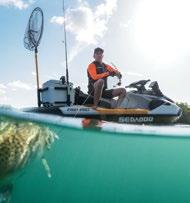






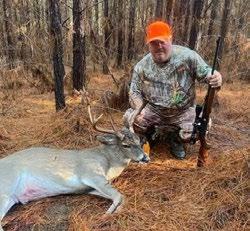
Sea-Doo.com ©2018 Bombardier Recreational Products Inc. (BRP). All rights reserved. ™ and the BRP logo are trademarks of BRP or its affiliates. Some models depicted may include optional equipment. Carefully read the operator’s guide and safety instructions. Observe applicable laws and regulations. Always wear appropriate protective clothing, including a personal flotation device and wetsuit bottoms. Riding and alcohol/drugs don’t mix. See your authorized BRP dealer fo details. You didn’t see it coming. Neither did the fish. Discover yours at our dealership Introducing the all-new FISH PRO™ The world’s first personal watercraft designed for fishing will bring you closer to the action for an experience like never before. 618 N New Warrington Rd. Pensacola, FL 32506 (850)456-6655 Pensacola Motorsports TROPHY ROOM Pensacola Motorsports When Submitting Trophy Room photos, be sure to include as much information as possible about the person and the trophy. Final Decision is made by the editorial Staff of Great Days Outdoors Magazine. Submitting a photo does not guarantee it will be published. GET FEATURED IN OUR ISSUES OF GREAT DAYS OUTDOORS WHEN YOU GIVE US YOUR BEST SHOT POST: To Facebook @GreatDaysOutdoors EMAIL: info@GreatDaysOutdoors.com [ OR ] IT'S EASY TO ENTER Photo of the Month! Simply share your great day outdoors with us! Billy Howell has both hands full of red snapper Ed Brake with a nice 7 point 80 March 2023 // GreatDaysOutdoors.com // 877.314.1237

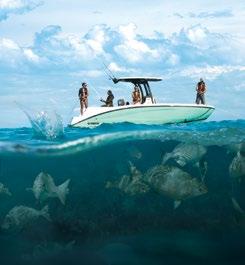


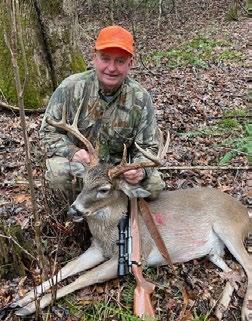
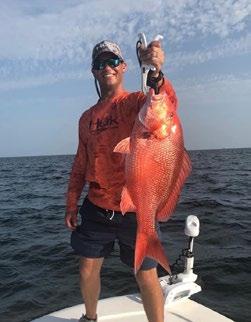
Wayne Fountain of Silverhill, AL, killed this big 10 pt that weighed 185lbs with a 20 1/2 inside spread Eric Cox Found a bay boat perfectly capable of conquering this Red Snapper. Jessie Peacock with an awesome buck JETBLASTER ® | YAMAHAWAVERUNNERS.COM This document contains many of Yamaha’s valuable trademarks. It may also contain trademarks belonging to other companies. Any references to other companies or their products are for identification purposes only, and are not intended to be an endorsement. Follow instructional materials and obey all laws. Ride responsibly, wearing protective apparel and USCG-approved personal flotation device. Always ride within your capabilities, allowing time and distance for maneuvering, and respect others around you. Never drink and ride. WaveRunner® is a Yamaha brand personal watercraft and not a generic term. This document contains many of Yamaha’s valuable trademarks. It may also contain trademarks belonging to other companies. Any references to other companies or their products are for identification purposes only, and are not intended to be an endorsement. Follow instructional materials and obey all laws. Ride responsibly, wearing protective apparel and USCG-approved personal flotation device. Always ride within your capabilities, allowing time and distance for maneuvering, and respect others around you. Never drink and ride. WaveRunner® is a Yamaha brand personal watercraft and not a generic term. THE DEEPEST BONDS START AT THE SURFACE FSH SERIES | YAMAHABOATS.COM FSH SERIES | YAMAHABOATS.COM WAKE UP WILD JETBLASTER ® | YAMAHAWAVERUNNERS.COM This document contains many of Yamaha’s valuable trademarks. It may also contain trademarks belonging to other companies. Any references to other companies or their products are for identification purposes only, and are not intended to be an endorsement. Follow instructional materials and obey all laws. Ride responsibly, wearing protective apparel and USCG-approved personal flotation device. Always ride within your capabilities, allowing time and distance for maneuvering, and respect others around you. Never drink and ride. WaveRunner® is a Yamaha brand personal watercraft and not a generic term. Pensacola Motorsports 618 N New Warrington Rd. • Pensacola, FL 32506 (850) 456-6655 www.pensacolamotorsports.com 877.314.1237 // GreatDaysOutdoors.com // March 2023 81
KID'S CORNER TROPHY ROOM
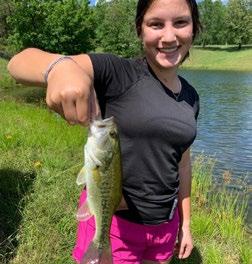
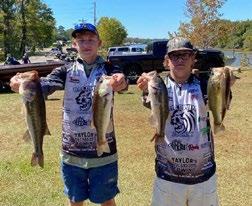
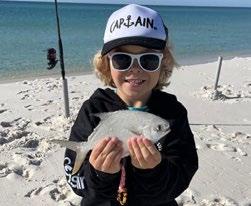
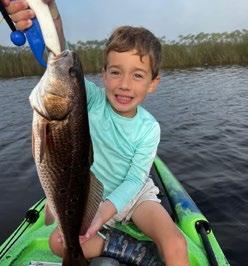 Benjamin Valcana Benjamin Valcana Tackled this dark bronze redfish from a Kayak.
Grant, 6, with his first ever Pompano
Conner lanham and Hunter Travis showing off their lunkers
AnnaBelle Jacobson AnnaBelle Jacobson with a beautiful pond largemouth.
1ST Pompano
Benjamin Valcana Benjamin Valcana Tackled this dark bronze redfish from a Kayak.
Grant, 6, with his first ever Pompano
Conner lanham and Hunter Travis showing off their lunkers
AnnaBelle Jacobson AnnaBelle Jacobson with a beautiful pond largemouth.
1ST Pompano


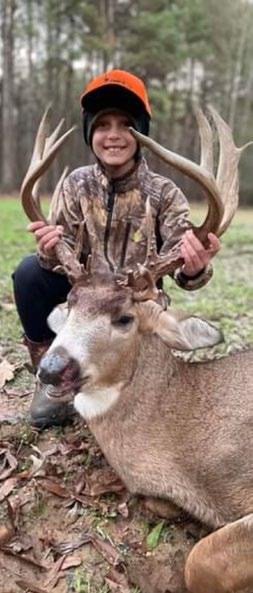
Give us your best shot! Send your submission to info@greatdaysoutdoors.com. Submitting a photo does not guarantee that it will be published. We cannot give any guarantees on when a photo will be published.
include: child's full name, age, mailing address, and any details. We need to know when, where, size (weight, points, etc.), shot or caught with what and any other meaningful information, like first time, etc.. CONTRIBUTIONS WITHOUT THIS INFO WON’T BE PUBLISHED.
Please
Jase Jones, 8, killed his first deer in Clarke County on youth weekend with a 7mm-08.
Pierce Howard with his first Tripletail
Wesley Nelson, 10 with is first deer. 220 pound killed with his 243 rifle in Brent, AL 1ST
1ST Tripletail 1ST Deer
Deer



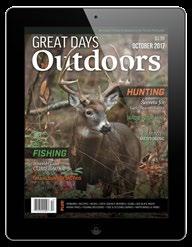





PRINT, DIGITAL OR BOTH THREE WAYS TO SUBSCRIBE... 1) CALL 877.314.1237 2) ORDER ONLINE AT GREATDAYSOUTDOORS.COM 3) MAIL IN THE COUPON (with Credit Card Number, Check or Money Order) GREAT DAYS OUTDOORS MAGAZINE PO BOX 460248 ESCONDIDO CA 92046-9801 SIGN ME UP FOR A SUBSCRIPTION FOR: 1 YEAR $30.00 2 YEARS $45.00 3 YEARS $57.00 NAME ADDRESS CITY STATE ZIP PHONE CREDIT CARD# EXP. / CID EMAIL includes tax where applicable Must send email address to receive digital copies SAVE 67% Off Newstand Price When you Subscribe for 3 years Hunting & Fishing in Alabama & the Florida Panhandle Yes, send me your e-newsletters 84 March 2023 // GreatDaysOutdoors.com // 877.314.1237
March Kicks off the Gulf Coast Wade Fishing Speckled Trout Season
 BY WILLIAM KENDY
BY WILLIAM KENDY
While March is one of the top months for pompano fishing it isn’t so bad for speckled trout. While the spec migration really under steam in late April and May the fish will start to move out of the creeks and into more open water, river mouths, grass beds and flats.
Captain Richard Rutland is a speckled trout catch expert and explained that once the water reaches the 68-70 degree level, the specs will “come to life”.
Here are some of Rutland’s speckled trout catching advice.
*Look for points along the beach where there are a series of sand bars with deeper water adjacent, as in four to eight feet.
*Look for schools of mullet, either jumping or smoking on the surface.
*Rutland prefers croakers for bait and fishes with a 7 ½ foot medium weight medium fast casting rod using 12 pound monofilament with a 4-6 foot section of 15-20 pound fluorocarbon leader and a 1/0-2/0 Owner SSW life bait hook. He free lines
with no weight and he hooks the croakers through the top lip/nose.
*”I make long casts into or around the deeper side of sand bars with enough ‘slack belly’ to give the fish a chance to swallow the bait before I set the hook,” Rutland said.
*When Rutland fishes lures he starts out in the morning with smaller topwater artificials like the Rapala Skitter-V and as the day progresses with more wave action he throws larger lures like the Heddon Super Spook. He also fishes the Slick Lure intensively with a slightly configured different outfit.
For more of Rutland expert tips on wade fishing for speckled trout go to the March 2022 issue of GDO.
Contact Information
Captain Richard Rutland
Cold Blooded Fishing
251-459-5077
www.ColdbloodedFishing.com
Advertiser Index A-Team Fishing Adventures . . . . . . . . 3 Admiral Shellfish . . . . . . . . . . . . . . 11 ADCNR-Marine . . . . . . . . . . . . . . . . 31 ADCNR-Hunting . . . . . . . . . . . . . . . . 88 Alabama Farmers CO-OP . . . . . . . . . . 23 Alabama Liquid Fertilizer . . . . . . . . . 22 Alfa . . . . . . . . . . . . . . . . . . . . . . . . 15 Bluewater Yacht Sales . . . . . . . . . . . 77 Buck’s Island Marine . . . . . . . . 18, 42 Camper City . . . . . . . . . . . . . . . . . . 67 CCA Alabama . . . . . . . . . . . . . . . . . . 38 Clutch Products . . . . . . . . . . . . . . . 39 Coast Safe & Lock . . . . . . . . . . . . . . 71 Cold Blooded Fishing . . . . . . . . . . . 45 Deep South Crane . . . . . . . . . . . . . . 43 Dixie Building Supply . . . . . . . . . . . . 3 Fiber Plastics . . . . . . . . . . . . . . . . . 69 Fishbites . . . . . . . . . . . . . . . . . . . . . 87 Geico . . . . . . . . . . . . . . . . . . . . . . . 79 GS/OB Tourism . . . . . . . . . . . . . . . . 19 Hilton’s Offshore Charts . . . . . . . . . . 75 Huntersmate Lowdown . . . . . . . . . . . 44 Hydraulic Crane . . . . . . . . . . . . . . . 78 Killer Dock . . . . . . . . . . . . . . . . . . . 65 Midway Lumber . . . . . . . . . . . . . . . 65 Mossy Oak . . . . . . . . . . . . . . . . . . . 27 National Land Realty . . . . . . . . . . . . . 5 Paradise Marine . . . . . . . . . . . . . . . . 2 Pensacola Motor Sports . . . . . . . 80-81 Pure Flats . . . . . . . . . . . . . . . . . . . . 75 Ricciardone Dentistry . . . . . . . . . . . 45 Sams . . . . . . . . . . . . . . . . . . . . . . . 30 Southern Seed & Feed . . . . . . . . . . . 26 Southeastern Pond Management . . . . 7 Test Calibration Co . . . . . . . . . . . . . . 76 War Eagle Boats . . . . . . . . . . . . . . . . . . . 57 FISHING TIP
877.314.1237 // GreatDaysOutdoors.com // March 2023 85
The Seven Habits of Seemingly Effective Turkey Hunters

a big, fat gobbler. Wrong again. You’re still thinking about being successful instead of appearing successful. If your decoy is lifelike, you will have something to pose with if the picture can be slightly blurred. I recommend disposable cameras or something cheaper. Old yard-sale Polaroids work if they come with film from the 1960s.
BY JIM MIZE
Businesses use self-help books to teach skills ranging from accounting to software. One of the most popular series is the herd of books titled, “Stuff for Dummies.” The reason they can use such an insulting title is that businessmen are usually not armed. Since turkey hunters carry guns, I decided it would be safer to emulate a different self-help book, just in case “Turkey Hunting for Dummies” struck a nerve.
The route to success, say the self-help books, involves developing good habits. The idea is that if you do the right things repeatedly, good things will happen. This never worked for me. I’ve bought lottery tickets, thrown coins in wishing wells and even tried sending money to Las Vegas with friends who oddly enough never returned it. So, I’ve instead developed a different approach. My philosophy is “if you can’t be successful, appear successful.”
To put that philosophy in a form that’s easy to share, I’ve turned it into “The Seven Habits of Seemingly Effective Turkey Hunters.”
As I explain these habits of mine, you will come to fully understand my philosophy.
1) Go early: Every turkey hunter knows this is a sport that requires an alarm clock. For some disgusting reason, turkeys wait for no man. Or woman. But my intent is not to beat the turkeys, but the other hunters. I figure if I can slip into the woods ahead of everyone else, then no one sees me hunting. That way, if I have a poor day I can deny going. Therefore, I was not unsuccessful.
Just for the record, you can accomplish the same thing by going really, really late. This has the advantage that you don’t lose sleep and still no one sees you enter the woods since they are already there. Of course, you also increase your odds of being unsuccessful.
2) Hunt alone: The reason for this should be evident. It’s not because the other person may scare the turkeys. Far from it. If that happened, you would have an excuse which can be just as good as success. No, the reason to hunt alone is so there will be no witnesses. In my case, stupidity hates company.
3) Use lifelike decoys: Many of you are thinking this is to attract
Also, you can even shoot videos after the hunt to post on social media. But you need to wait until almost dark and keep moving the decoy around a lot. Or lay it on the ground in the shadows.
4) Stop in where turkey hunters gather: If you’re fortunate enough to hunt in a state with check stations, or any other place where successful hunters gather to brag on their hunting prowess, stop in and linger. Stand as close to one of the gobblers as possible. Better yet, be seen handling it and pointing out its spurs and beard. With any luck, someone may mistake the bird as being yours. If you can get in a picture with the successful hunter, you can use Photoshop to crop him out later.
5) If you must hunt with someone, pick a person who can learn from you: I have a lot of trouble finding people like this. But if you can find someone who meets this criteria, invite them hunting. The idea is that they will get in the vicinity of a gobbler and then bungle it. This does two things. First, it keeps your partner from posing with a gobbler so big you’ll never hear the end of it. Second, the bird has to run somewhere. Maybe he’ll come to you. Then you can bungle it. But at least if you both screw up, neither of you is likely to spill the beans.
6) Hunt without a lot of gear: Perhaps the most important item to leave at home is your camera. That way, if you have no decoy or other hunter’s gobbler to pose with, your stories will always include the line, “. . . and of course, I forgot to bring my camera.” Then it’s just your word against theirs.
7) Envision a successful hunt: This may be the most critical point in appearing successful. As you sit in your blind, imagine a gobbler flying down off the roost, steadily responding to your every yelp and cluck, slipping stealthily through the brush, spotting your decoy, and finally, strutting directly into the path of your shot. When none of this happens, at least you will have gotten your story straight.In any event, if you nod off in your blind you will at least have better dreams. Who knows? Maybe your dreams will make a good story.
So, in the event you’re the sort of hunter I am, you may decide that just as camo clothes make the man or woman, appearance of success makes the hunter.Now, if you’ll excuse me, I have to glue fake covers on my copy of Turkey Hunting for Dummies.Jim Mize finds humor to be an essential hunting skill. You can find his awardwinning books of humor on Amazon or get autographed copies at www.acreektricklesthroughit.com.
A GREAT DAY OUTDOORS
86 March 2023 // GreatDaysOutdoors.com // 877.314.1237

fishbites.com 877.314.1237 // GreatDaysOutdoors.com // March 2023 87
ALABAMA TURKEY HUNTERS
WHEN CAN YOU USE A TURKEY DECOY?
n SPECIAL YOUTH HUNT: SATURDAY & SUNDAY THE WEEK PRIOR TO THE OPENING OF SPRING SEASON. (DECOYS ALLOWED)
n SPECIAL DISABLED HUNT: ONE DAY PRIOR TO ALL REGULAR SEASON OPENING DAYS. PARTICIPANTS MUST MEET MEDICAL REQUIREMENTS OF REGULATION 220-2-.109(2)(D). (DECOYS ALLOWED)
n ZONE 1: SEASON - MARCH 25 - MAY 8 – DECOYS ALLOWED STARTING APRIL 4
n ZONE 2: SEASON - APRIL 1 - MAY 8 – DECOYS ALLOWED STARTING APRIL 11
n ZONE 3: SEASON - MARCH 25 - MAY 8 – DECOYS ALLOWED STARTING APRIL 4
FOR COMPLETE DETAILS ON THE SEASON AND BAG LIMITS FOR THE 2023 TUKEY SEASON SCAN THE QR CODE.


GAME CHECK IS MANDATORY FOR EVERY TURKEY HUNTER
All hunters are required to report their turkey harvest using Game Check, which will help the Alabama Department of Conservation and Natural Resources effectively manage wildlife for generations.
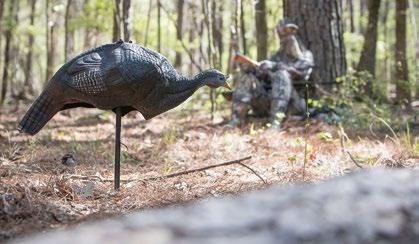
Search OUTDOOR AL
your app
on
store!
your harvest at OutdoorAlabama.com/GameCheck or by using the official ADCNR mobile app Outdoor AL
Check
SCAN THE CODE




































 This one is headed for the grill—wahoo are among the best tasting of all pelagic species .
This one is headed for the grill—wahoo are among the best tasting of all pelagic species .



























 BY DAVID STRICKLAND
BY DAVID STRICKLAND









 BY KIRSTIE PIKE
BY KIRSTIE PIKE









 Schools of various baitfish are often found near piers .
Schools of various baitfish are often found near piers .





 BY DAVID STRICKLAND
BY DAVID STRICKLAND




 White Dutch, Yuchi)
White Dutch, Yuchi)










 BY JOHN E. PHILLIPS
BY JOHN E. PHILLIPS



 BY WILLIAM KENDY
BY WILLIAM KENDY



 Here are a variety of squirrel calls to consider using . Left to right: a bellows-style barker; a squirrel squealer; and the two pieces of the plastic screw and paddle to make the sounds of a squirrel cutting nuts
Here are a variety of squirrel calls to consider using . Left to right: a bellows-style barker; a squirrel squealer; and the two pieces of the plastic screw and paddle to make the sounds of a squirrel cutting nuts















 Alabama’s great outdoors provides abundant opportunities
exploration via canoes, kayaks or hiking .
Alabama’s great outdoors provides abundant opportunities
exploration via canoes, kayaks or hiking .







 Photos by Ed Mashburn
Photos by Ed Mashburn












 Photos by Ed Mashburn
Photos by Ed Mashburn
































 Benjamin Valcana Benjamin Valcana Tackled this dark bronze redfish from a Kayak.
Grant, 6, with his first ever Pompano
Conner lanham and Hunter Travis showing off their lunkers
AnnaBelle Jacobson AnnaBelle Jacobson with a beautiful pond largemouth.
1ST Pompano
Benjamin Valcana Benjamin Valcana Tackled this dark bronze redfish from a Kayak.
Grant, 6, with his first ever Pompano
Conner lanham and Hunter Travis showing off their lunkers
AnnaBelle Jacobson AnnaBelle Jacobson with a beautiful pond largemouth.
1ST Pompano












 BY WILLIAM KENDY
BY WILLIAM KENDY



